The TCL C6K is a television for those who want to combine gaming and watching movies with good contrast, without spending a fortune. Thanks to the VA panel with Mini-LED backlighting, blacks are deep and contrast is high, so evening screenings look truly spectacular. Additionally, it offers decent brightness, which, combined with Dolby Vision, makes movies take on a cinematic character. The fluidity of the image is also significant – the 144Hz refresh rate does wonders for sports and dynamic games, and gamers get a full package of extras: VRR, ALLM, HDMI 2.1, HGiG, and even a 240 Hz mode in PC. On a daily basis, the television is powered by Google TV, which offers a ton of apps and the Gemini AI voice assistant, making operation convenient and flexible. It's also worth mentioning the sound – support for Dolby Atmos and DTS gives the impression that the equipment is ready not just for gaming. As is often the case, there are a few things that could be improved. The backlighting in difficult scenes can lose details or wash out blacks, and Polish translations in the menu can be so clumsy that one has to wonder what they actually mean. Despite this, the overall performance holds up very well, and given the price, the TCL C6K could be one of the more interesting choices for someone looking for a versatile television for movies, sports, and games. Especially when a good promotion comes along – and when TCL traditionally polishes up the details in updates.
- Matching (Score)
- Our verdict
- TV appearance
- Where to buy
- Contrast and black detail
- HDR effect quality
- Factory color reproduction
- Color reproduction after calibration
- Smoothness of tonal transitions
- Image scaling and smoothness of tonal transitions
- Blur and motion smoothness
- Console compatibility and gaming features
- Input lag
- Compatibility with PC
- Viewing angles
- TV efficiency during daytime
- Details about the matrix
- TV features
- Apps
- Playing files from USB
- Sound
TCL C6K vs Samsung QN80F 100"
Direct compare
Check the best price offer:
Samsung QN80F 100"C6K / C69K / Q6C
Available screen sizes: 100”
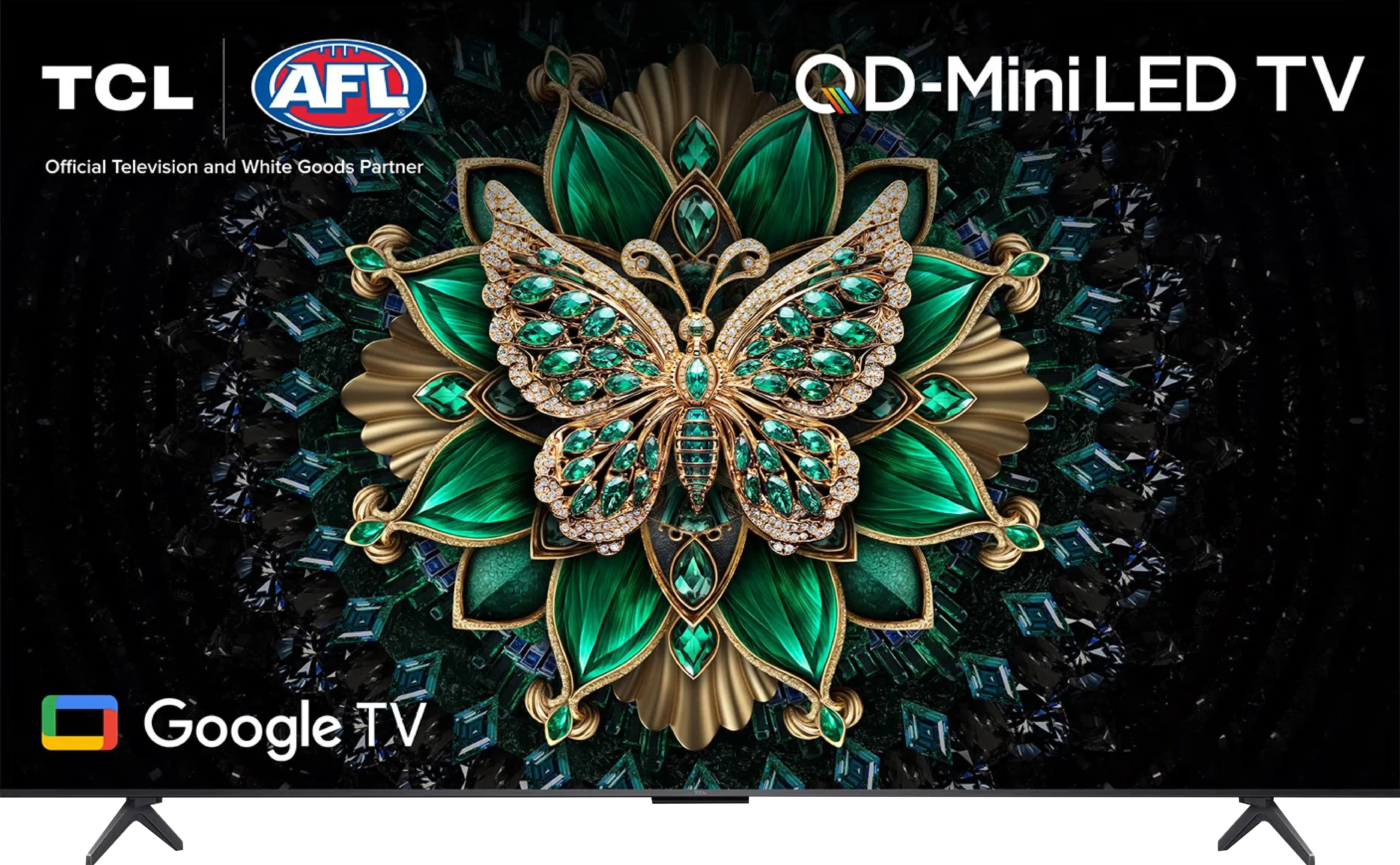
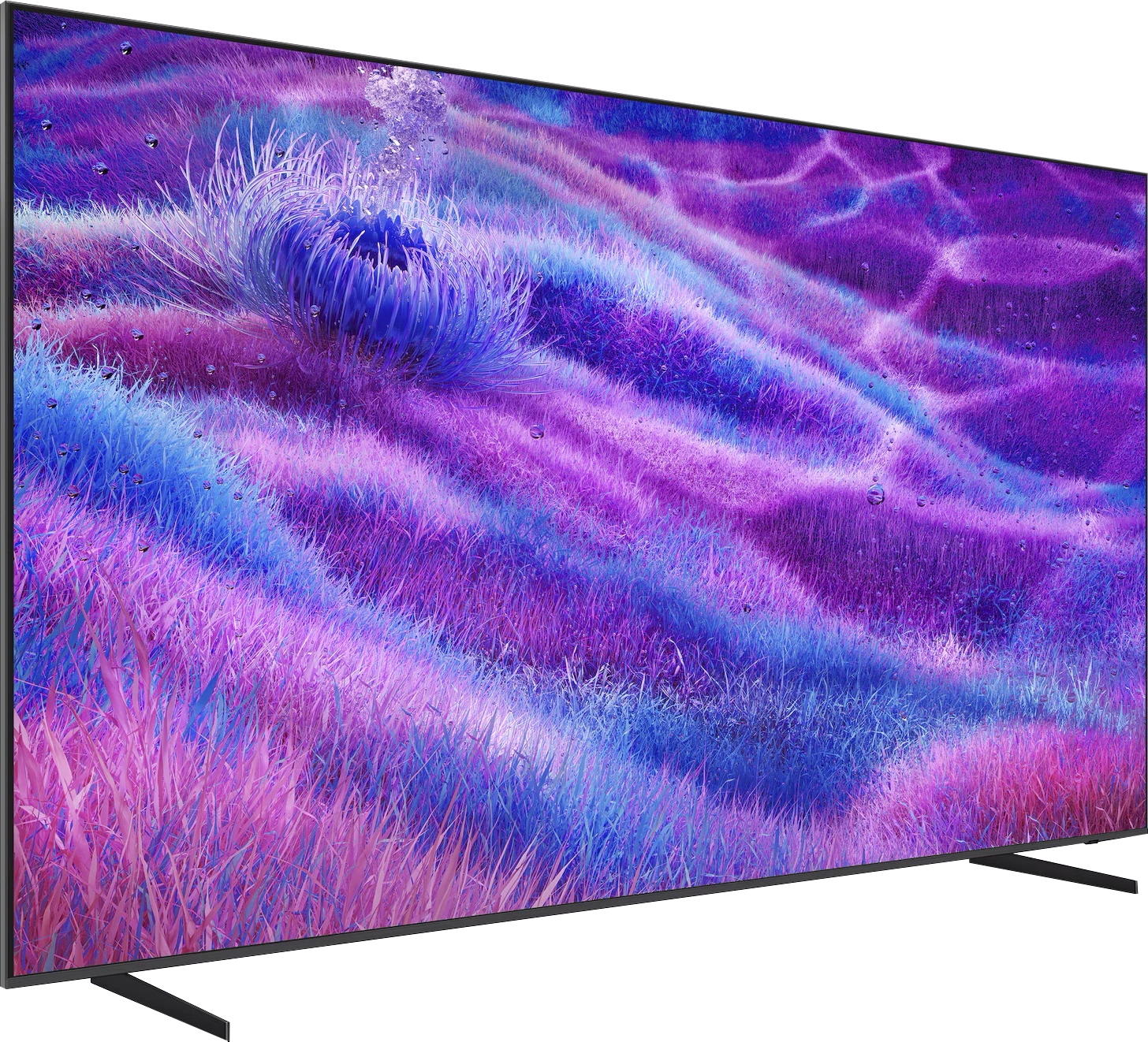
Panel type: LCD VA
Resolution: 3840x2160
System: Google TV
Model year: 2025
Complete the survey to find out the result

Panel type: LCD VA
Resolution: 3840x2160
System: Tizen
Model year: 2025
Complete the survey to find out the result

Overall rating
7.1
7.4
Movies and series in UHD quality
6.7
7.2
Classic TV, YouTube
6.6
7.0
Sports broadcasts (TV and apps)
6.3
6.6
Gaming on console
8.4
8.6
TV as a computer monitor
8.6
8.6
Watching in bright light
6.4
7.0
Utility functions
7.0
7.7
Apps
9.6
8.7
Sound quality
6.5
6.7
Complete the survey to find out what fits your preferences
Advantages
Very good contrast and black level: VA panel and MINI-LED backlighting
Good motion fluidity: High refresh rate of 144Hz
Decent panel brightness
Many features for gamers: VRR, ALLM, HDMI 2.1, HGiG
Additional mode for PC gamers: 240Hz
Google TV system with a wide selection of apps
Support for multiple HDR formats including Dolby Vision
Support for Dolby Atmos and DTS
Very attractive price
HDR brightness up to 1300 nits
Good black levels - MiniLED with a VA panel
Fast 144 Hz panel and 4 HDMI 2.1 ports
Many features for gamers: VRR, ALLM, and great gamebar
Low input lag (<10 ms)
Fast Tizen operating system with SmartThings support
Supports Dolby Atmos
Disadvantages
Managing the backlighting could be better
Language errors in the system
Poor viewing angles
Modest number of dimming zones for a 100" screen
No Dolby Vision and HGIG
Our verdict
QN80F is the first "eighty" from Samsung available in a 100-inch version (previously "only" 98 inches 😉) and it is also the model that has made it into the series with Mini LED backlighting. And it must be admitted that at this scale, it performs really well. Although the number of dimming zones is not impressive considering such a huge screen, the contrast and blacks are at a solid level, and combined with high brightness, the TV can deliver great experiences in HDR movies and series. The 144 Hz panel ensures smooth motion, and the full set of features for gamers – VRR, ALLM, or Game Motion Plus – makes it hard to define the QN80F as anything other than a screen designed for both console and PC. Additionally, there is fast and stable Tizen, which provides access to all key applications and can act as a smart home hub thanks to the proprietary SmartThings app. Of course, there are some shortcomings – there is no Dolby Vision, no USB recording, and the viewing angles at 100 inches can be really problematic. Mini LED still has its limitations, so those expecting absolutely perfect blacks need to keep this in mind. On the other hand, given the current prices of OLEDs in such sizes, it is hard to talk about real competition.
QN80F is a versatile TV, well-crafted, and providing a lot of satisfaction on a daily basis. Looking at the history of this series, one can be sure that as soon as it appears at reasonable promotions, it will be one of the most interesting offers in its class. And if Samsung refines the minor shortcomings with updates, this 100-inch beast could prove truly difficult to beat just like its smaller variants.
TV appearance
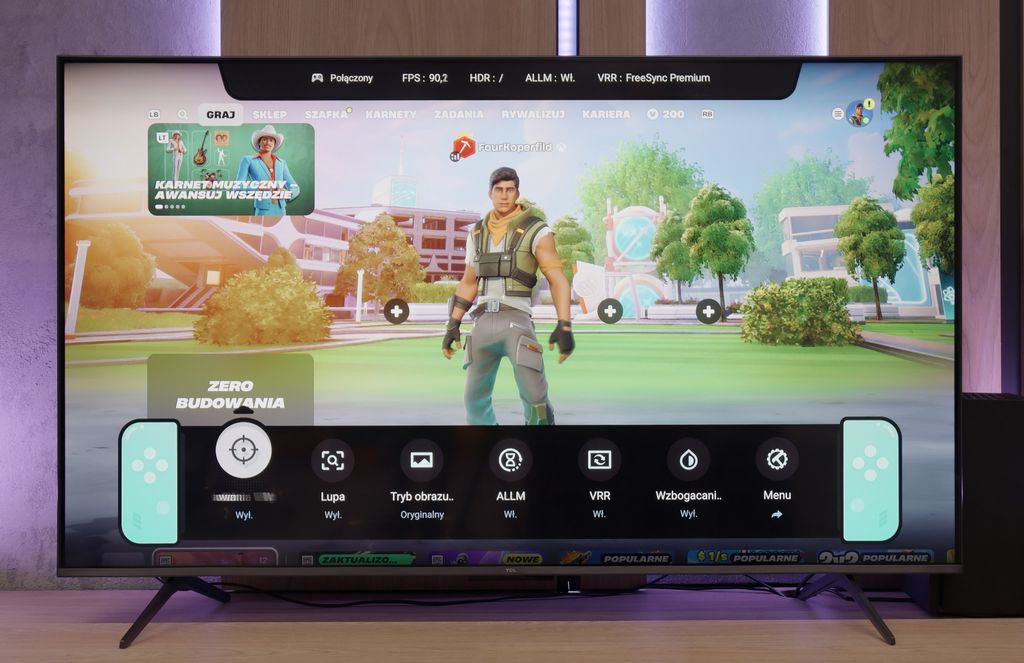
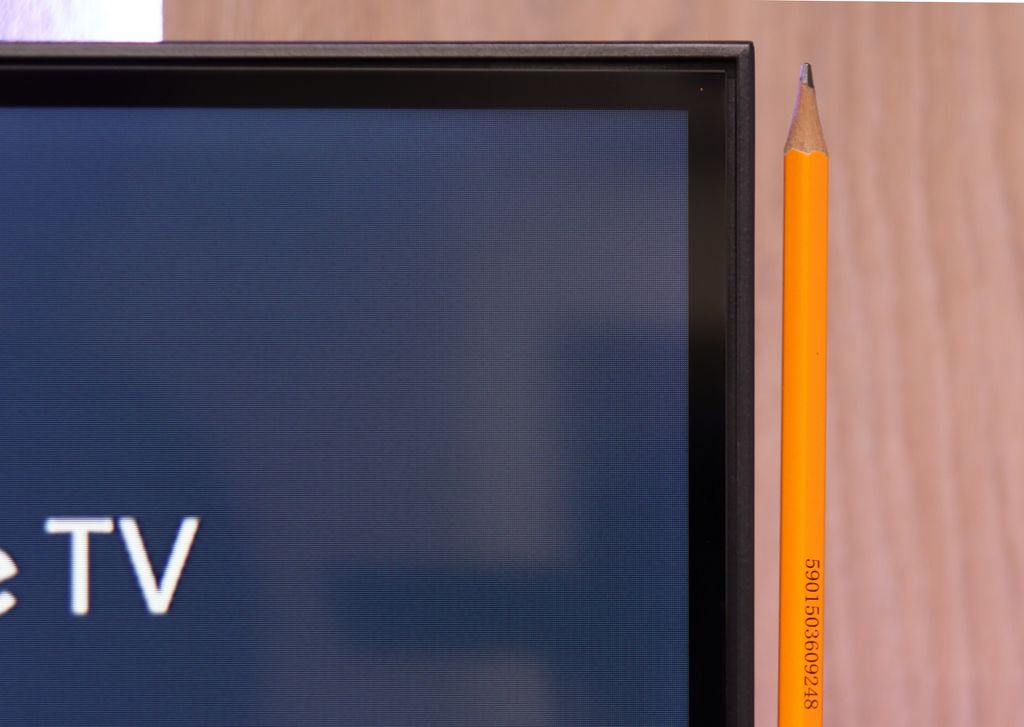
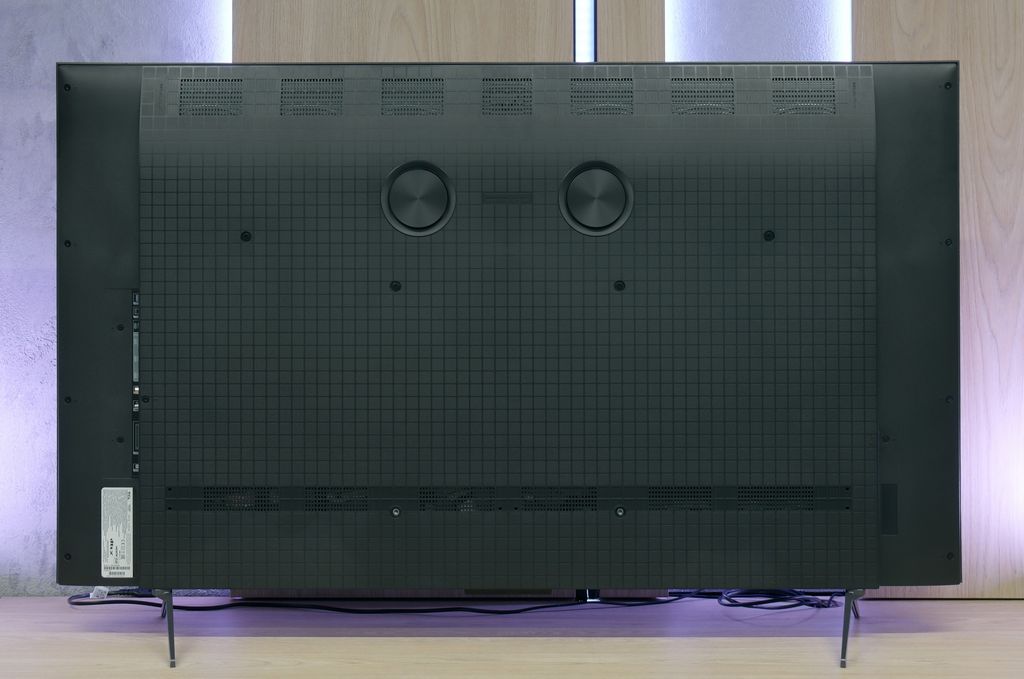
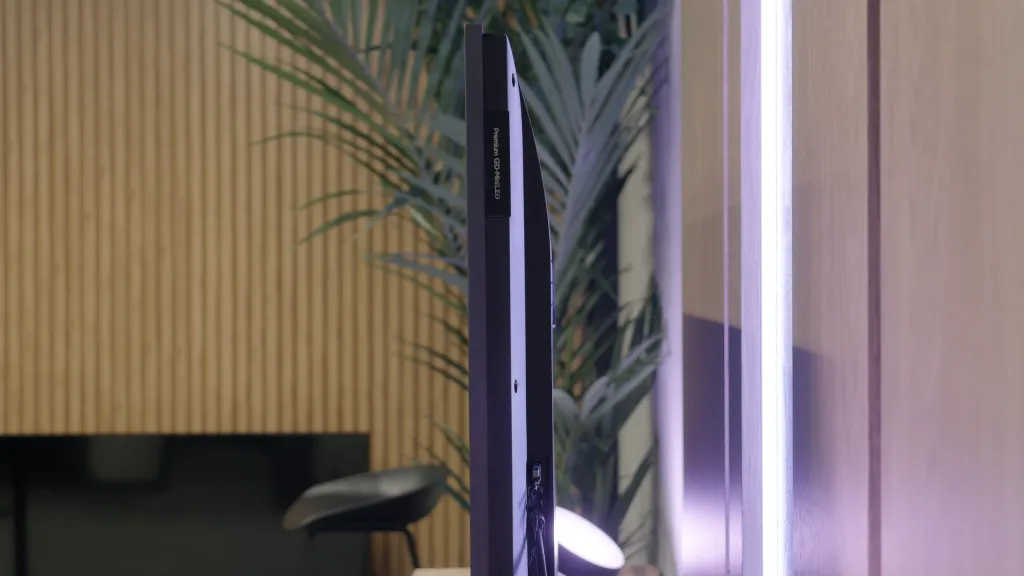
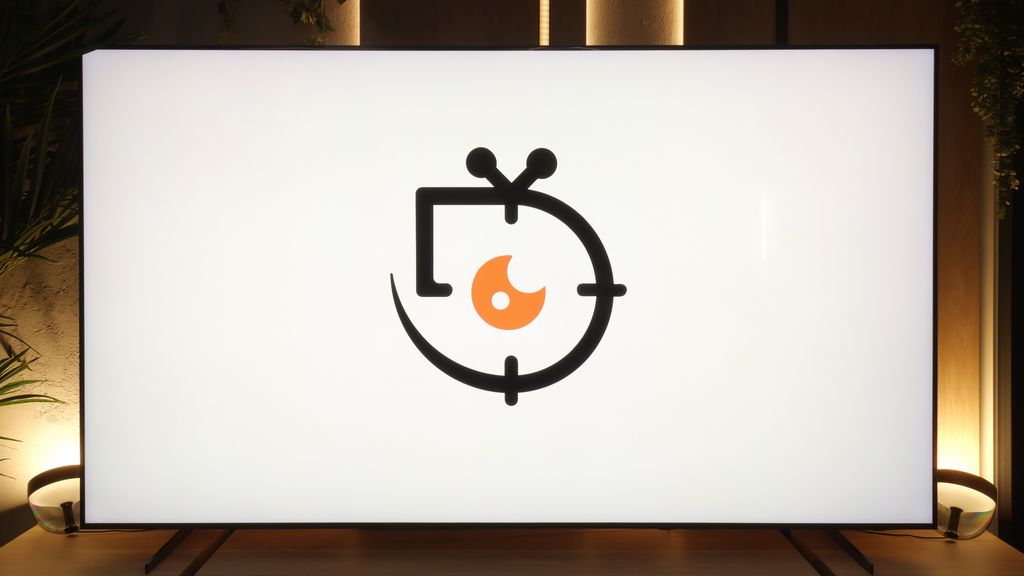

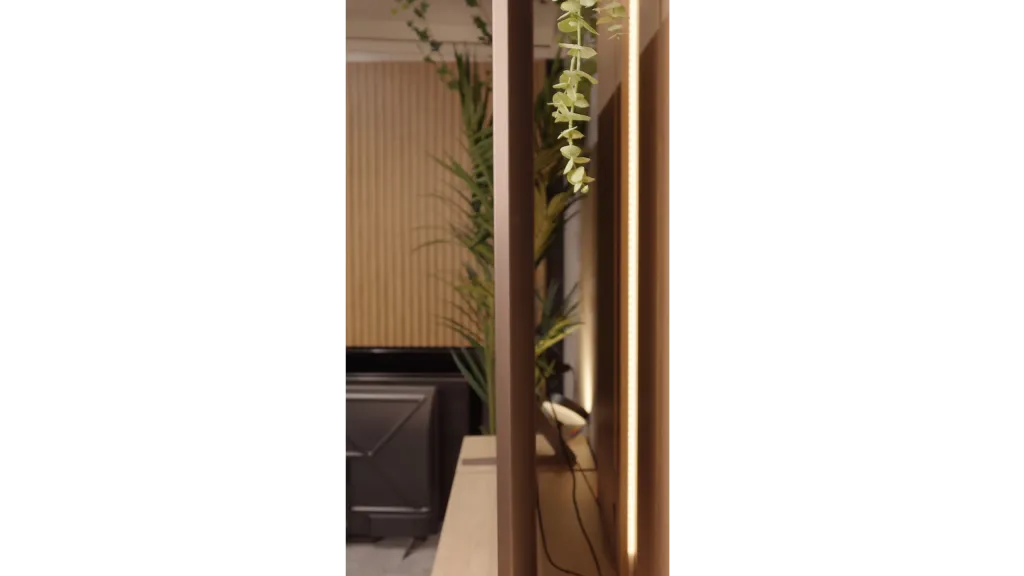
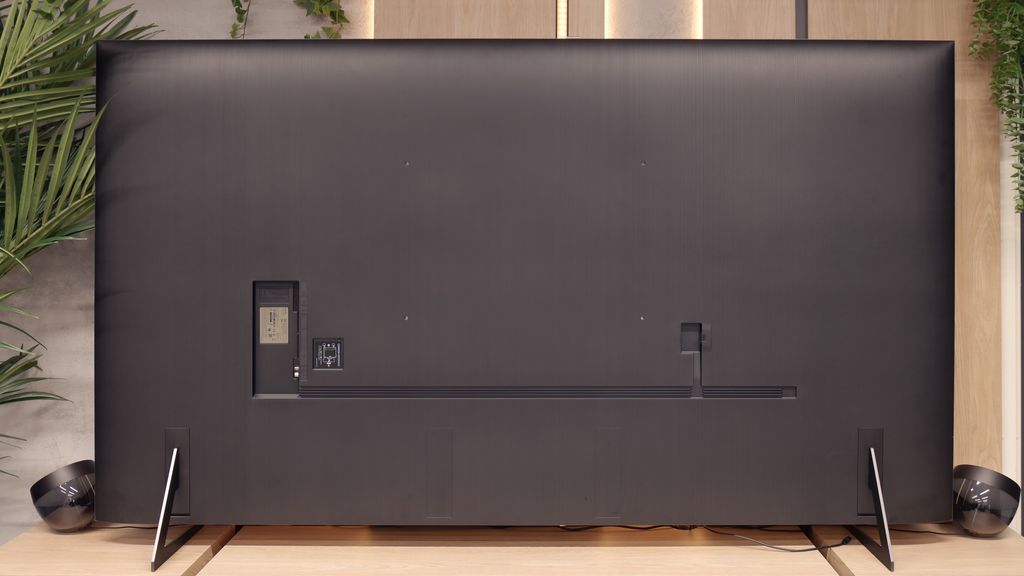
Contrast and black detail
7.3/10
7.1/10
Local dimming function: Yes, number of zones: 180 (10 x 18)
Local dimming function: Yes, number of zones: 120 (10 x 12)
Contrast:

Result
114,000:1

Result
17,300:1

Result
16,200:1

Result
9,900:1

Result
4,850:1

Result
94,400:1

Result
12,650:1

Result
31,750:1

Result
7,350:1

Result
3,000:1
Halo effect and black detail visibility:
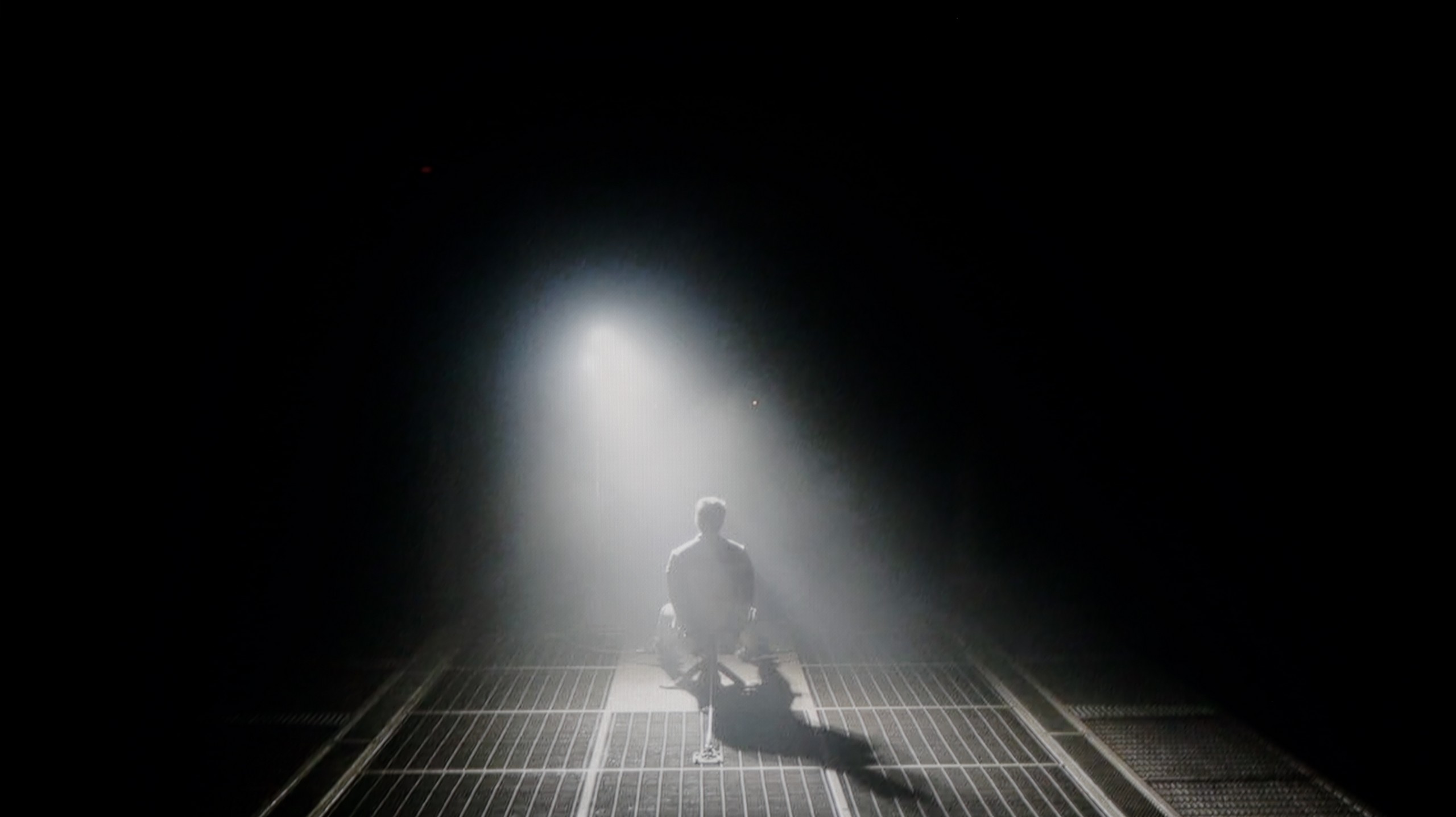
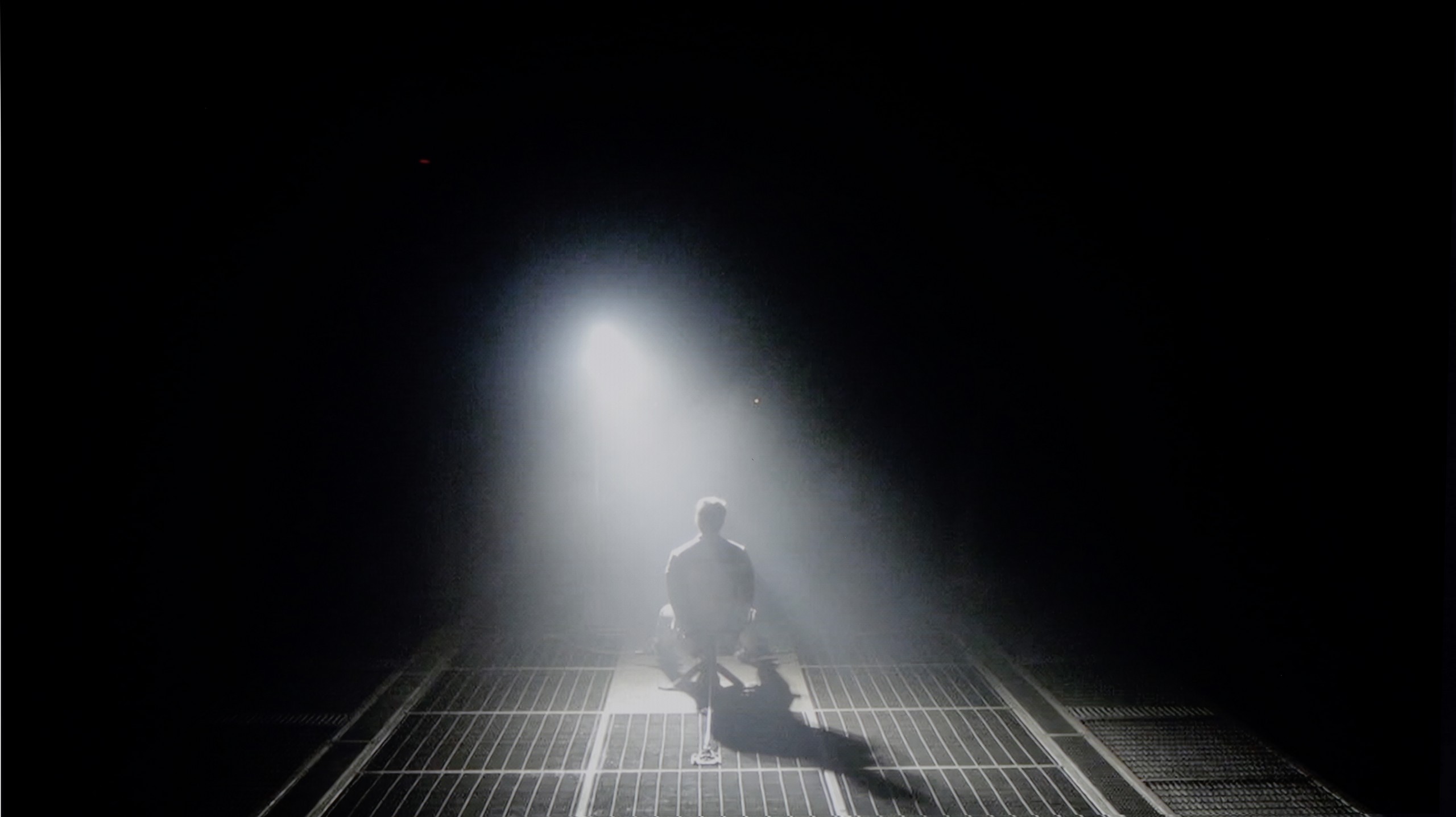
The TCL C6K is based on a VA matrix, more specifically HVA produced by TCL CSOT, which already provides a solid native contrast of 6000–7000:1 without the use of local dimming. However, the real strength of this model is the Mini-LED backlighting with the ability to dim individual zones. In the tested 55-inch version, we counted about 180 of them, and as the diagonal increases, this number naturally rises. For a television in this price segment, the contrast is truly impressive. In simpler film scenes, such as excerpts from "Oblivion," it performs excellently, and shots completely filled with black make a great impression. Of course, due to the nature of Mini-LED technology, it’s not always possible to avoid issues – in more challenging frames with many bright details, halo effects or too strong dimming of some elements appear (regardless of local dimming settings). Nevertheless, the contrast can be considered a strong point of the C6K.
The QN80F belongs to the NeoQLED family, which consists of Samsung TVs based on mini-LED technology. In practice, this means local dimming zones that are intended to improve contrast and light separation. In the case of the 100-inch version, we have a VA panel combined with about 120 zones – a rather modest result for such a large surface, although it must be acknowledged that it still translates into noticeably better results than in smaller screens. In its best cinematic scenes, the contrast can be really strong – five-digit values are not an exaggeration, and the lights separate from the blacks in a way that makes a significant impression at first glance. However, you cannot deceive physics. Since such a huge screen must "work" with a relatively small number of zones, there are moments when the TV struggles with image control. For example, when a multitude of bright, small elements appears on a black background in the final scene of a movie, there are visible halos around them. This shows that even with a refined algorithm, mini-LED still has its limitations. Generally, however, the contrast can be considered very good, and in everyday viewing, most users will be fully satisfied. One just has to remember that this model will not provide absolute blacks, known from OLEDs. The same goes for any LCD TV.
HDR effect quality
4.9/10
6.5/10
Luminance measurements in HDR:

Result
612 nit

Result
202 nit

Result
424 nit

Result
144 nit

Result
587 nit

Result
1150 nit

Result
721 nit

Result
875 nit

Result
377 nit

Result
849 nit
Scene from the movie “Pan” (about 2800 nits)


Scene from the movie “Billy Lynn” (about 1100 nits)
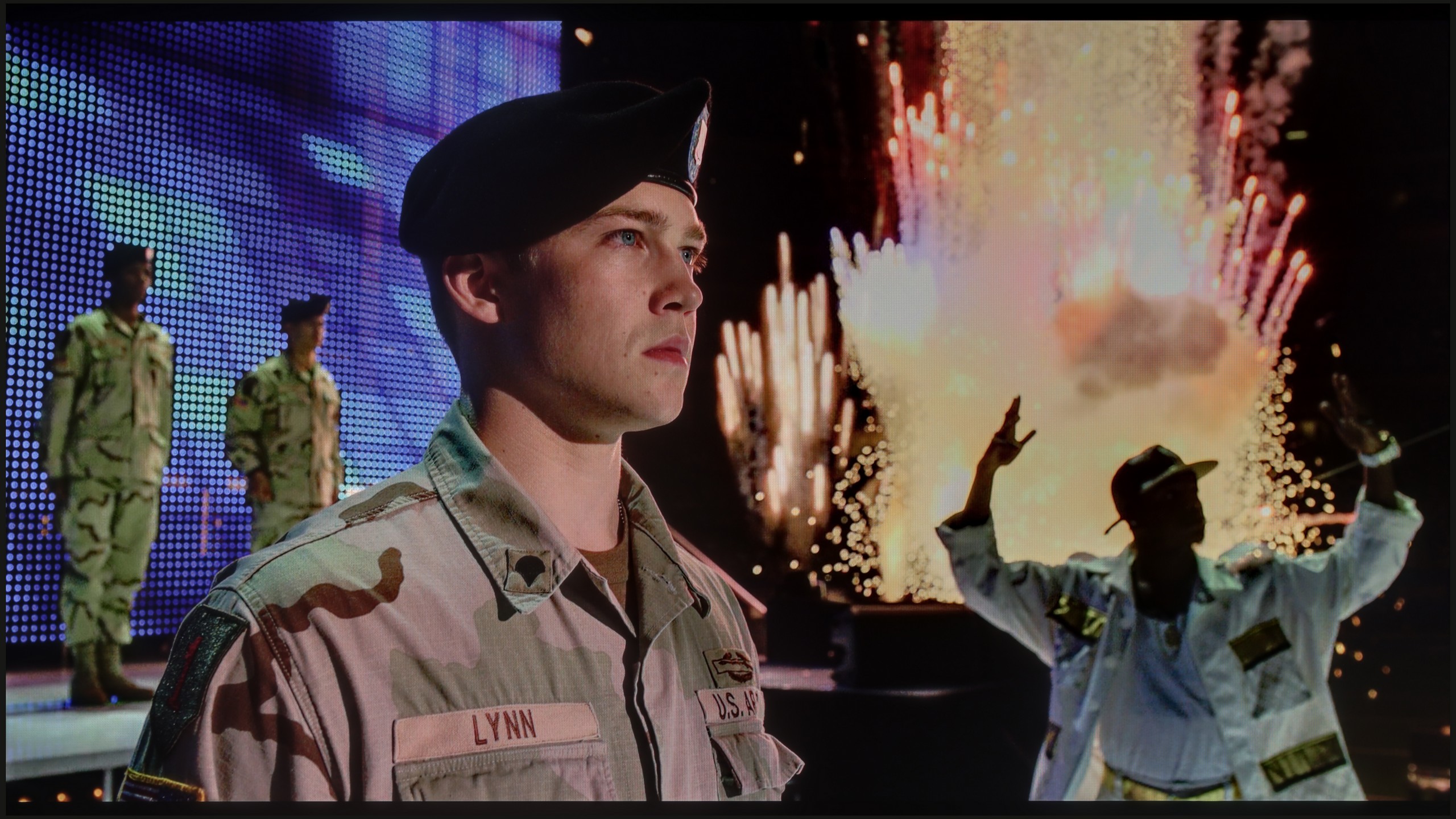
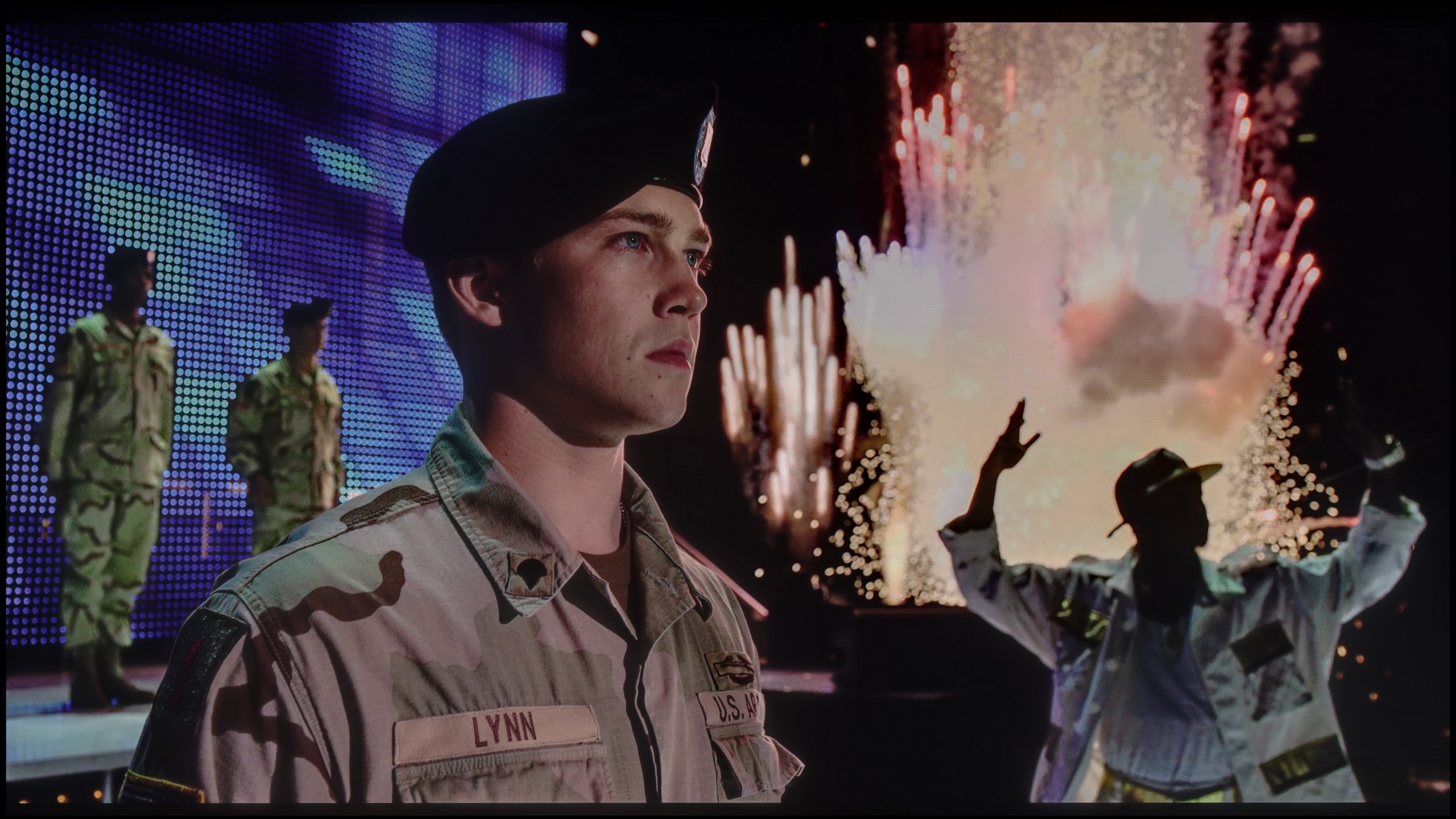
Static HDR10


Dynamic: Dolby Vision
Dynamic: HDR10+


HDR luminance chart:
Samsung QN80F 100"
HDR luminance
TCL C6K
HDR luminance
TCL C6K is a moderately bright TV that can showcase its full potential under the best cinematic conditions – the maximum brightness is around 600 nits. In scenes with large, intense light sources, the HDR effect can be really satisfying, providing a sense of cinematic brilliance. However, it should be noted that when managing the backlighting zones, there are situations where some elements become dimmed and sometimes can even become barely visible. It is clear that there is a lack of proper algorithm optimization here, although looking at the technical parameters in this price range, the design itself performs very well.
When it comes to HDR in Filmmaker mode, the QN80F can make a great first impression on you. Our lab tests showed that under the best conditions, the TV can achieve brightness exceeding 1200–1300 nits. These are truly remarkable results, which make HDR effects in many films look incredible. The TV is simply bright enough that it doesn’t need to artificially adapt the picture – bright parts of scenes have the right "power" and actually look like a light source. Of course, the lab is one thing, and everyday viewing is another. In practice, during movie scenes, brightness usually oscillates between 700–1100 nits. These are still great values that, in most cases, give a strong sense of realism and make the lights on screen really capable of dazzling you. The problem arises in exceptionally challenging sequences, where, like almost every mini-LED, it reveals its limitations. A good example is Sicario 2: scenes with helicopters in the night sky look much weaker, and the lights lose intensity, dropping to around 370 nits, making it hard to speak of serious admiration. This leads us to the topic of colors. Although we are dealing with a QLED, the coverage of the DCI-P3 color palette is about 90%. This is fairly average for a quantum dot TV. In practice, this means that some colors may appear less saturated than we would expect, especially in demanding HDR productions.
Factory color reproduction
5/10
6/10


Factory Mode
After calibration


Factory Mode
After calibration
This year's TCL televisions feature a Filmmaker mode, and it must be admitted that it is definitely the best choice straight out of the box. This is the mode we recommend for everyday watching of movies and series. Unfortunately, as is often the case, the best doesn't mean perfect. In the case of SDR content, the image was too warm because the red was strongly emphasized in the white balance. On the other hand, with HDR content, we had the opposite impression – the image became cooler than it should have been due to excess blue. Additionally, the brightness characteristic sometimes led to highlights being blown out. In practice, this resulted in quite noticeable color test inaccuracies that are hard to accept in a mode advertised as "by the creators."
Samsung QN80F performs best in Filmmaker mode, which is designed to faithfully convey the creators' intentions. And indeed – it is a mode in which the TV showcases its potential. But let’s not deceive ourselves, it is far from perfect. In SDR content, a problem with white balance became apparent. Slight deficiencies in green and a clear excess of red caused the screen to take on a pinkish hue. You don’t even need measuring tools to notice this – in everyday viewing, the slightly shifted color palette could be quite noticeable, and in color checker tests, colors were even "jumping" out of their reference fields. With HDR content, the situation was a bit better, as the white balance was closer to ideal, but another problem emerged – brightness management. The EOTF curve often caused the image to become too bright, which spoiled the perception of contrast, and in dynamic scenes led to a slight "flickering" in the reception. We actually already mentioned this in the sections about black levels and HDR. The good news, however, is that Samsung provides a lot of tools for improvement. The QN80F allows for really detailed calibration, including a 20-point white balance. And since the manufacturer left us so many options, we decided to see how the TV would perform after solid corrections.
Color reproduction after calibration
7.5/10
8.3/10
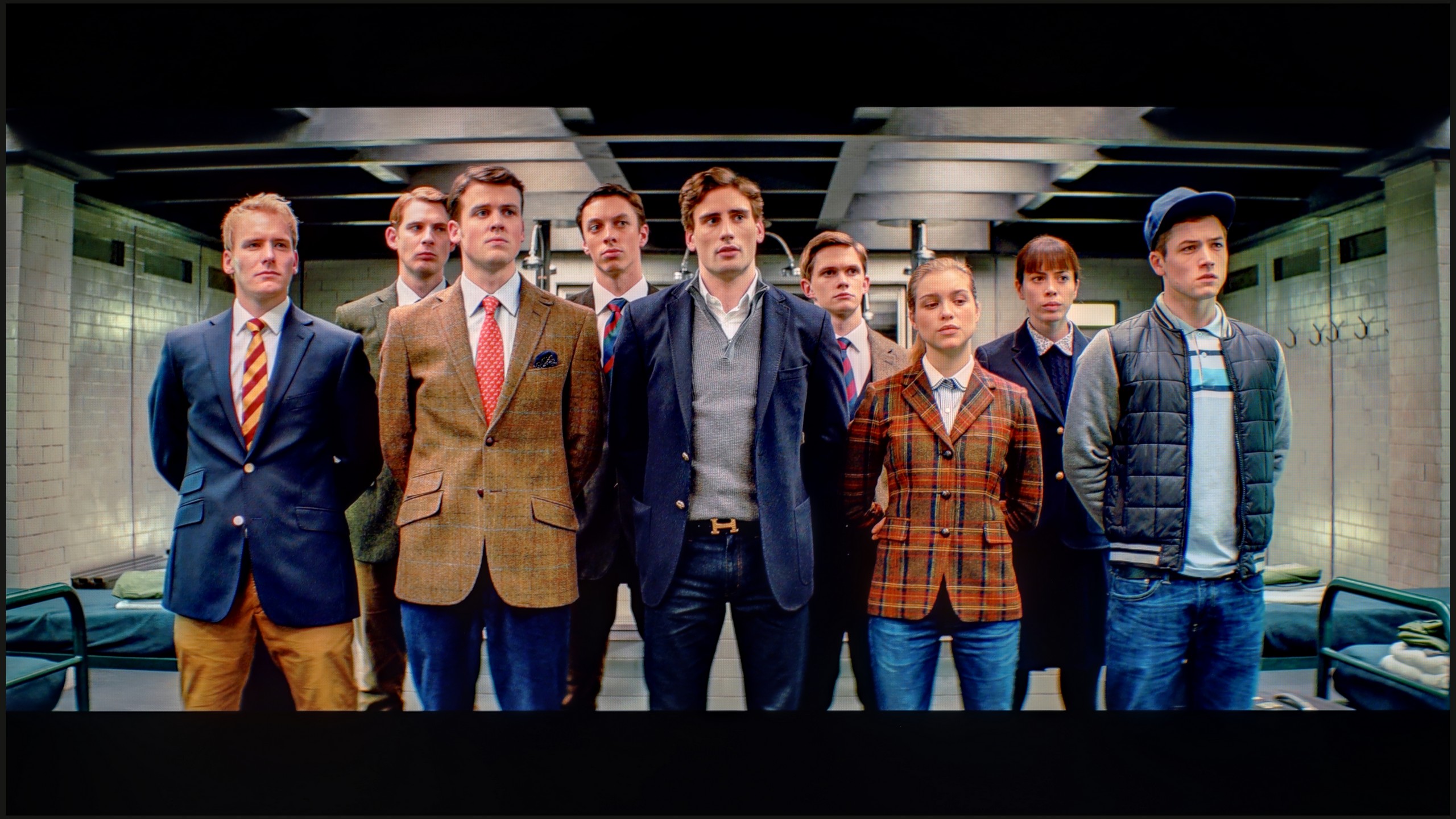
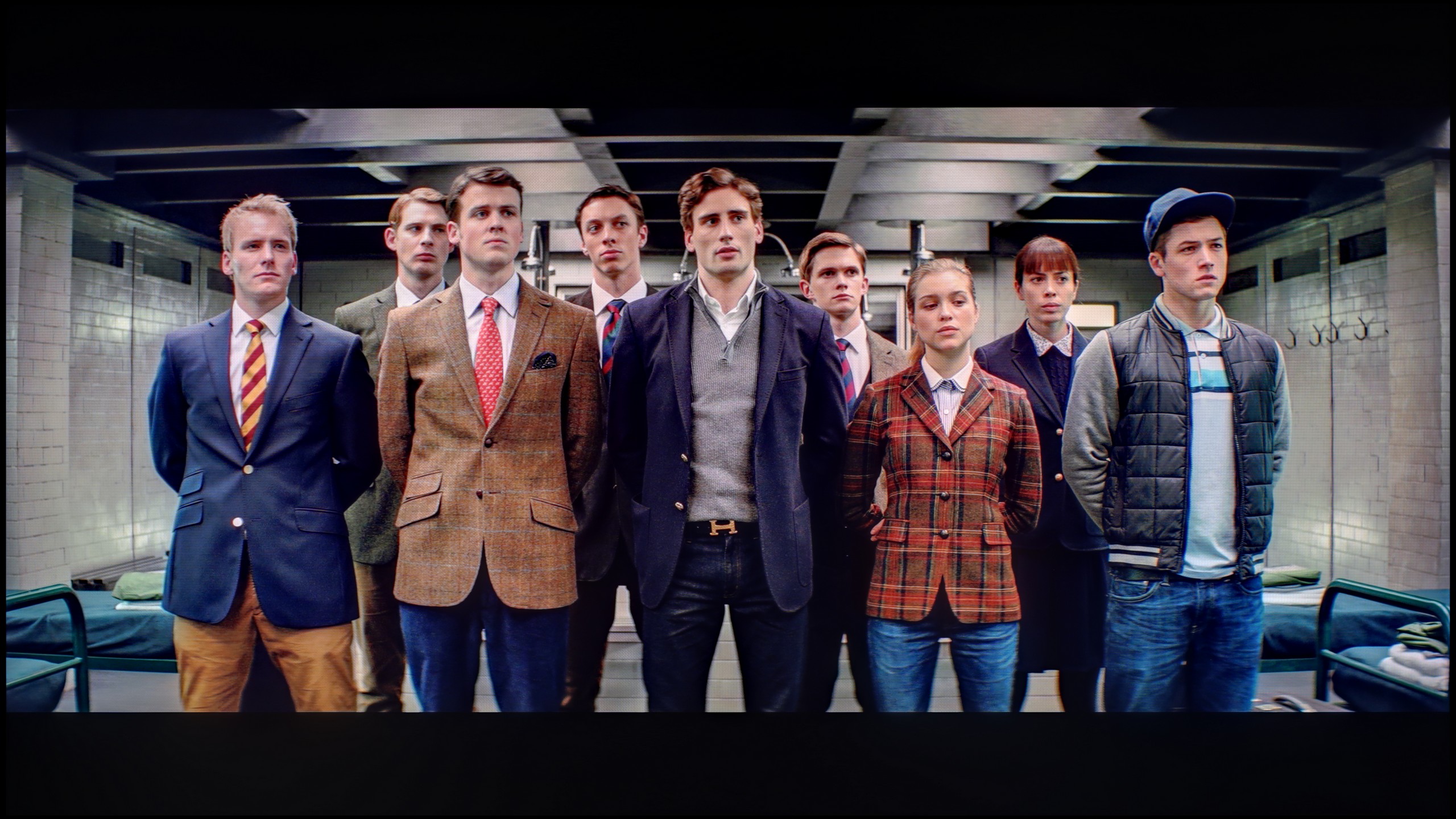


Thanks to the white balance correction, it was possible to significantly reduce the C6K's tendency to distort colors, which resulted in a very good final outcome. After calibration, we will no longer observe the effect of excessive warming of scenes in SDR or overly cooling the image in HDR. However, it is worth taking a closer look at the brightness characteristics. In SDR content, there are few complaints – the image looks really good, especially in older movies, TV shows, or materials from YouTube. This is much worse for HDR content. Analysis of the EOTF curve suggests that everything is fine, but in practice (EOTF in films), the limitations of the construction become apparent. The TV tends to overly brighten the smallest parts of the frame, and in other situations, it can dim the entire scene too much. The effect of calibration is therefore evident, and in terms of color, the C6K has gained quite a lot, but certain limitations arising from local dimming and, in fact, its management by the C6K simply cannot be overcome.
After calibrating the QN80F, it immediately showed that it is capable of much more. The pink tint that could previously spoil the reception has disappeared, and the white balance finally looks as it should – natural and without excessive deviations. The colors have gained depth, and the image has become more saturated and consistent, making movies simply more enjoyable to watch. It's a bit like removing a light haze from the screen – suddenly everything seems sharper and clearer. Brightness management has also improved. The television no longer gets lost so easily in dynamic changes, and the EOTF graph shows that the curve tracking is much more stable. Of course, there are no miracles – the limited number of zones still means that small, bright elements can be slightly brightened, but that is due to the construction itself, not the settings. After this adjustment, the QN80F feels like a more mature piece of equipment, and watching movies finally provides the satisfaction one expects from a television even in the higher class.
Smoothness of tonal transitions
9.5/10
9/10
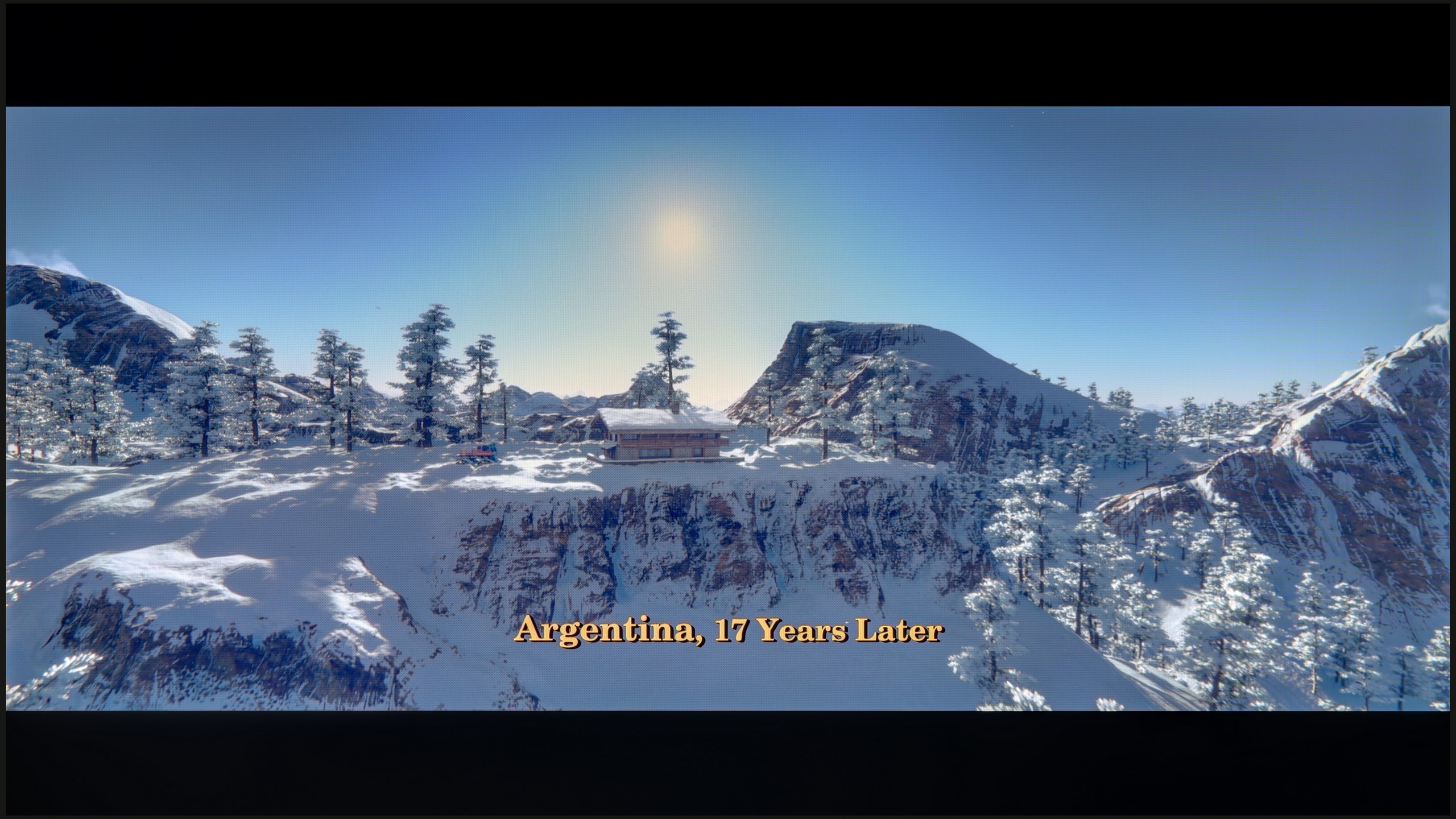
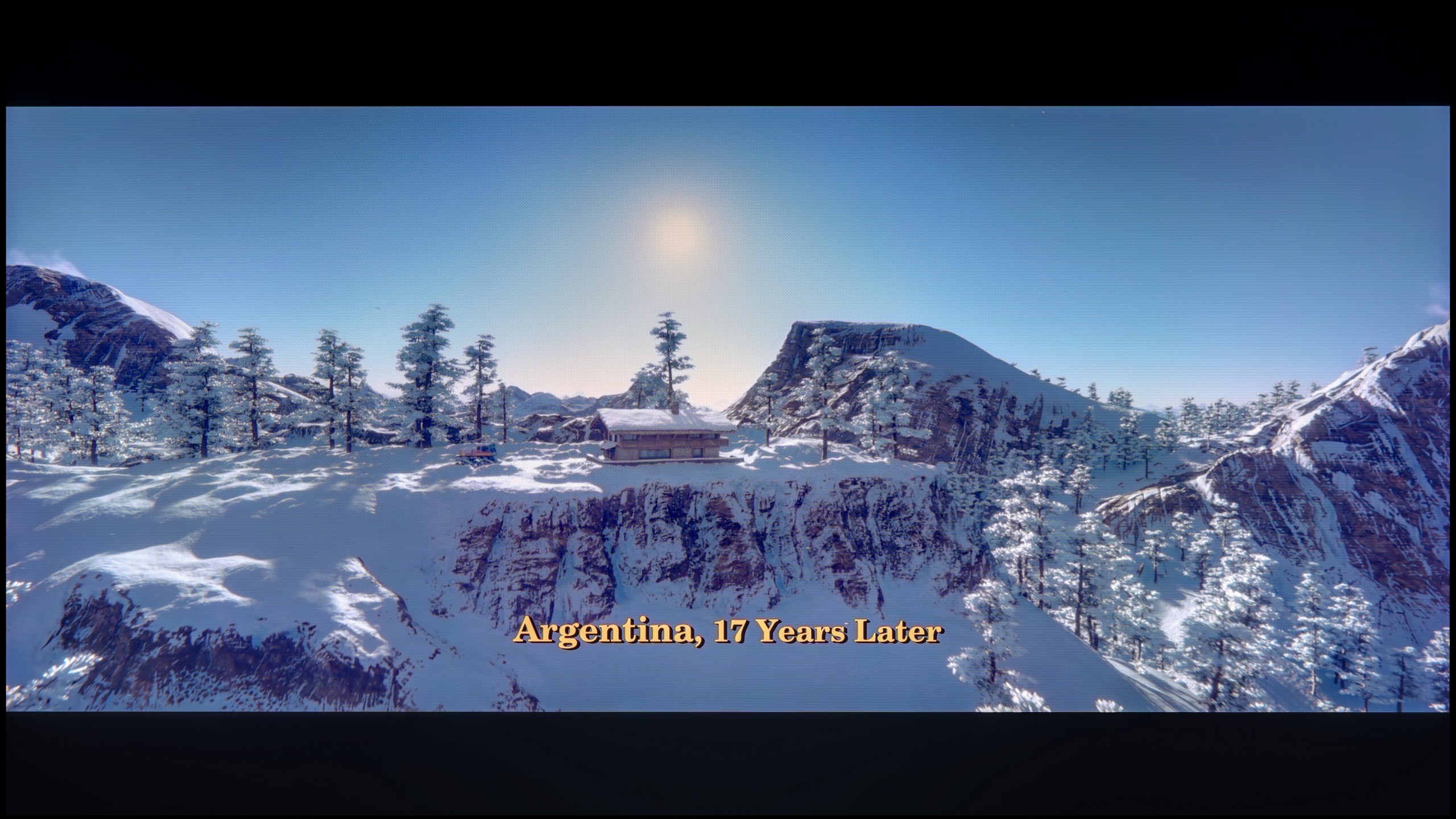


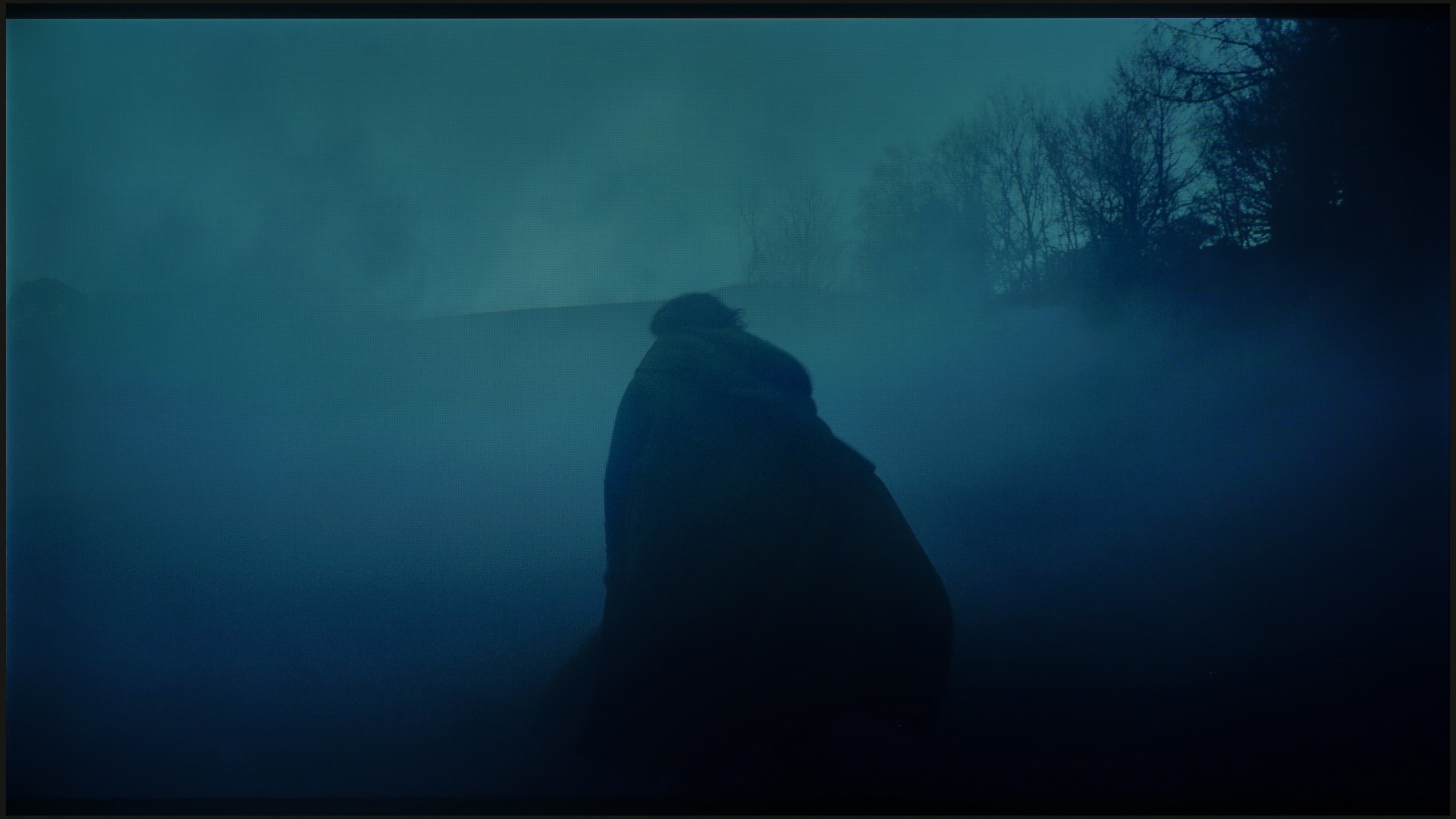
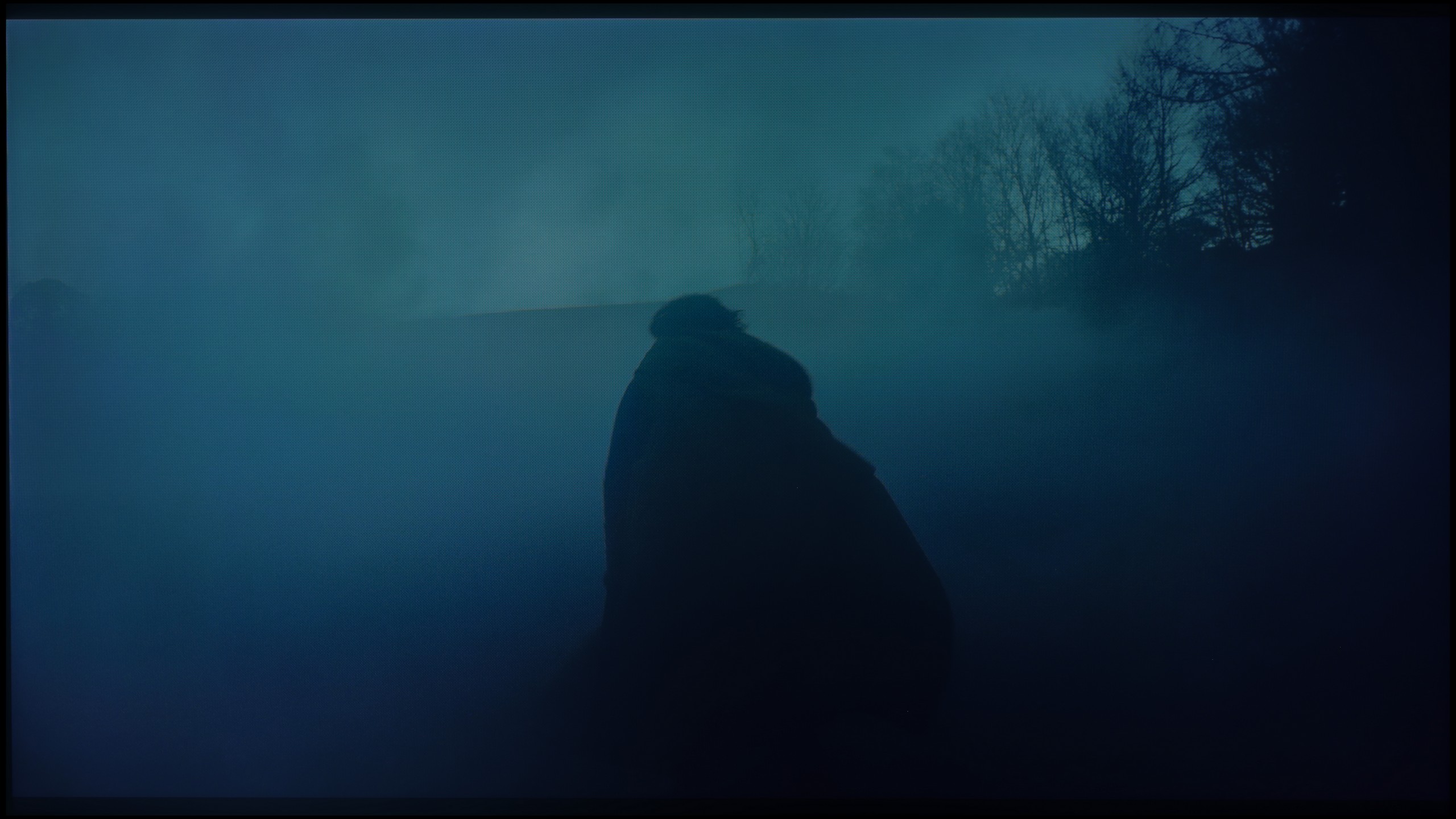
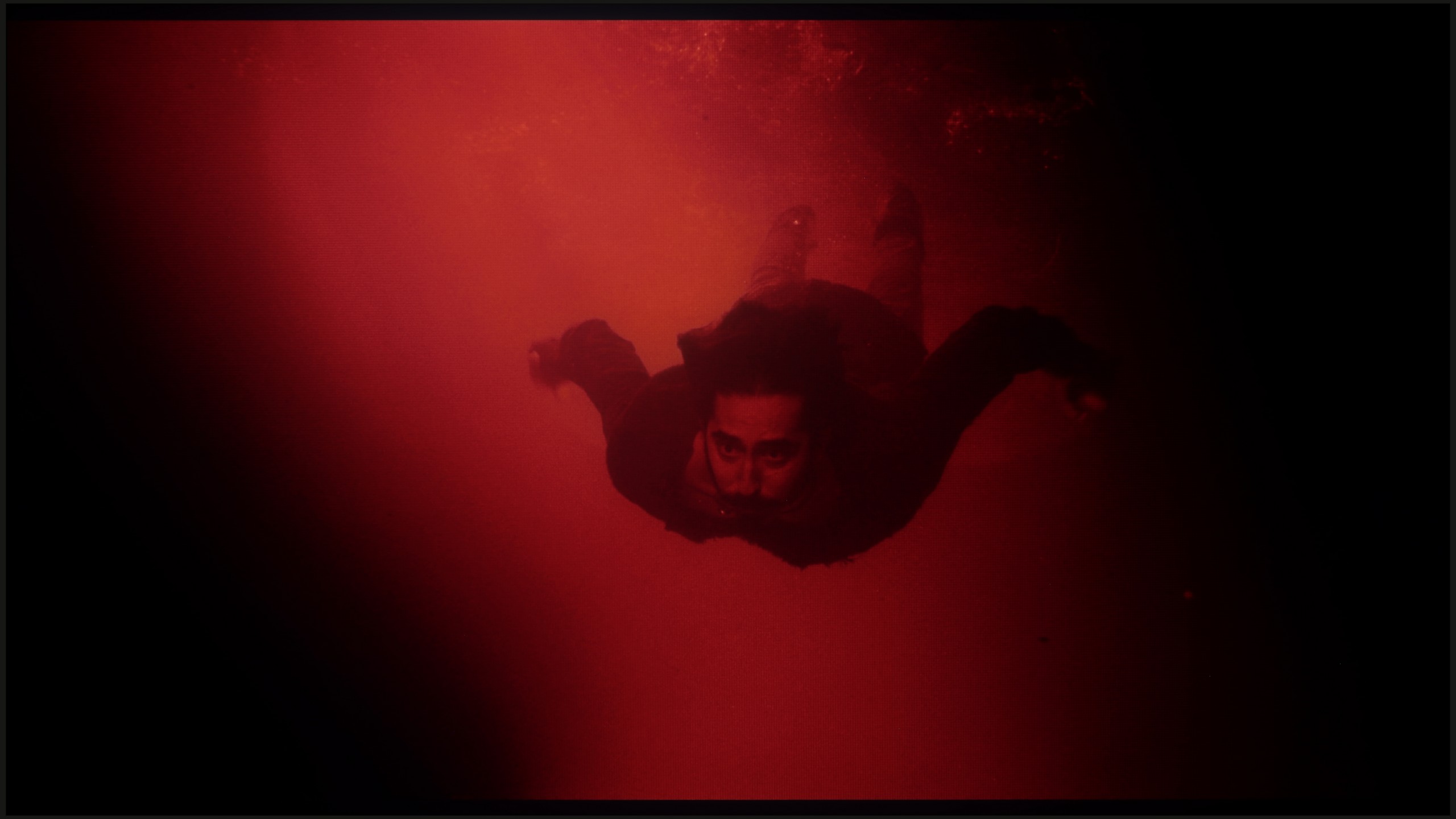
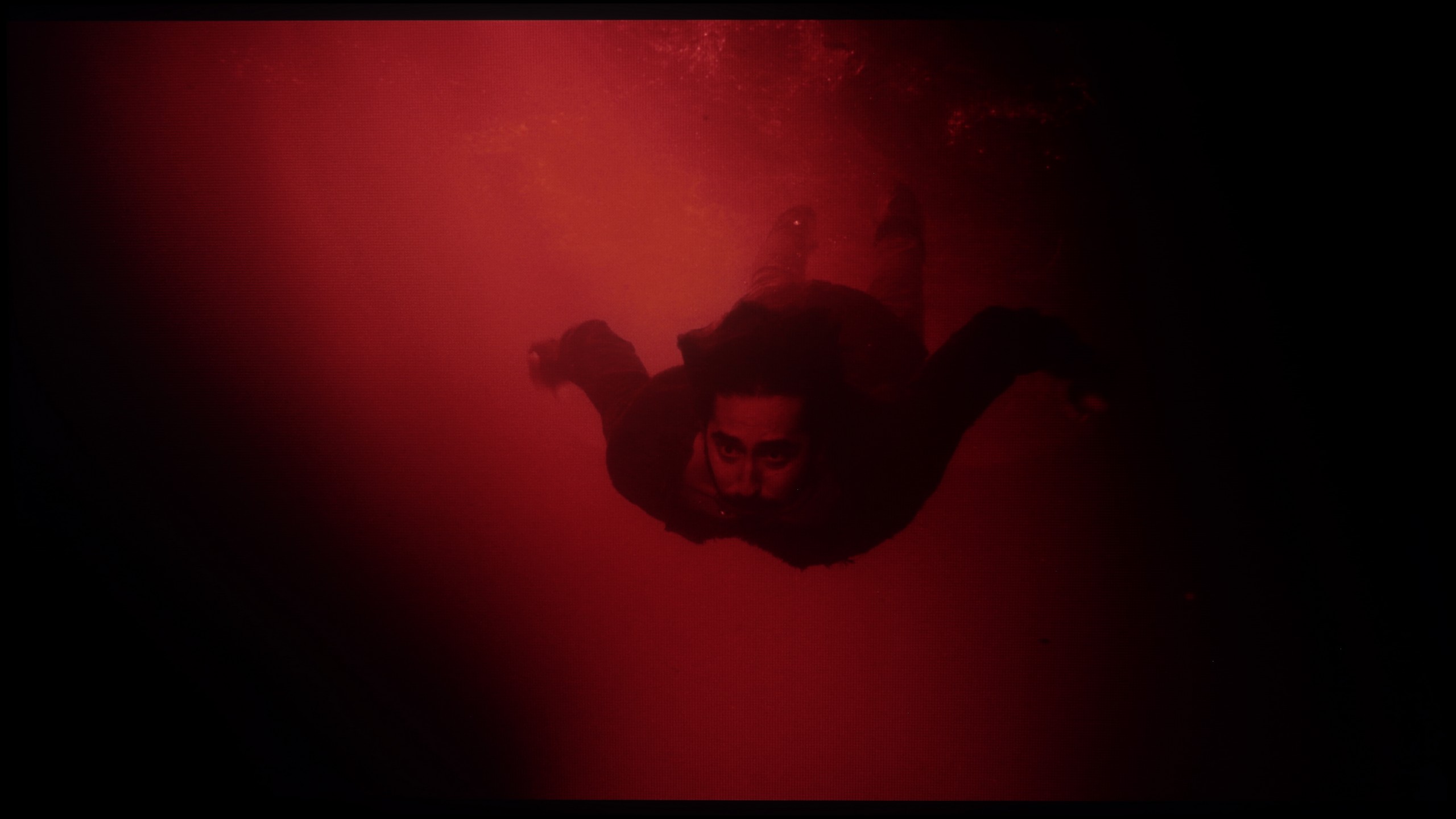




The transitions between colors in the C6K are very smooth, and it's hard to find any banding. The image looks natural, and any minor imperfections can only be noticed on bright test patterns – and that with really careful viewing. In everyday use, the effect is simply great, and one can confidently say that in this category, the C6K performs exceptionally well.
In terms of the smoothness of tonal transitions, meaning blending colors into one another, the QN80F performs really well. The color gradients are smooth, the image doesn’t break into artificial bands, and the sky or vast shadowed surfaces look as they should – without strange spots or disturbances. It particularly excels in scenes with dark tones, where many televisions tend to lose their way and generate ugly artifacts. Here, everything remains coherent and clear. Indeed, in the brightest areas, one can sometimes notice slight banding, but that’s a detail that only very discerning viewers analyzing the image frame by frame will catch. In everyday use, there is practically nothing to complain about. The QN80F provides a sense of assurance that tonal transitions will not be a distracting element.
Image scaling and smoothness of tonal transitions
5/10
7/10
Smooth transition function
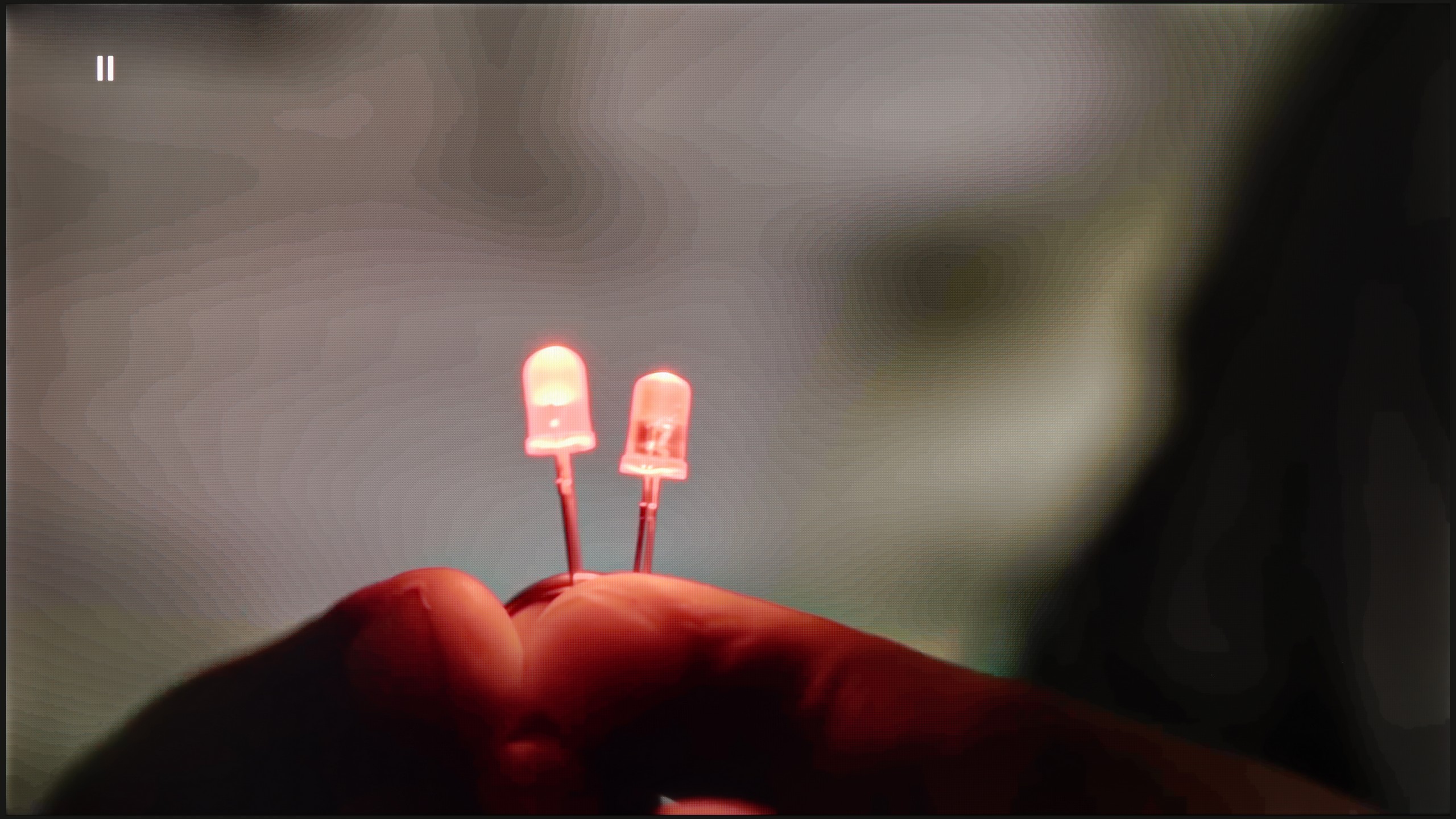
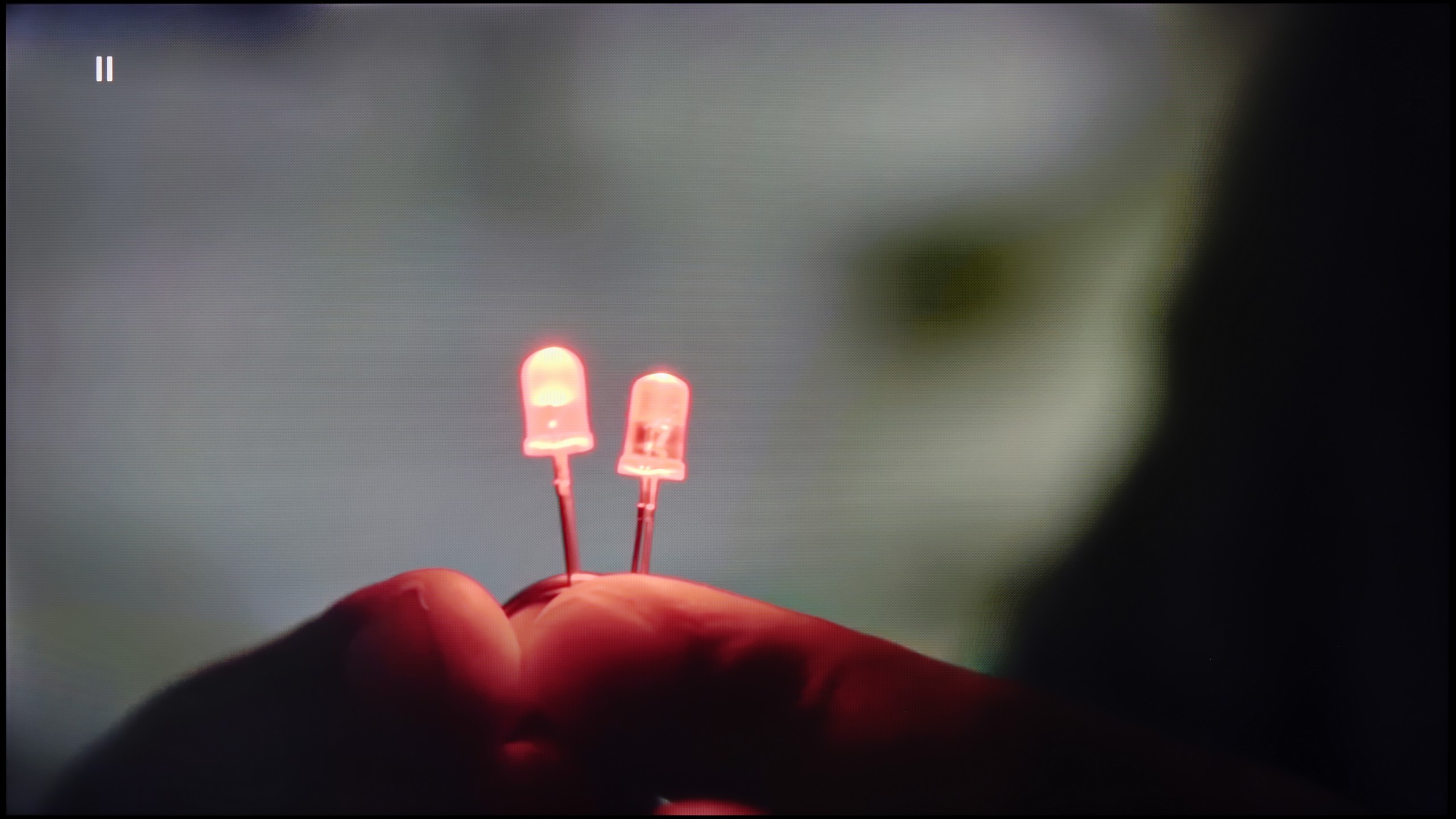
Image without overscan on the SD signal

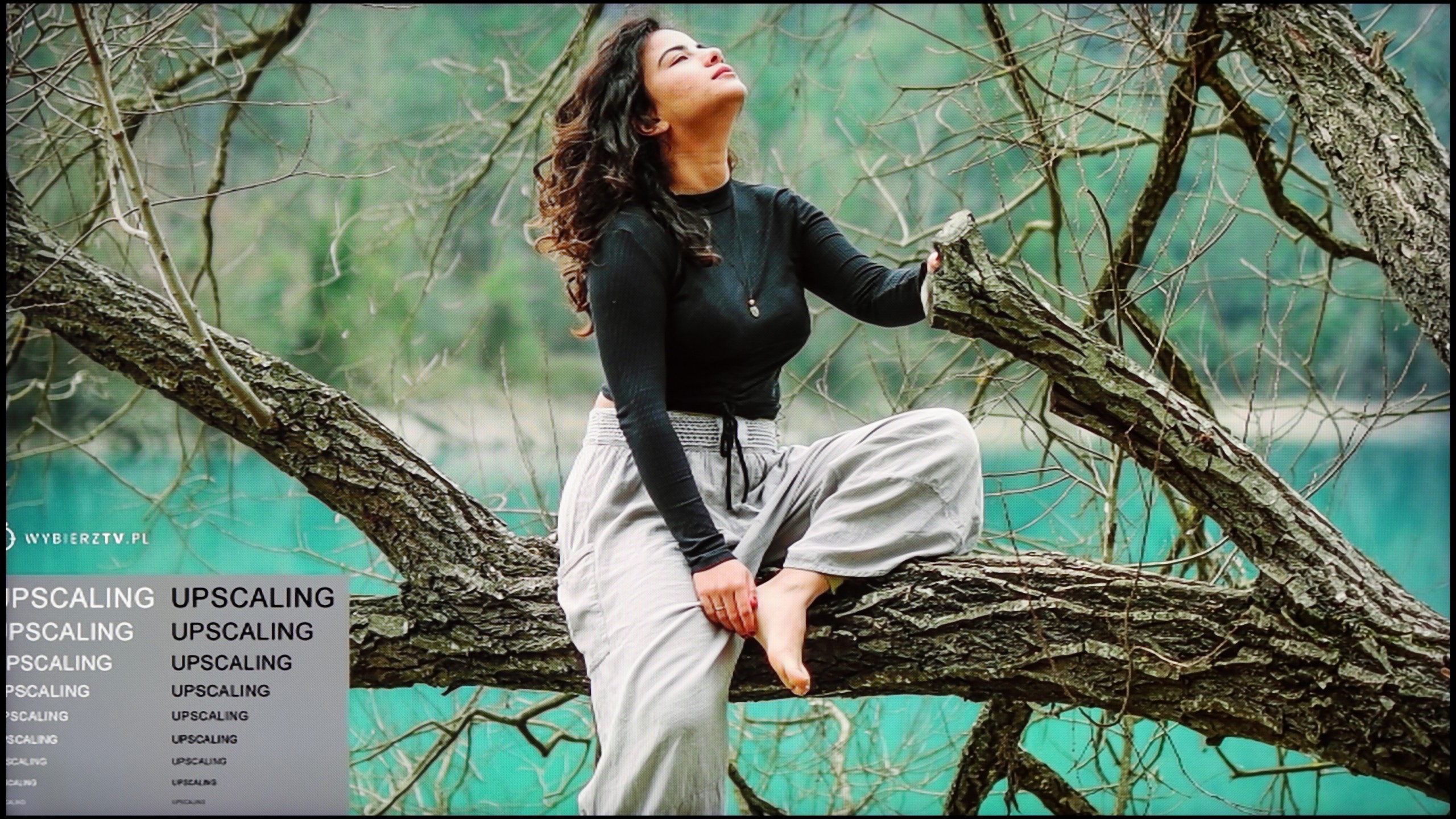
The TCL C6K performs quite well in terms of scaling. Lower quality materials look acceptable, and the lack of overscan issues means that the image is displayed in full, without cropping. However, one cannot expect miracles – content of very low quality will not gain new life here, as the image processor has its limitations. On thin lines or details, the characteristic tearing is visible, which reveals the absence of advanced image enhancement algorithms. It is also a pity that the C6K lacks the feature for smoothing tonal transitions – in older films or video materials, color banding can be noticeable and may be bothersome during long viewing sessions.
With lower quality materials, such as YouTube videos or older television recordings, the QN80F can showcase its stronger and weaker points. If strange color transitions or artifacts start appearing on the screen, it's worth using the noise reduction function. The best setting is at the "medium" level – it smooths out the problematic segments without blurring the entire image. However, one compromise must be kept in mind: this function always removes film grain. If someone enjoys its presence in older productions, it's better to leave the reduction turned off because, regardless of the setting, the grain simply disappears.
Resolution scaling, or upscaling, is another strong point of Samsung. The QN80F may not be the best TV on the market, but it performs very well in its price range, which is very important for such a large size as a 100-inch screen. Even low-quality materials can gain a second life – the image becomes sharper, more readable, and overall much more pleasant to view. A weak point remains overscan, or slight trimming of edges in very low resolutions (e.g., 576p), which has been a longstanding issue for Samsung. Fortunately, in everyday viewing of HD and 4K content, this practically doesn’t matter anymore.
Blur and motion smoothness
7.3/10
7/10
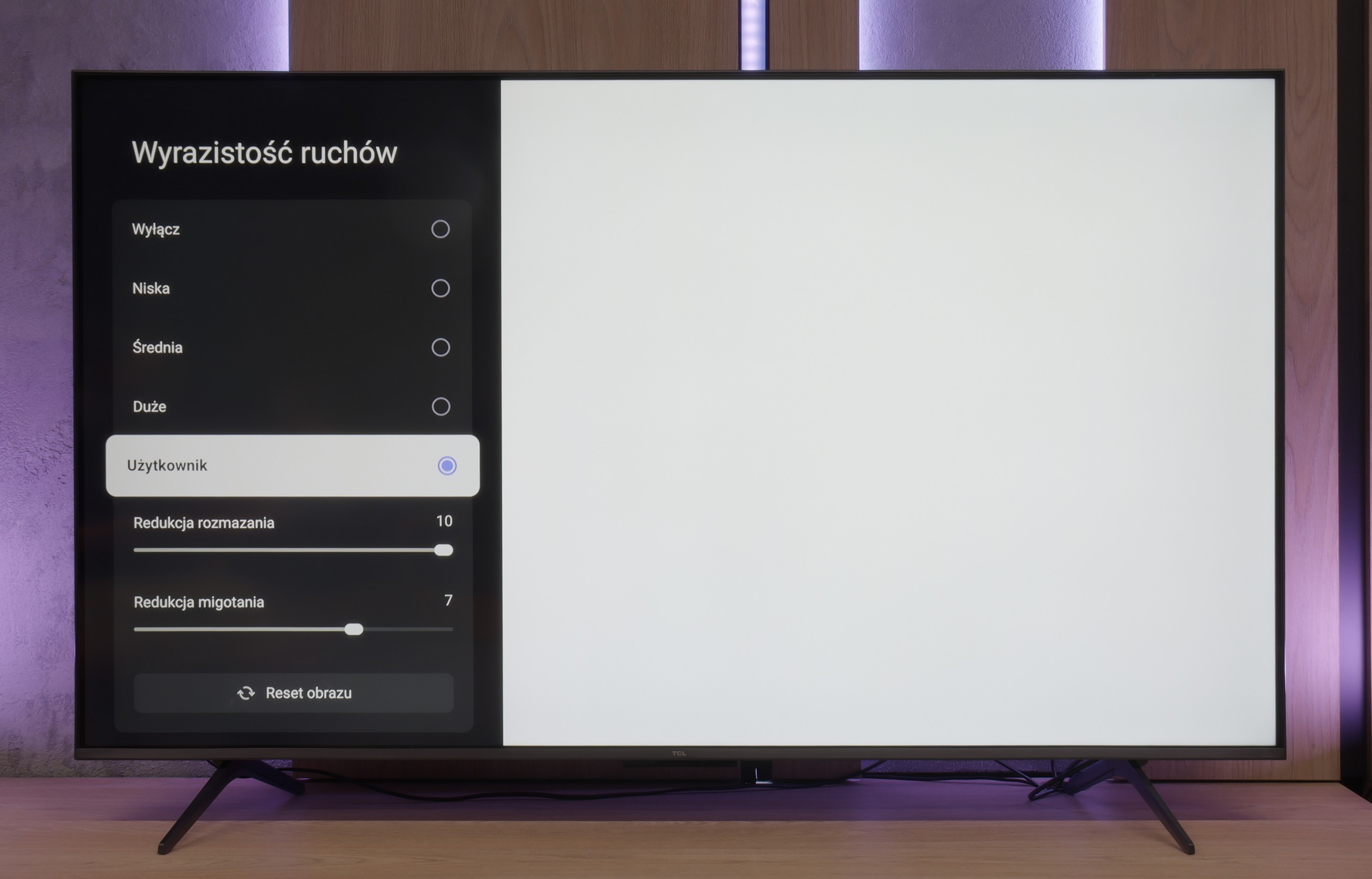
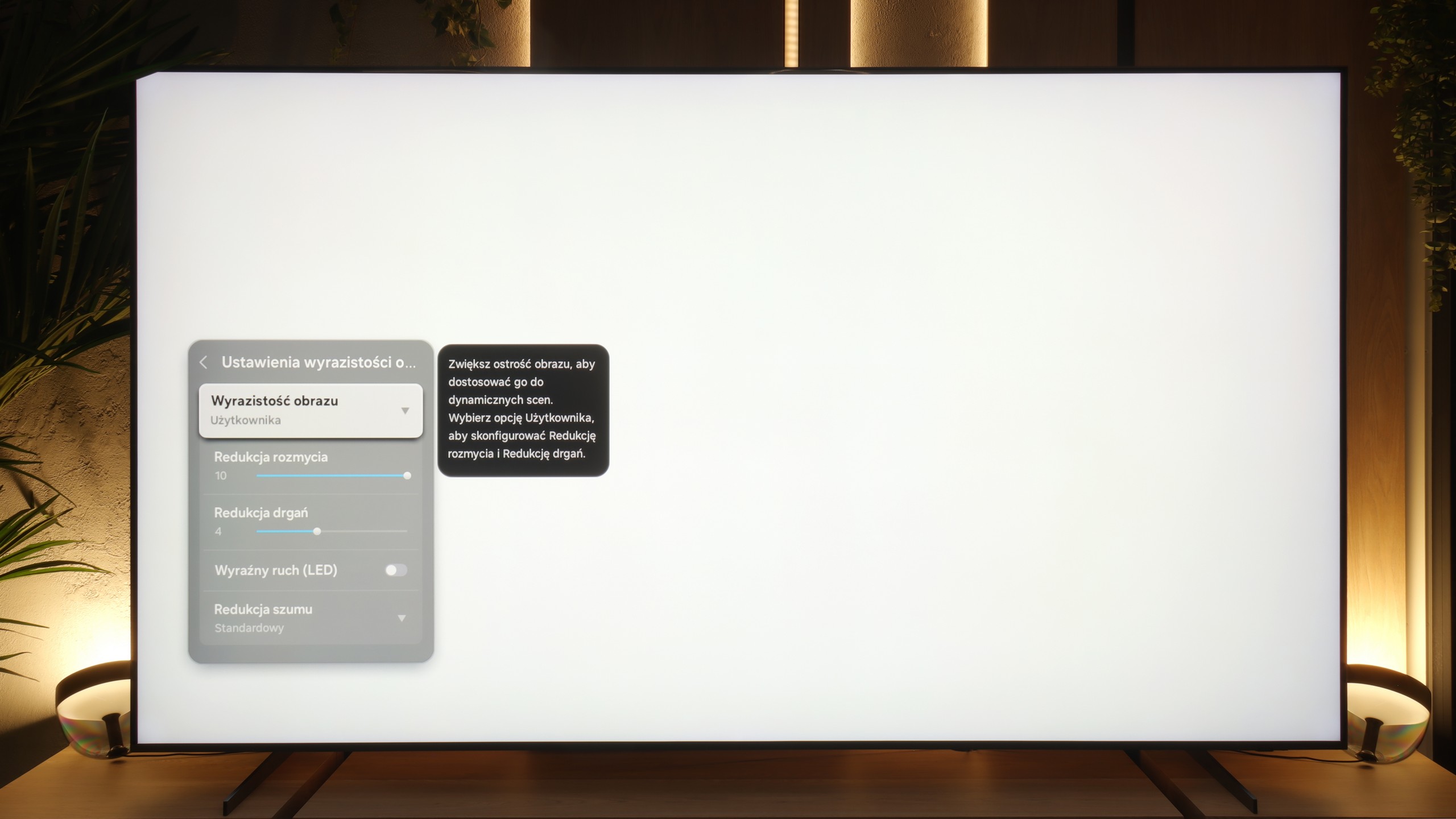
Blur (native resolution, maximum refresh rate):
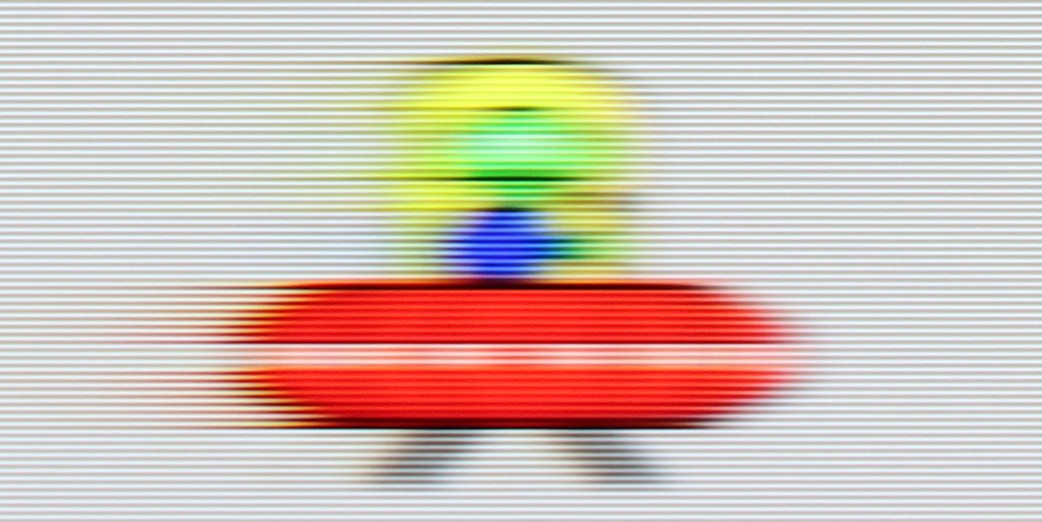
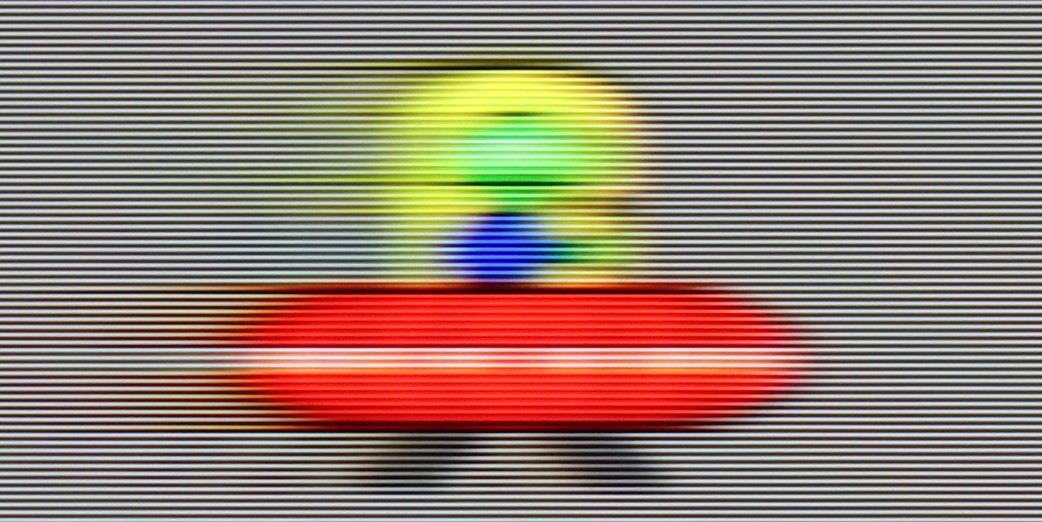
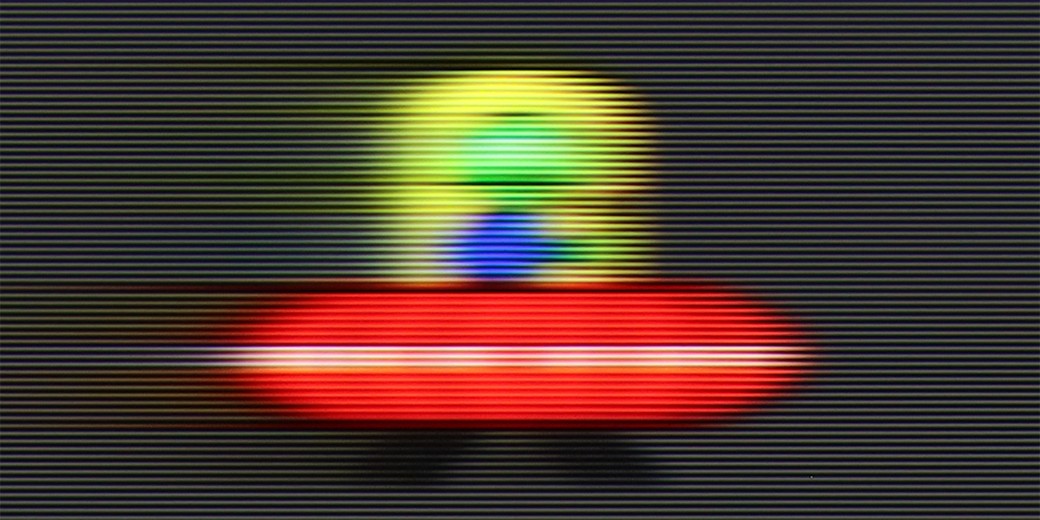



Blur (BFI function enabled):

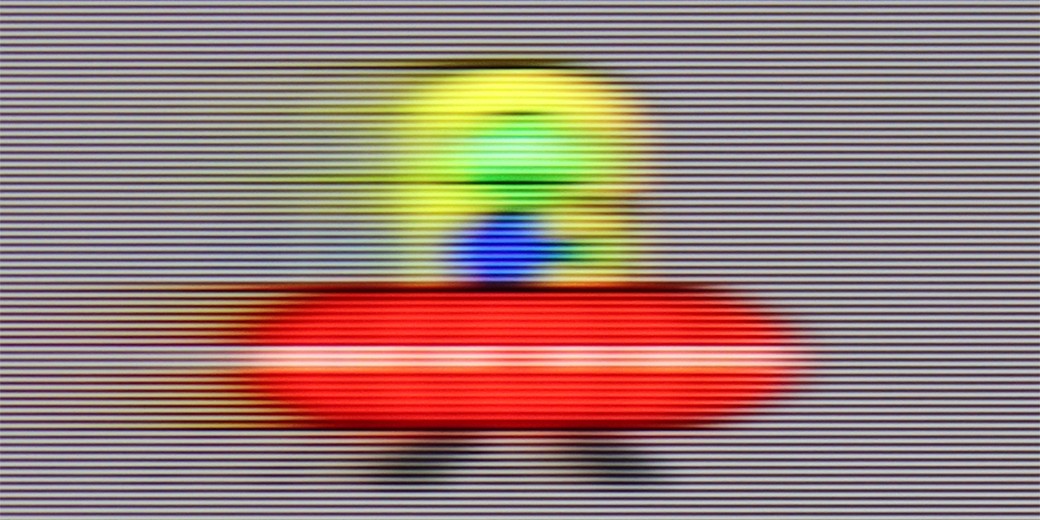
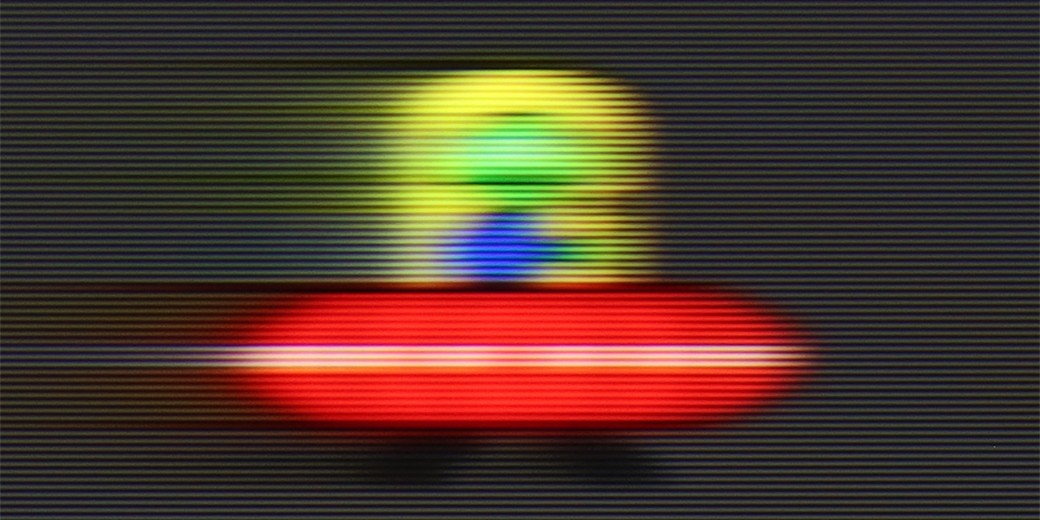
Image flickers in this mode



Smużenie ():
Smużenie (4K@144Hz):

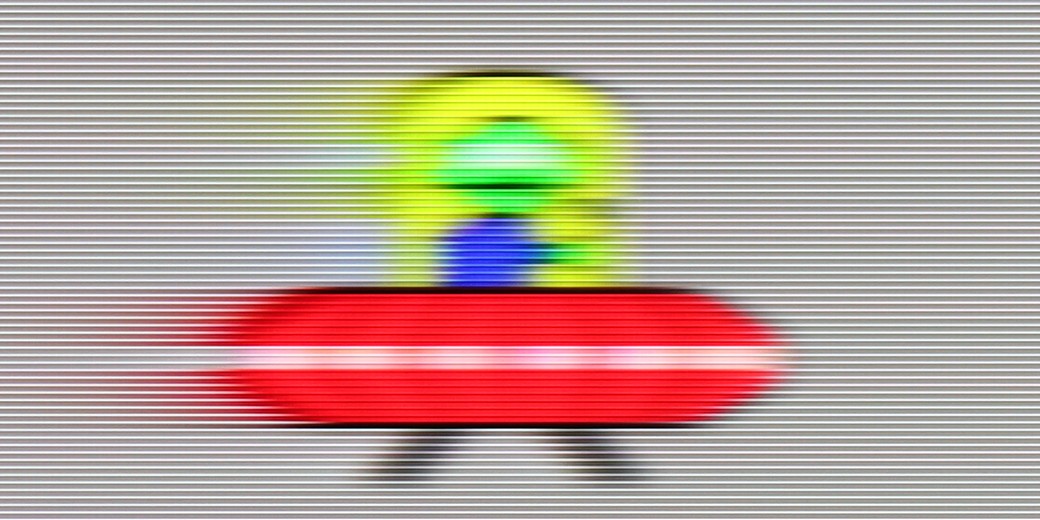
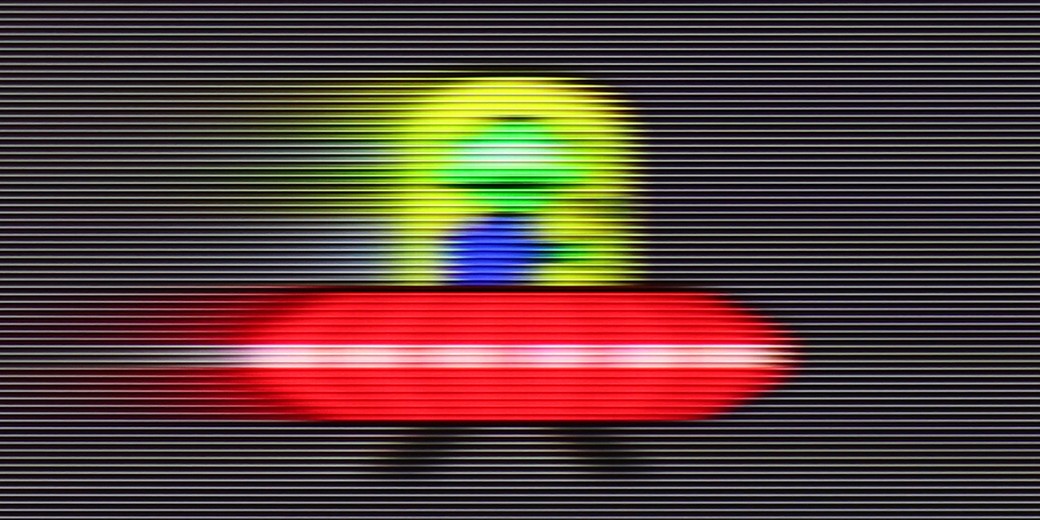
TCL C6K features a 144 Hz panel, which is a significant advantage in this price range. This is an important step forward compared to the previous model C655 PRO, which offered only 60 Hz at 4K. The difference is especially noticeable when watching sports or playing games – the ball, athletes, or fast action in a game are displayed more clearly and without losing details. An interesting fact is also the ability of the panel to operate at 240 Hz, which the manufacturer does not mention in official materials. We will return to this topic when discussing the game mode for PC.
TCL also added a feature for movie watchers: "Motion Clarity," which allows you to adjust the image to your preferences using two simple sliders. You can keep the movie frame visible or opt for a very smooth, almost theatrical effect. This way, everyone can find settings tailored to their taste.
The QN80F features a 144 Hz panel, and this is evident in practice – with full refresh, the image is exceptionally smooth, and motion blur remains at an acceptable, barely noticeable level. However, this mode is mainly aimed at PC gamers. The most important reference point in everyday use remains a 120 Hz refresh rate, and here a certain discrepancy arises. During the UFO test, we noticed the blurring of contours of quickly moving objects – it looked as if the television had the BFI (Black Frame Insertion) function permanently enabled, which in practice led to an unpleasant double edge effect. We do not yet know if this is a software issue or a characteristic of this model, but in its current form, it is difficult to praise such behavior.
Console compatibility and gaming features
9.8/10
8.2/10
- ALLM
- VRR
- VRR range48 - 240Hz48 - 144Hz
- Dolby Vision Game Mode
- Correct implementation of HGIG
- 1080p@120Hz
- 1440p@120Hz
- 4K@120Hz
- Game bar
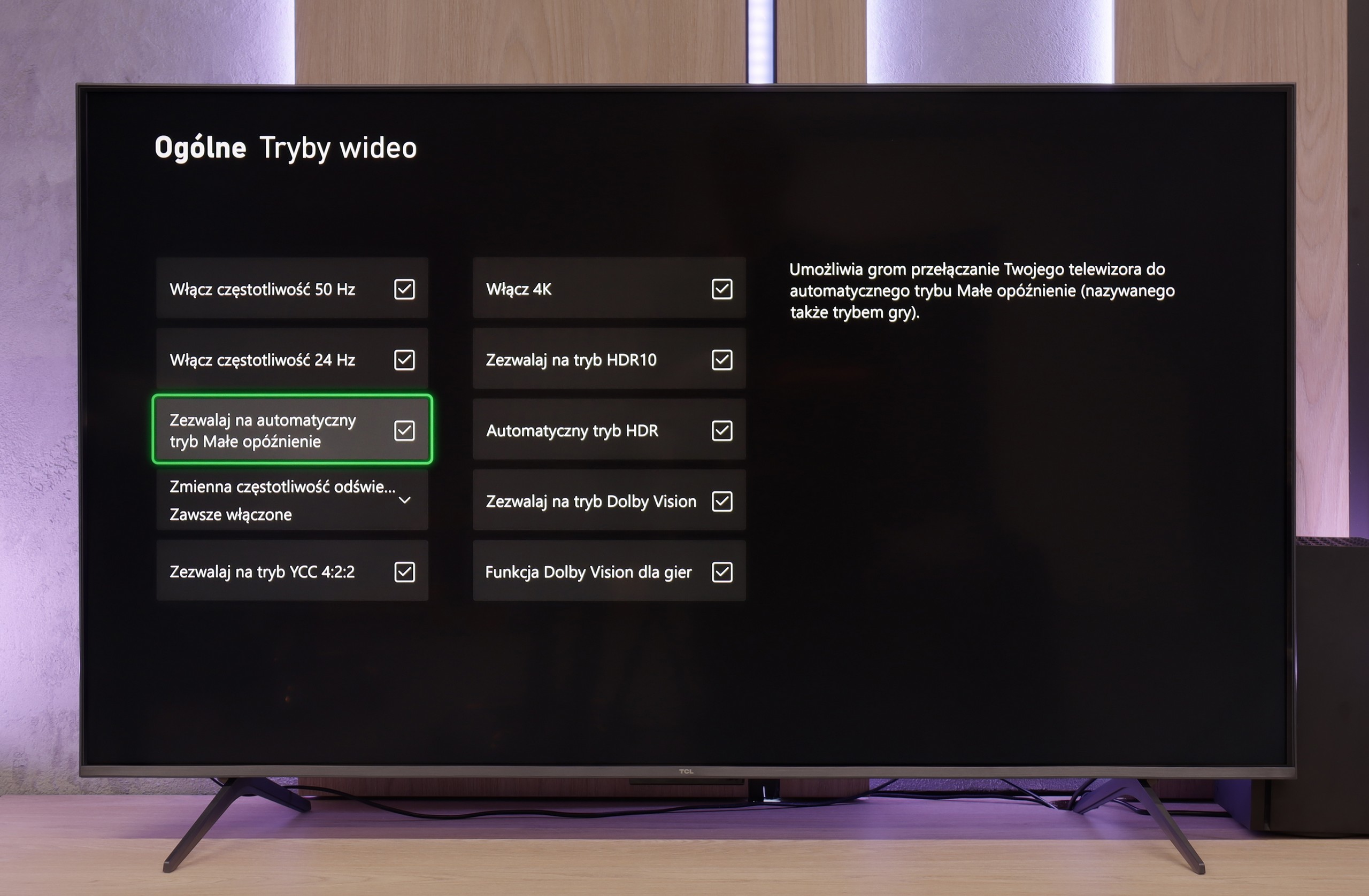
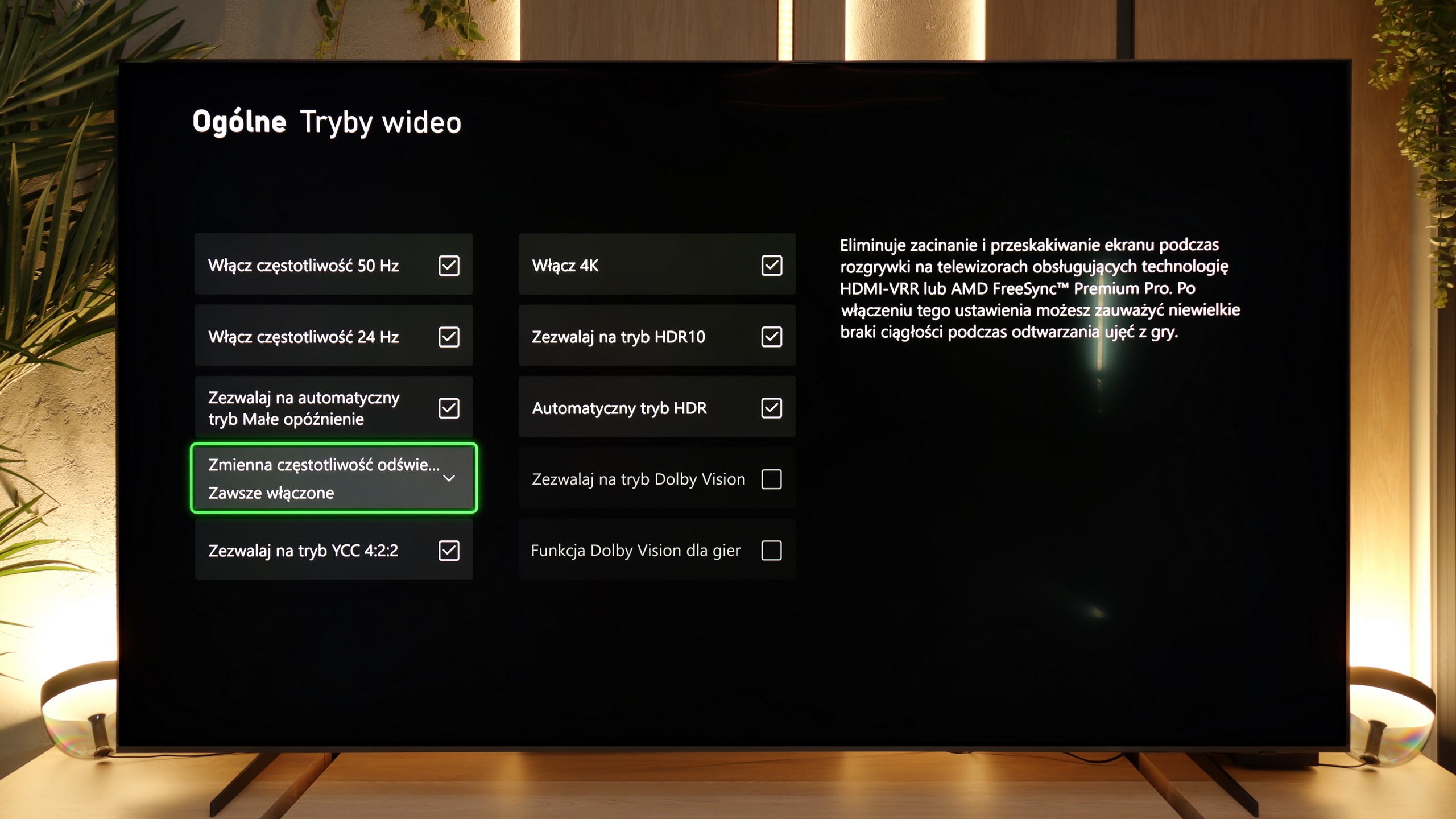
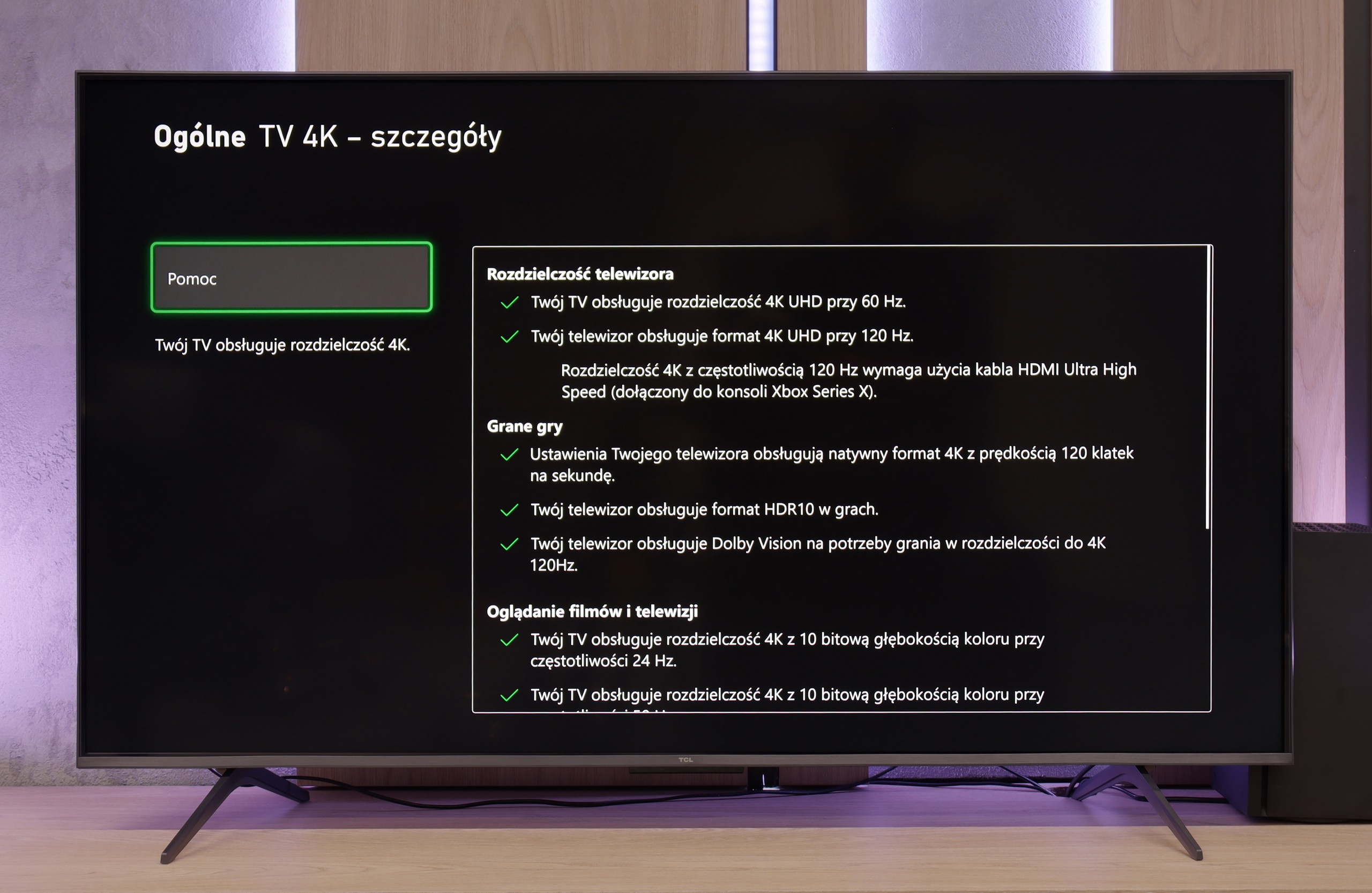
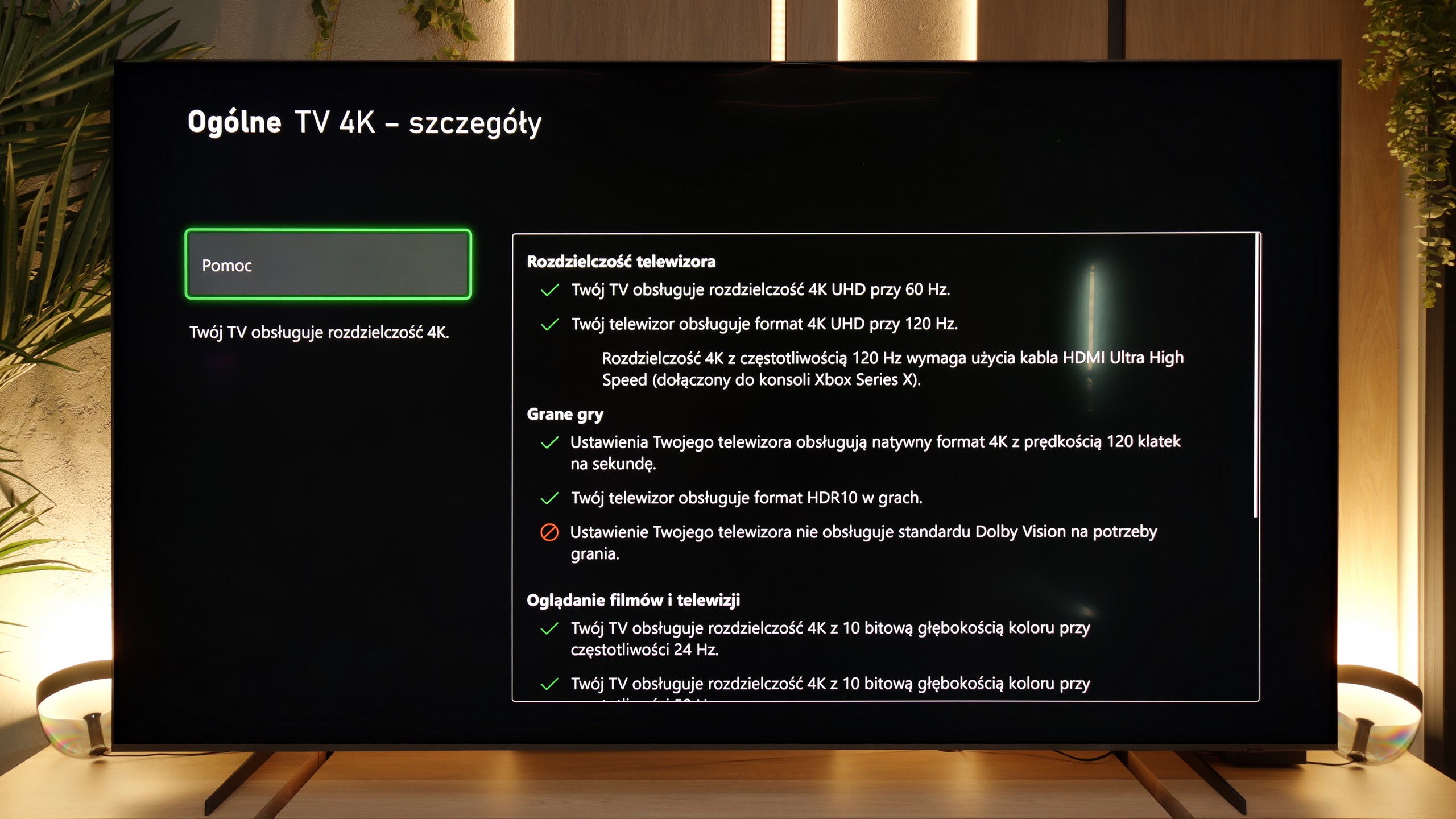
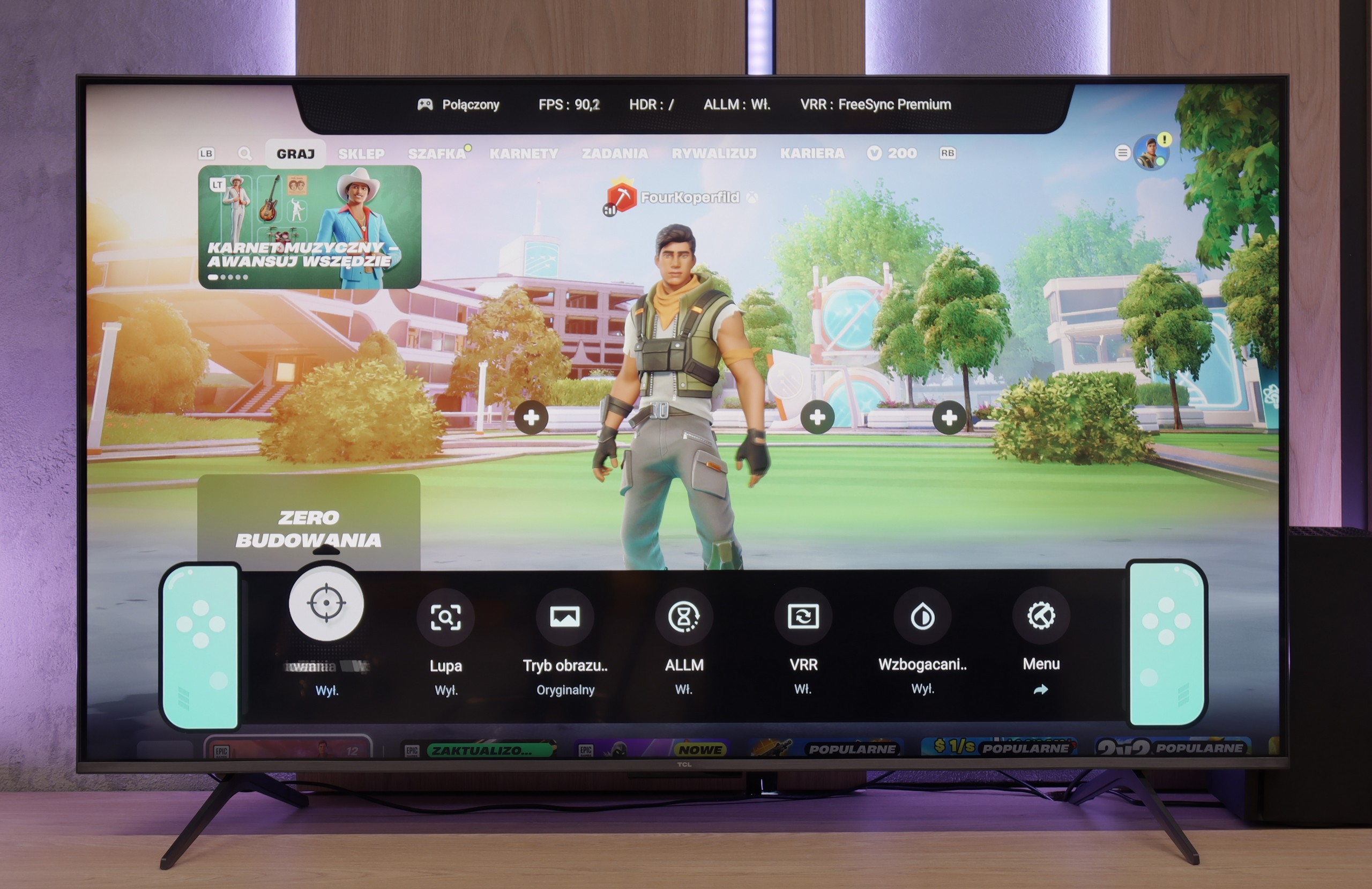
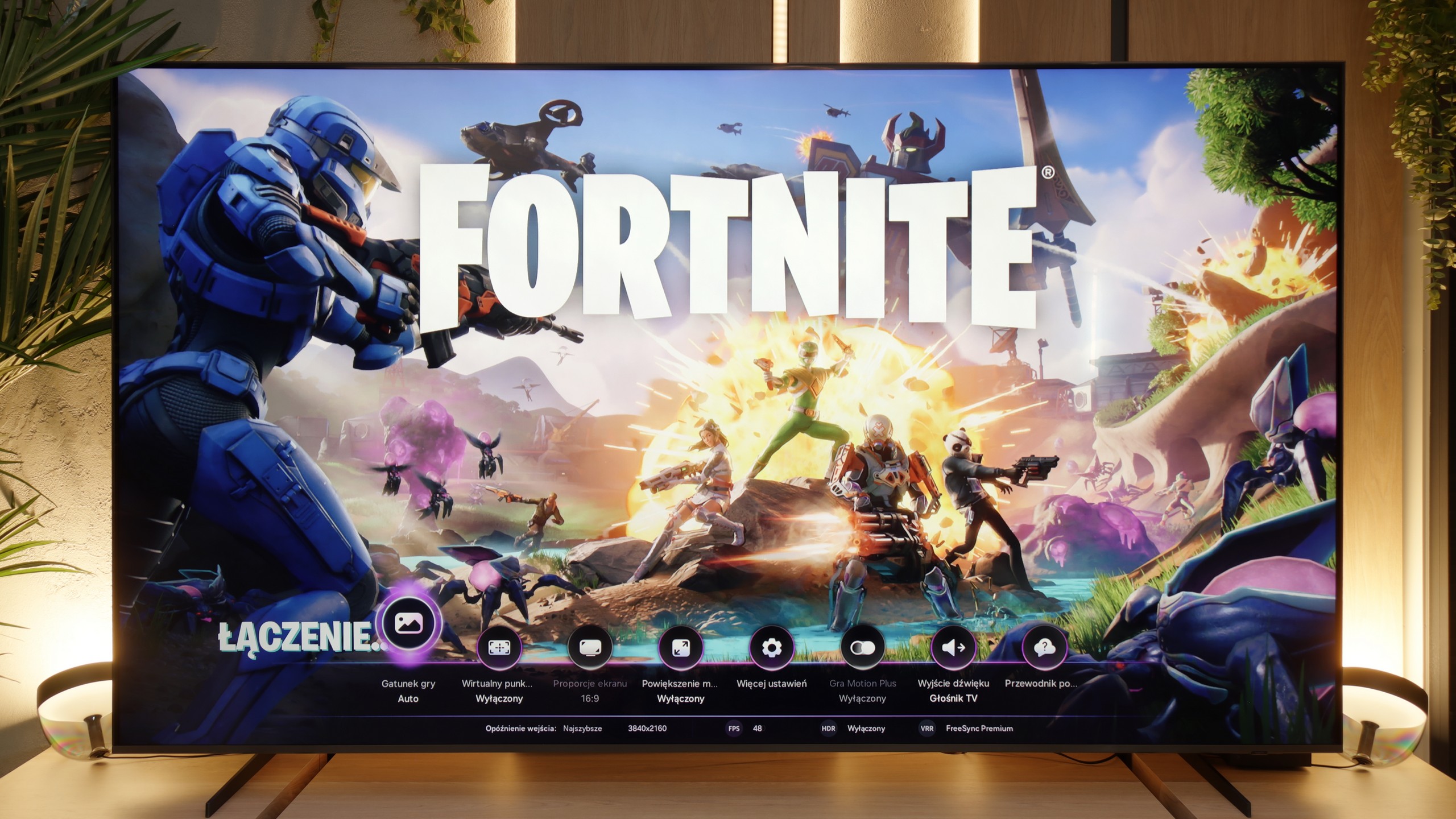
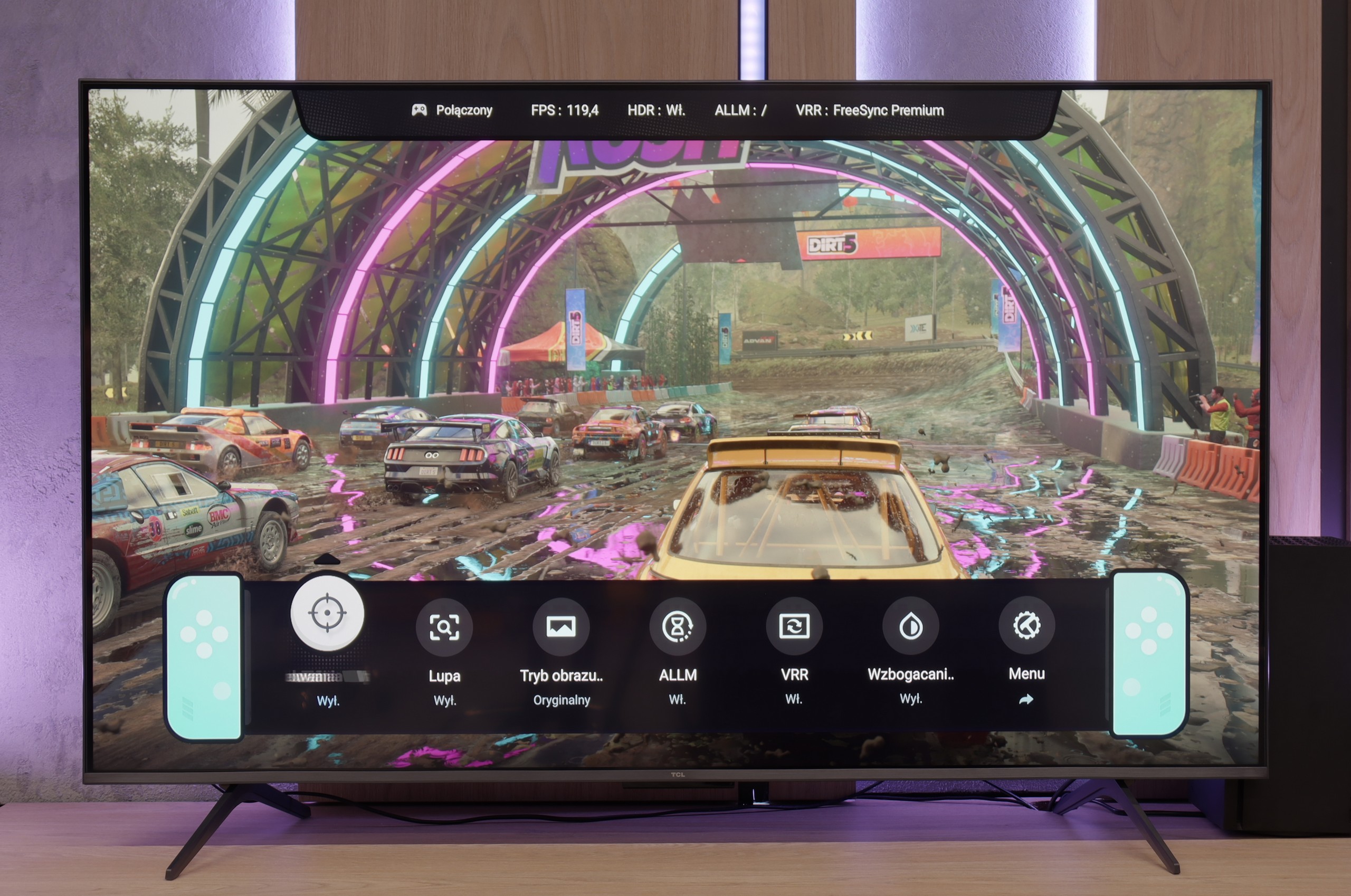
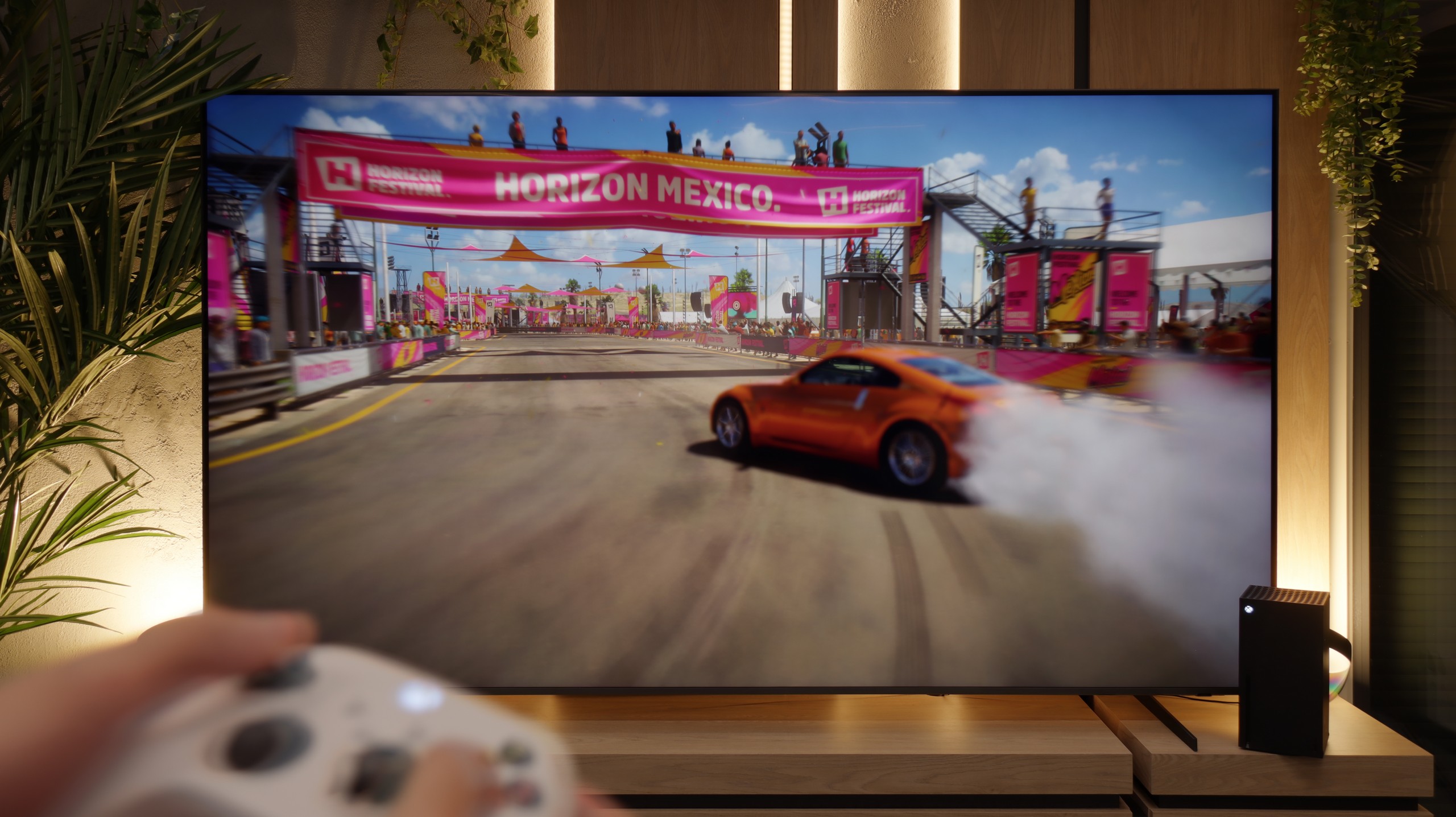
The TCL C6K is a TV that can confidently be called equipment designed for gamers. Here we have 4K at 144 Hz, VRR support, automatic game mode (ALLM), and Dolby Vision Gaming. Additionally, there's a practical Game Bar, a panel with the most important settings readily available – useful when we want to quickly change something during gameplay (e.g., screen aspect ratio: Yes, that’s possible!). The wide VRR range, reaching up to 240 Hz, deserves attention. However, this is mainly an option for PC gamers who drop below the native 4K resolution. Then the TV can spread its wings and show additional smoothness, especially in fast-paced e-sports titles. In the case of consoles, we stick to the classic limit of 120 Hz, but the possibilities are still quite broad. The only drawback is a slight ghosting that can sometimes be seen in dynamic scenes. Other than that, the C6K offers everything gamers expect from a TV.
The Samsung QN80F gives the impression of a television designed for gamers. On the list of advantages, it features a 144 Hz panel, four full-fledged HDMI 2.1 ports, full support for VRR and ALLM, and one of the best-designed game bars on the market. Additionally, there is the Game Motion Plus motion smoothing, which works even in games without actually increasing input lag, making the QN80F an absolute phenomenon in this category. In practice, this means you can enjoy smoother visuals without sacrificing responsiveness, which is a dream for many console gamers!
As usual with Samsung, Dolby Vision is missing in games, and this is no longer surprising. What surprised us much more, however, is that in the 2025 models… the HGIG feature has disappeared. It was the feature that allowed consoles like the PlayStation 5 and Xbox Series X to perfectly match HDR tone mapping to the capabilities of the television. In the current firmware of the QN80F, this option simply doesn’t exist – it looks more like a bug than a conscious decision by the manufacturer, but as of the test day, it must be noted that HGIG is unavailable. Because of this one omission, the QN80F goes from being almost the perfect television for gamers to just "almost" perfect. This is quite a pity, as Samsung has created a model that truly raises the bar in gaming hardware.
Input lag
9.7/10
9.8/10
SDR
HDR
Dolby Vision
In terms of input lag, the TCL C6K performs excellently. With 120 Hz content, the delay is around 10 ms, and at times even less. This is a level at which the response is practically instantaneous, and it's hard to find any objections. For 60 Hz materials, the result is about 18 ms – still a very good result, more than sufficient for comfortable gaming.
Input lag is something that can ruin the entire fun, but fortunately, there's nothing to worry about with the QN80F. At 120 Hz, the lag drops below 10 ms, so it feels like the TV doesn't exist at all between the controller and the image. The response is immediate; everything happens exactly when we want it to. At 60 Hz, the result is around 17 ms – that's more, but still within the range of full comfort. In practice, console games look and operate smoothly, with no annoying lags in sight. This is the moment where it’s clear that Samsung really put effort into the gaming mode – the QN80F gives a sense of control and speed that one would expect more from a monitor rather than from a 100-inch behemoth in the living room.
Compatibility with PC
8.6/10
8.6/10
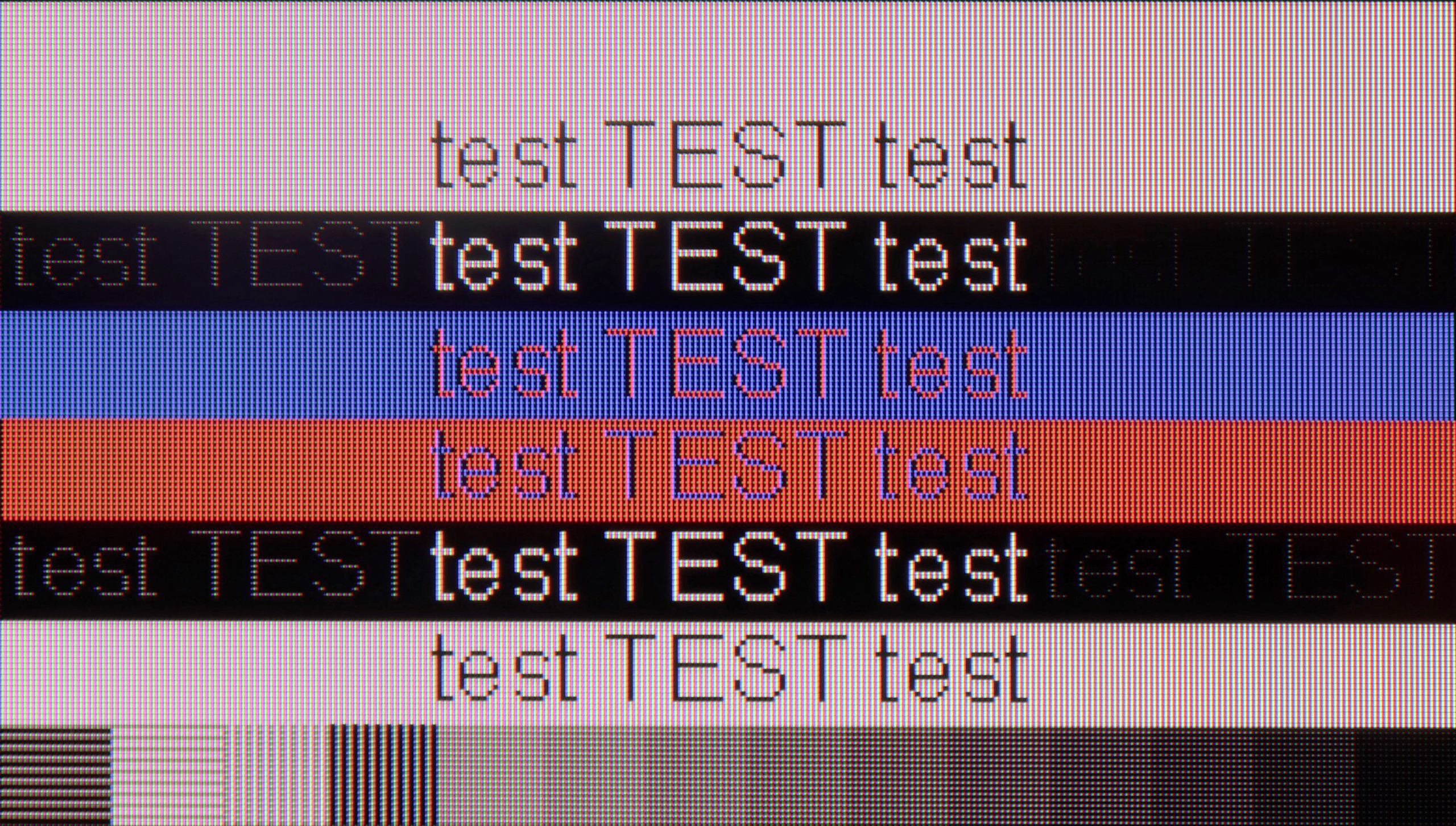
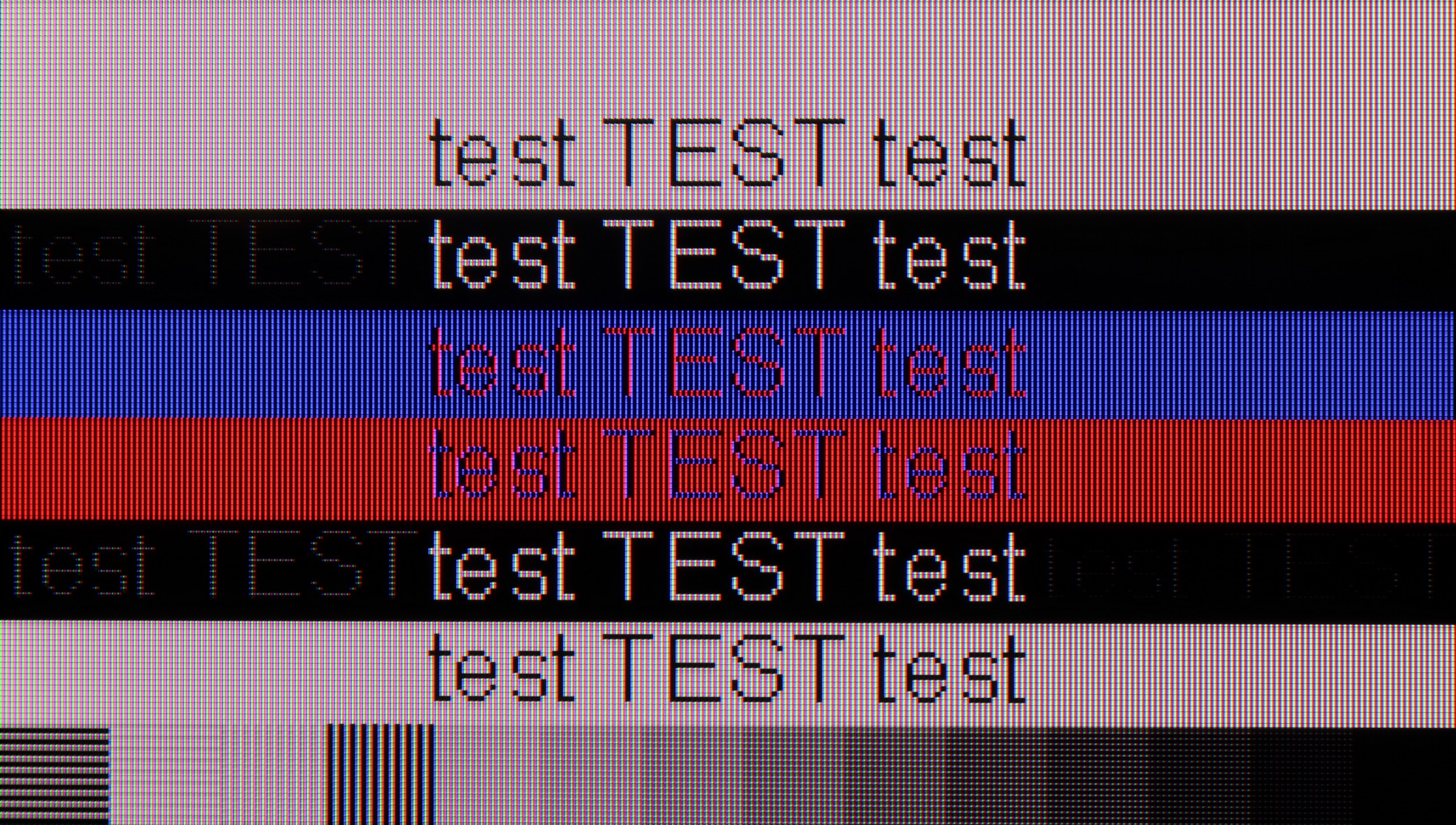
After connecting the TCL C6K to a computer, it performs excellently. At native resolution, we have 4K at 144 Hz, and if we lower the resolution, we can even achieve 240 Hz. Additionally, the television is compatible with Nvidia and AMD graphics cards – supporting both G-Sync and FreeSync. It's also hard to find fault with it for office work. Fonts are sharp and readable thanks to 4:4:4 chroma support, and any minor imperfections are so small that they simply go unnoticed in normal use.
Cooperating with a PC on the QN80F is a bit strange. When it comes to gaming, there’s no cause for concern: we have full support for 144 Hz, both G-Sync and FreeSync work, and the smoothness is truly impressive. The problem starts when using a computer for everyday tasks – especially when we are looking at fonts instead of games. At 120 Hz, the image looks nearly flawless. The letters are readable, sharp, and the only minor detail that can be noticed is a slight dimming of thin lines. However, this is a detail that shouldn’t interfere with normal usage. Bigger problems arise at 144 Hz, which is the mode that is supposedly designed for PC users. Instead of crystal-clear fonts, a strange anomaly appears. The TV adds shadows with tiny dots, causing the text to simply look odd. Fortunately, this is more of a curiosity than a real problem. After all, it’s hard to imagine someone putting a 100-inch colossus on a desk and staring at Excel or Word sheets from half a meter away. For gaming, the QN80F is excellent, and when working normally with a PC, it’s better to just stick to the 120 Hz mode.
Viewing angles
3/10
3.3/10
In the TCL C6K, the viewing angles are typical for a VA matrix. Sitting directly in front, the image looks very good, but any shift to the side results in a noticeable drop in color saturation and brightness. The difference is particularly visible in colorful scenes – the colors become washed out, and the contrast loses its depth. Compared to IPS panels, this is clearly a weaker result, although the trade-off is better black levels and higher native contrast "something for something."
The viewing angles are unfortunately a weak point of the QN80F. With smaller TVs, this can still be tolerated, but in the case of 100 inches, the flaw becomes much more noticeable. It is enough to sit slightly off to the side for the edges of the screen to appear fainter than its center. And when we try to watch something at a steeper angle, the image simply loses its charm – colors become washed out, contrast drops, and the depth visible straight on is lost. It’s a shame that with such a large screen, Samsung did not attempt to apply coatings that would widen the viewing angles. This is where it would make the most sense, as it’s hard to expect everyone in the living room to sit perfectly in front of the screen. If someone is primarily interested in wide angles, they need to look for mini-LEDs on an IPS panel – these may not have such deep blacks, but they perform much better when viewed from the side.
TV efficiency during daytime
6.4/10
7/10
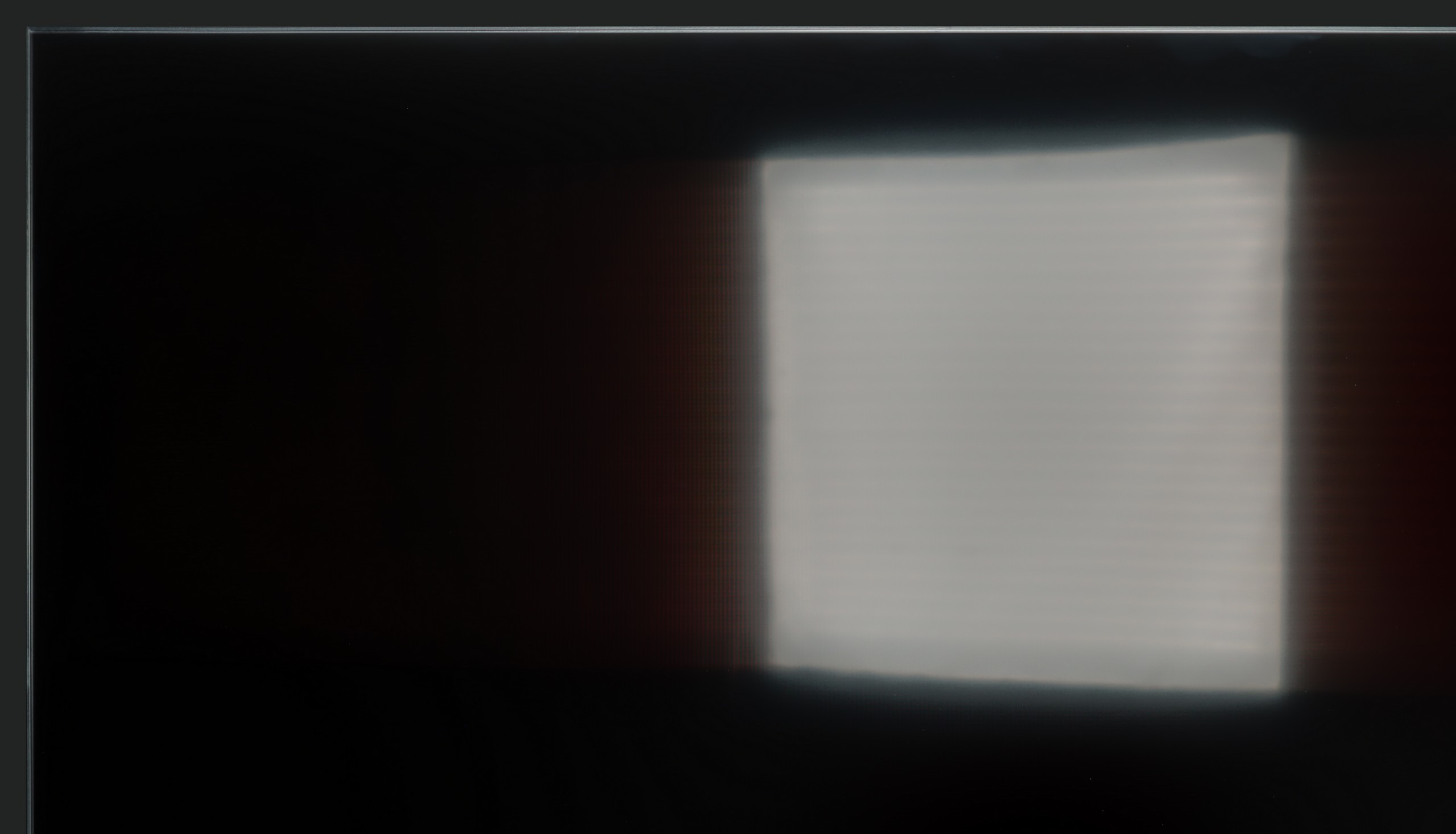
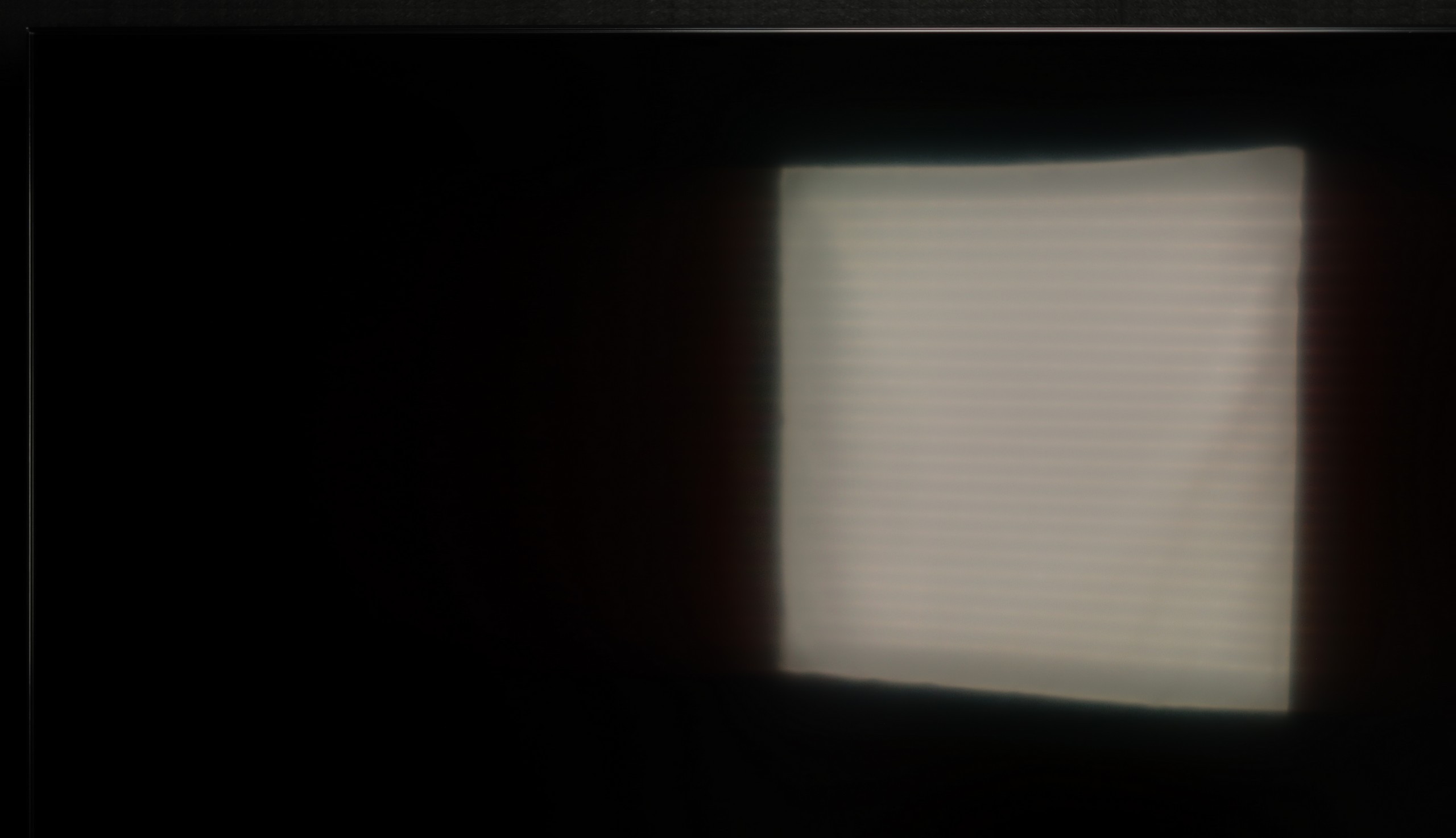


Matrix brightness
Average luminance SDR
Samsung QN80F 100" : 623 cd/m2
TCL C6K: 532 cd/m2
TCL C6K performs quite well in bright lighting conditions. The panel offers decent brightness – in SDR content, it reaches around 550 nits, which allows for comfortable television viewing in an average living room, even on days with strong light coming through the windows. This means that daytime viewing does not require complete darkening of the room. It's also worth noting that the screen coating does a good job of reducing reflections, so the television doesn't turn into a "mirror" even in bright light. However, this is not the level of top models with more advanced anti-reflective coatings – in very challenging conditions, such as with large windows, reflections will be noticeable.
The performance of the QN80F during the day is an interesting topic, as the 100-inch version differs from smaller sizes not only in scale but also in the coating used. Samsung opted for a different type of anti-reflective layer here, and it must be said that the effect is not as good as in the smaller models – reflections are a bit more visible, especially with strong light coming in from the window. On the other hand, the manufacturer found a way around this, as the 100-inch QN80F compensates with brightness. The average luminance in SDR content exceeds 620 nits, which practically provides a really strong reserve for viewing even in a heavily sunlit room. In everyday use, the difference between weaker reflection suppression and higher brightness is practically neutralized – the TV maintains readability and does not lose clarity even in the middle of the day. The end result is that although the coating in this version is not among the best, thanks to the high brightness, the QN80F performs better in bright conditions than one might expect.
Details about the matrix
Subpixel Structure:
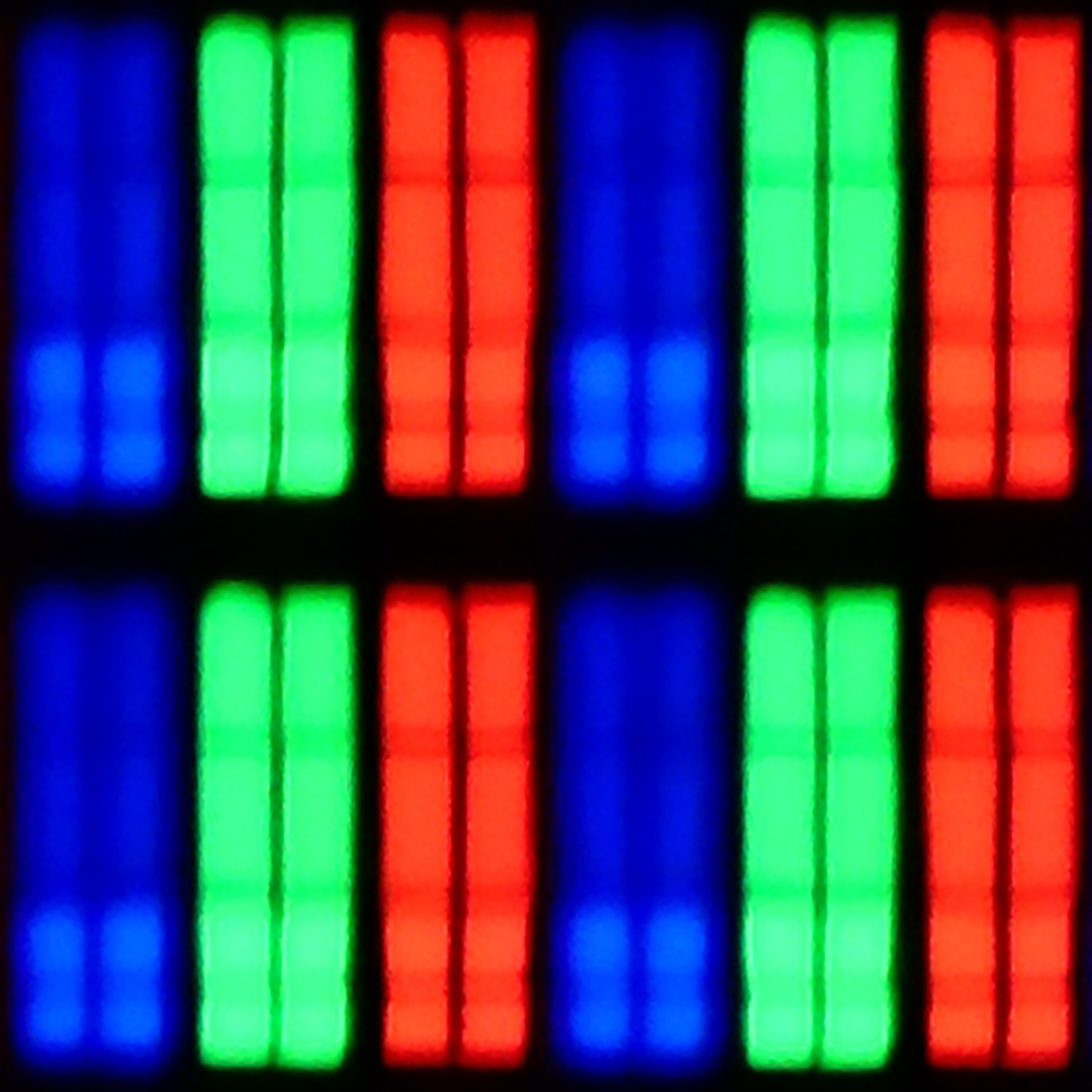
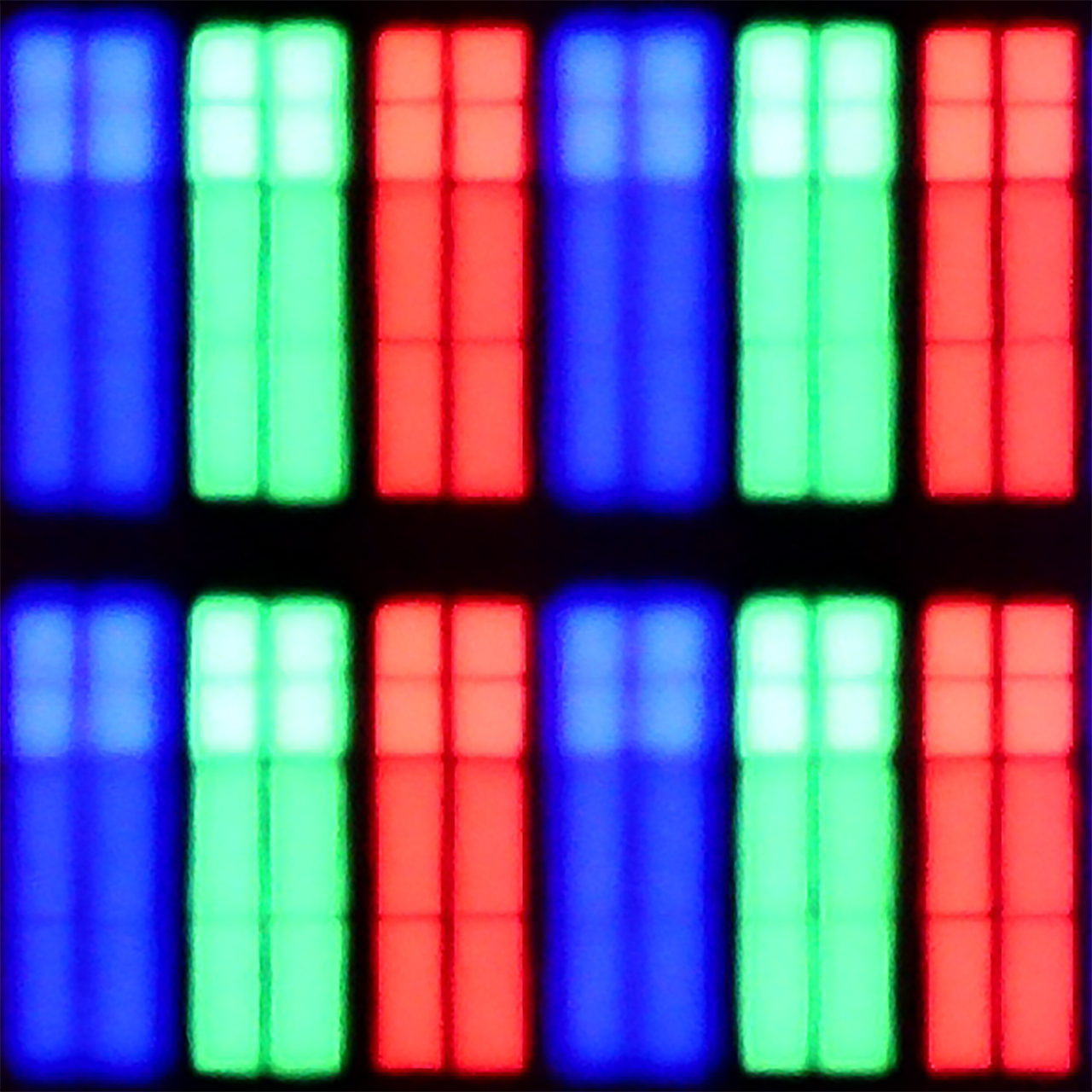
Panel uniformity and thermal imaging:
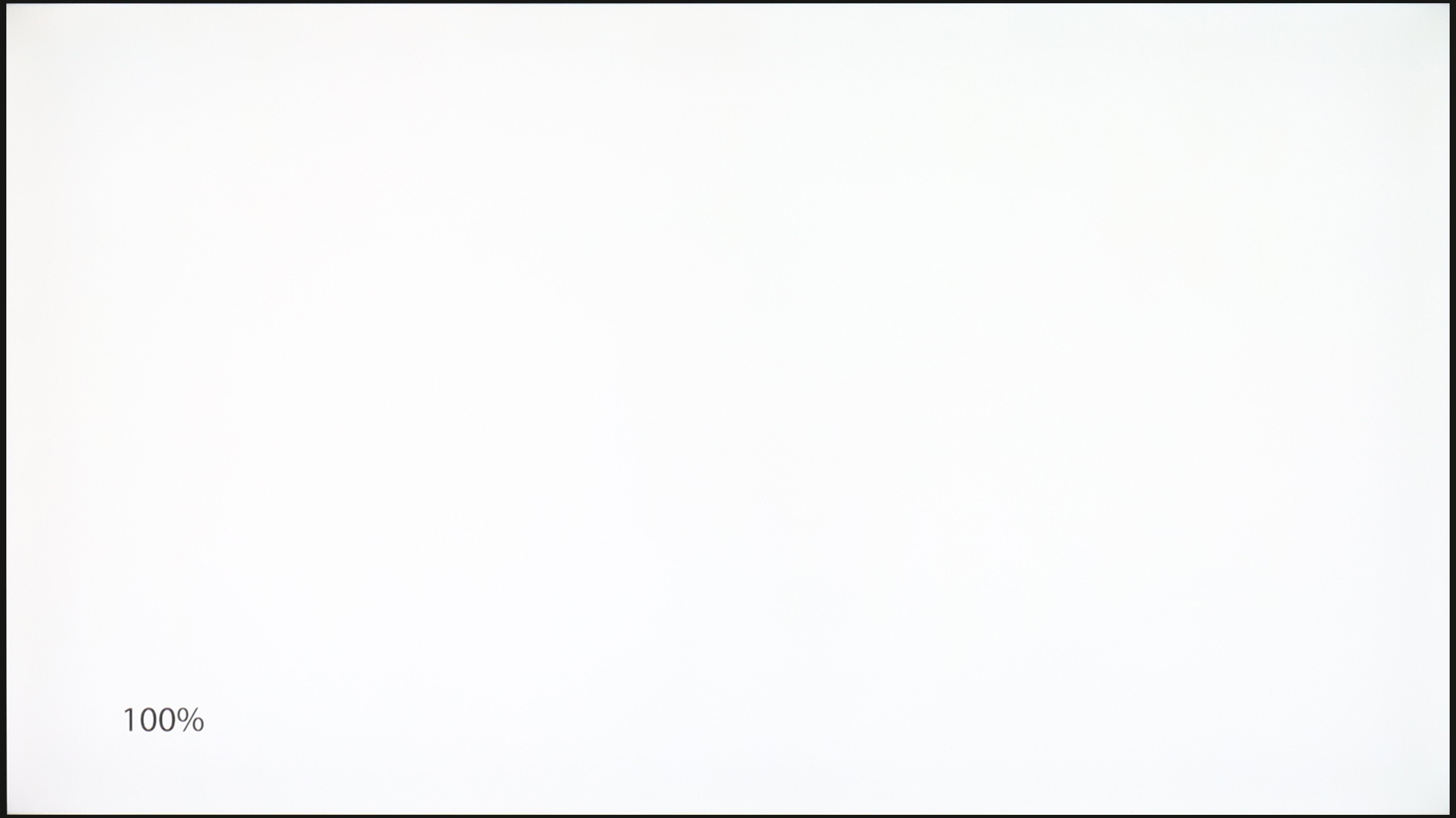
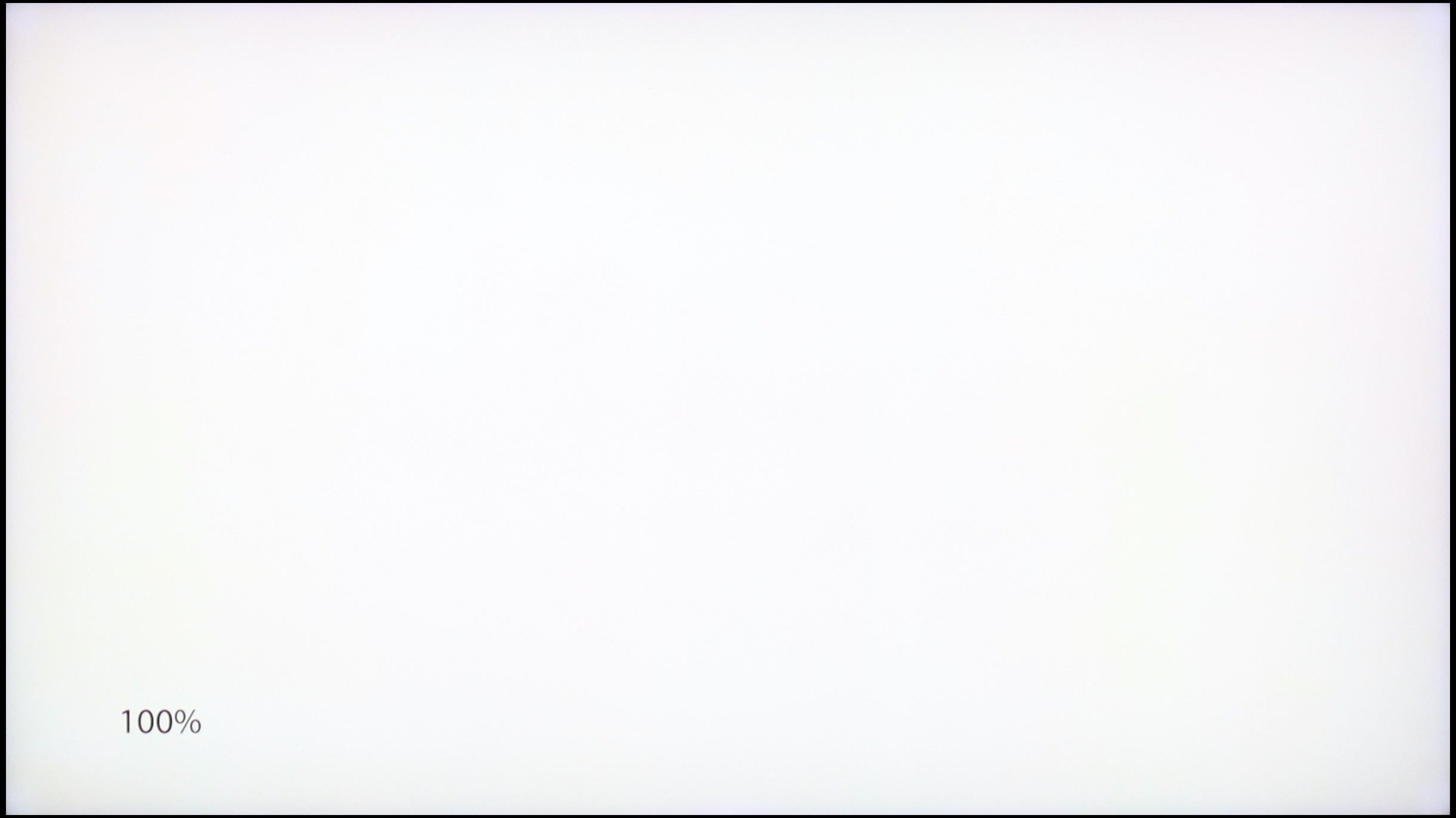
TCL C6K
Samsung QN80F 100"
TV features
7/10
7.7/10
- HDMI inputs2 x HDMI 2.0, 2 x HDMI 2.1 48Gbps0 x HDMI 2.0, 4 x HDMI 2.1 48Gbps
- OutputsToslink (Optical audio), eARC (HDMI), ARC (HDMI)Toslink (Optical audio), eARC (HDMI), ARC (HDMI)
- Network InterfacesWi-Fi 2.4GHz, Wi-Fi 5GHz, Ethernet (LAN) 100MbpsWi-Fi 2.4GHz, Wi-Fi 5GHz, Ethernet (LAN) 100Mbps
- TV receptionDVB-T, DVB-T2, DVB-S, DVB-S2, DVB-CDVB-T, DVB-T2, DVB-S, DVB-S2, DVB-C
Classic features:
- Recording to USB (terrestrial TV)
- Recording programming
- Picture in Picture (PiP)
- RF remote control (no need to aim at the screen)
- Backlit remote control
- Teletext
- Audio only mode
- Bluetooth headphones support
- Simultaneous Bluetooth headphones & TV audio
Smart features:
- AirPlay
- Screen mirroring (Windows Miracast)
- Voice search
- Voice search in native language
- Ability to connect a keyboard and mouse
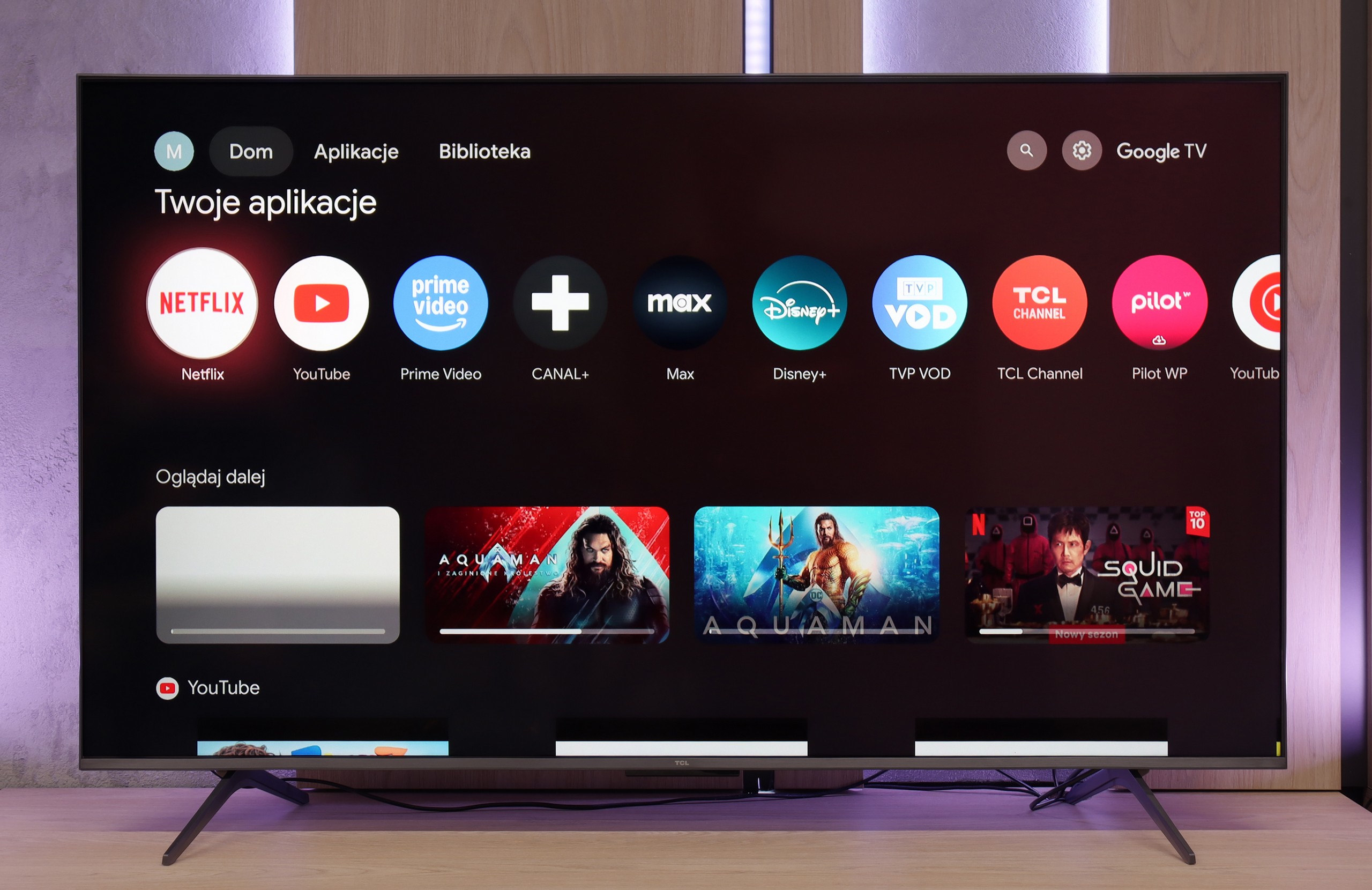
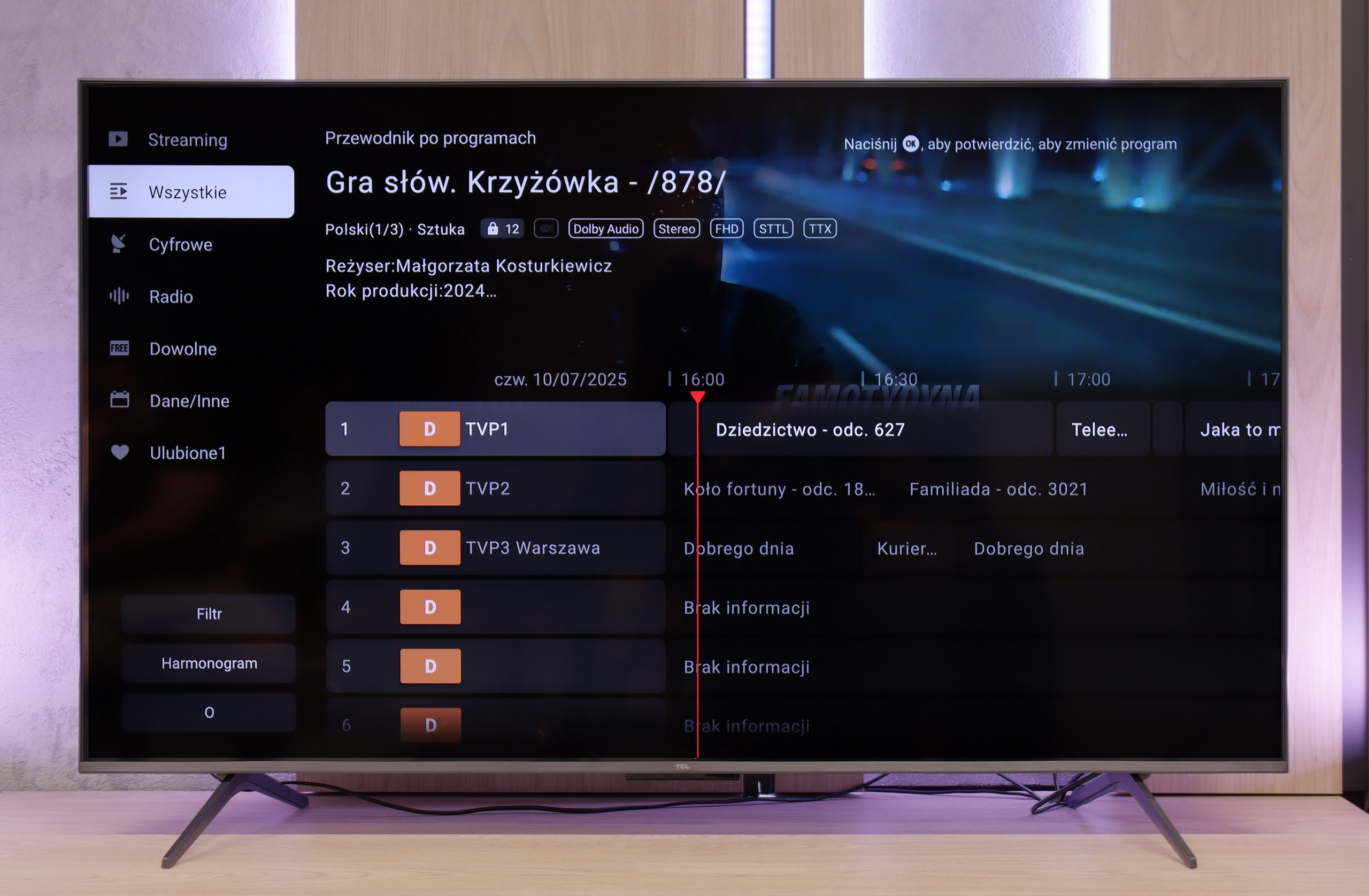
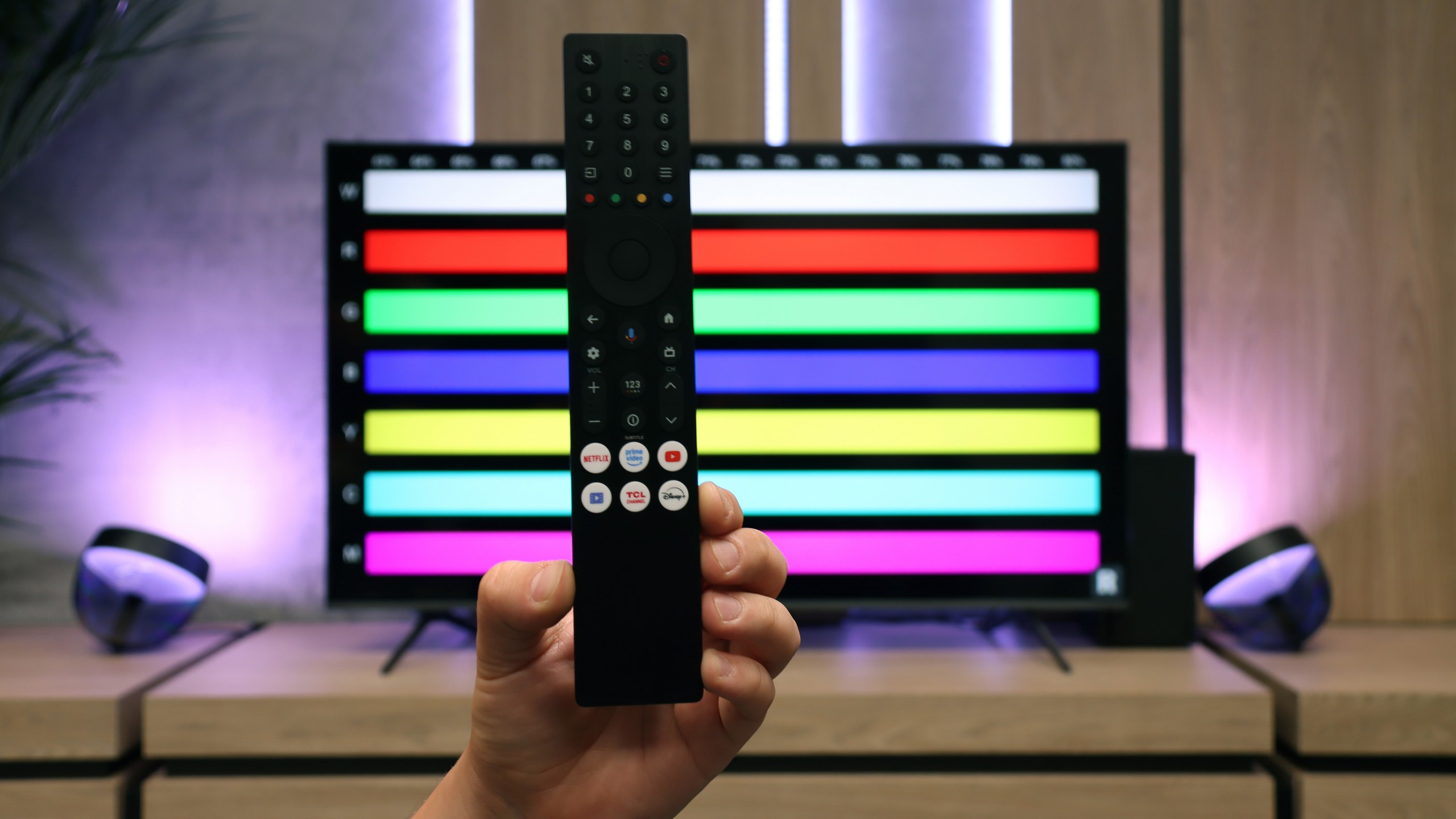
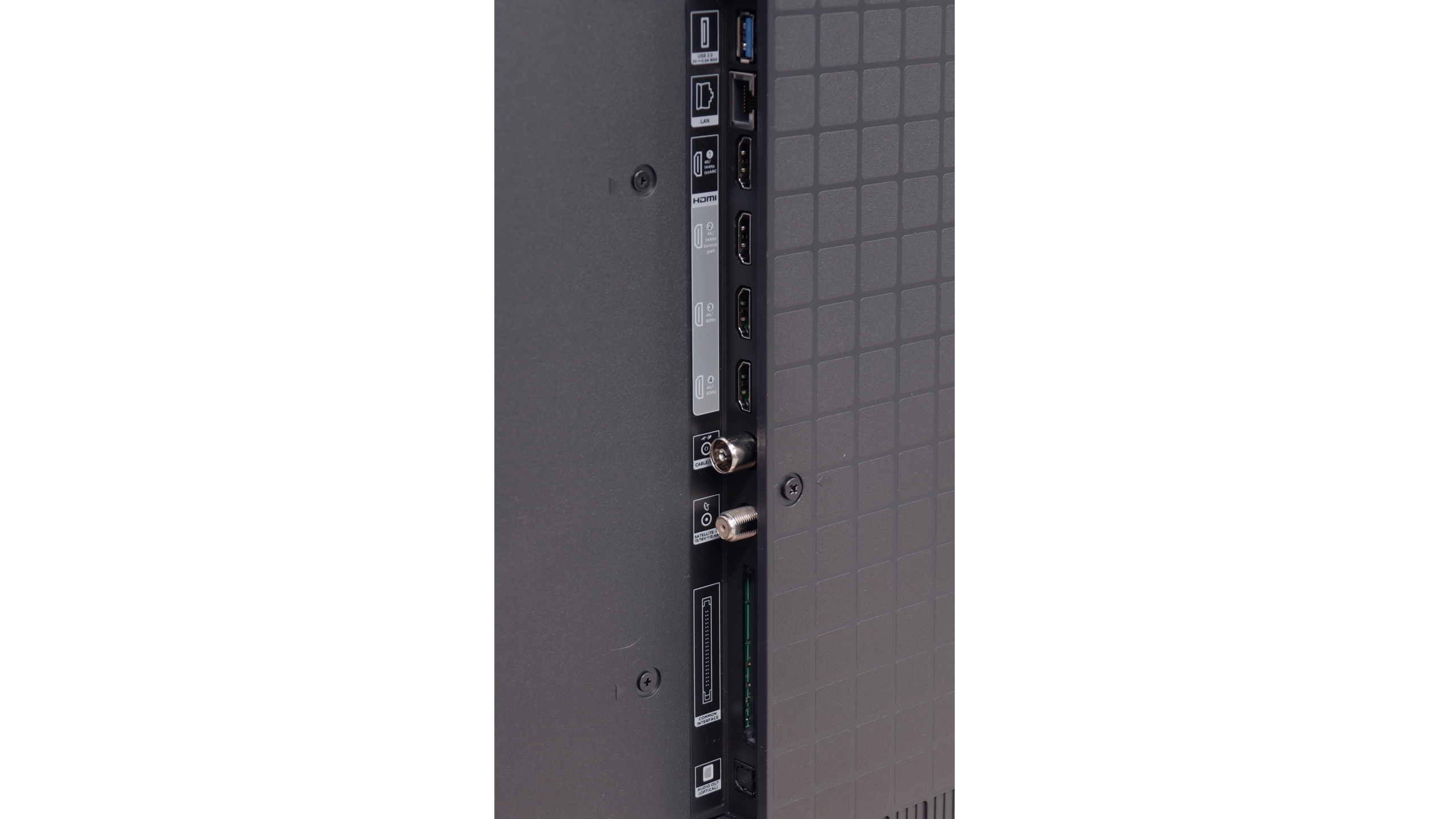
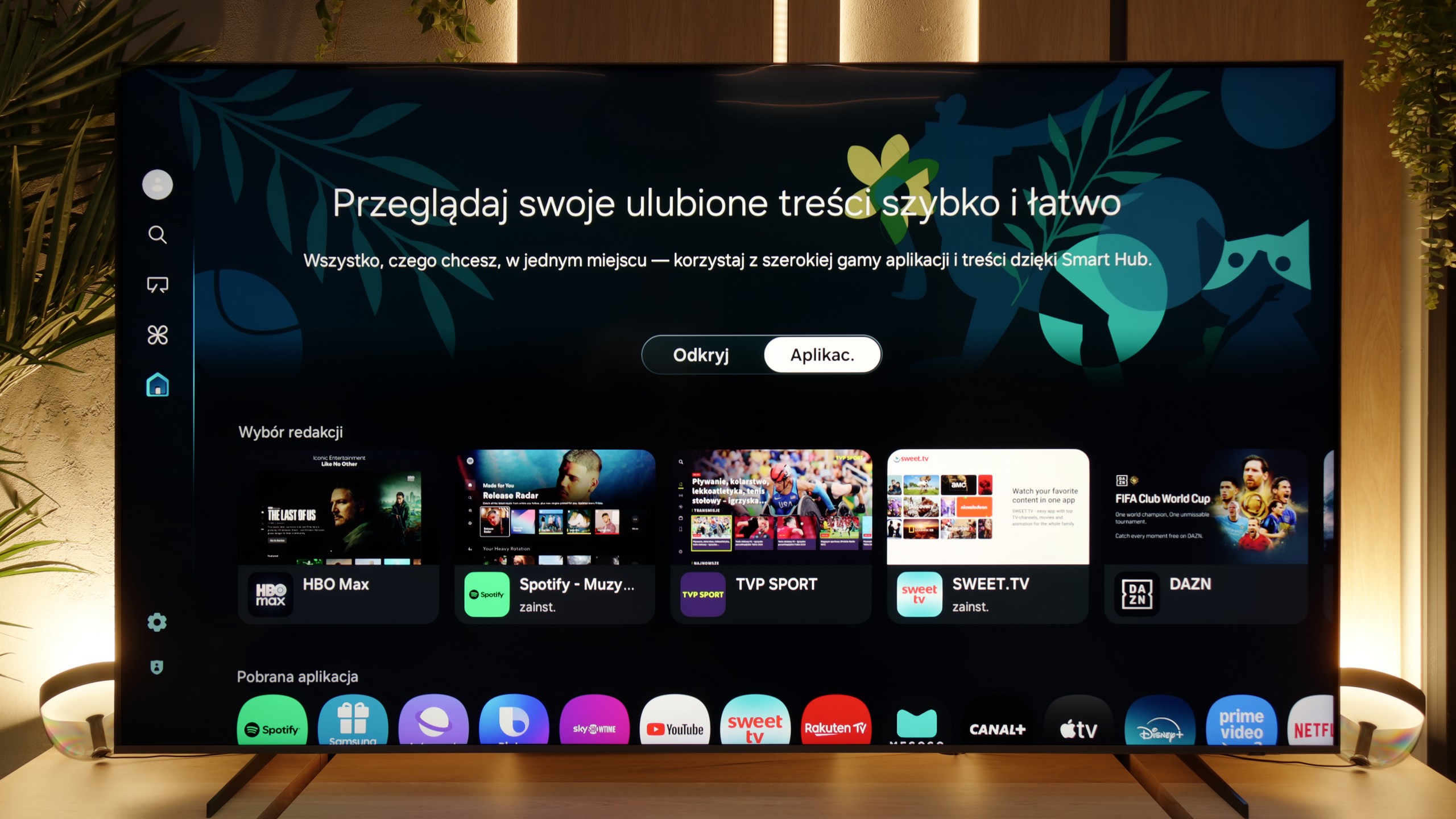
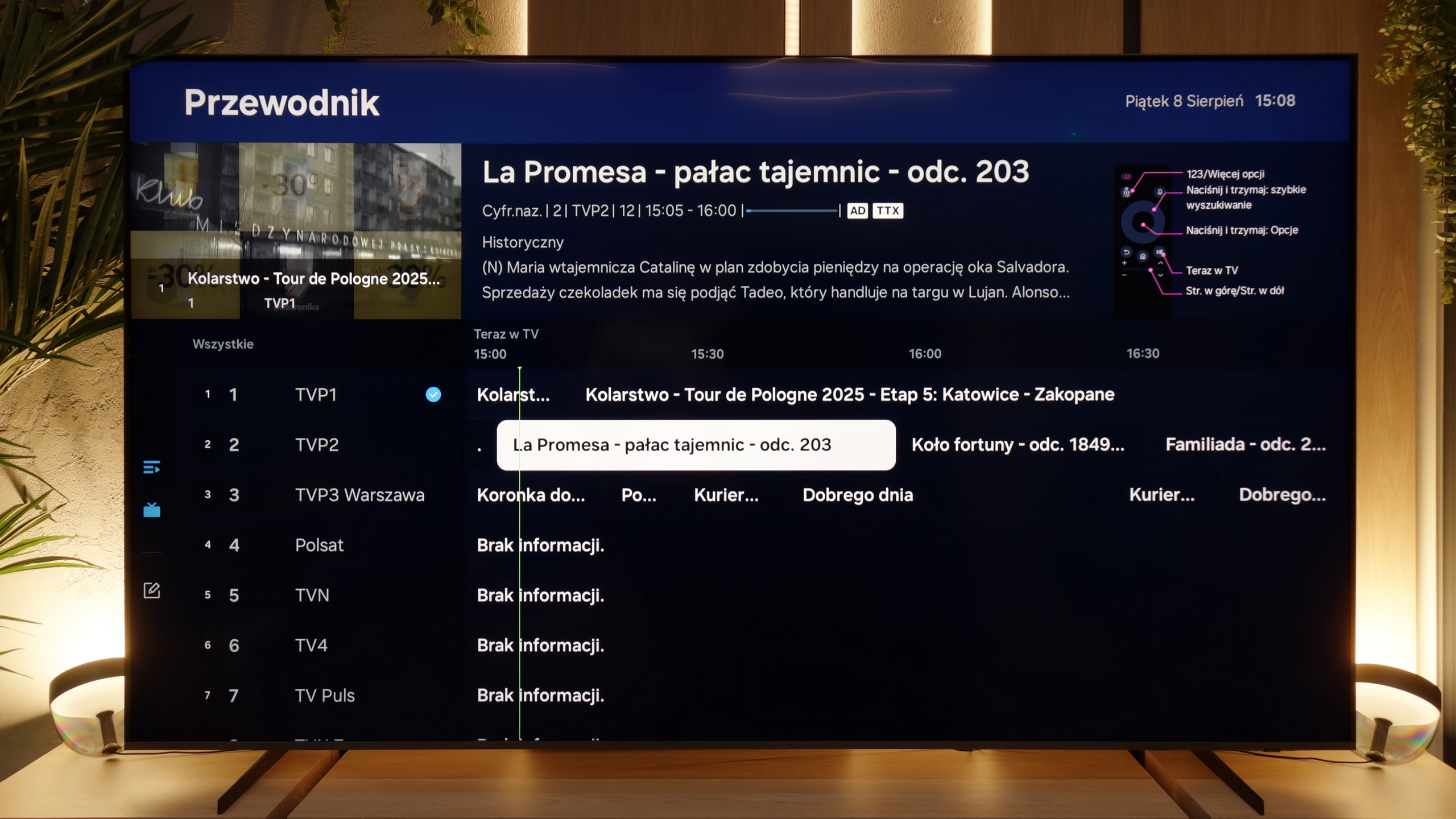
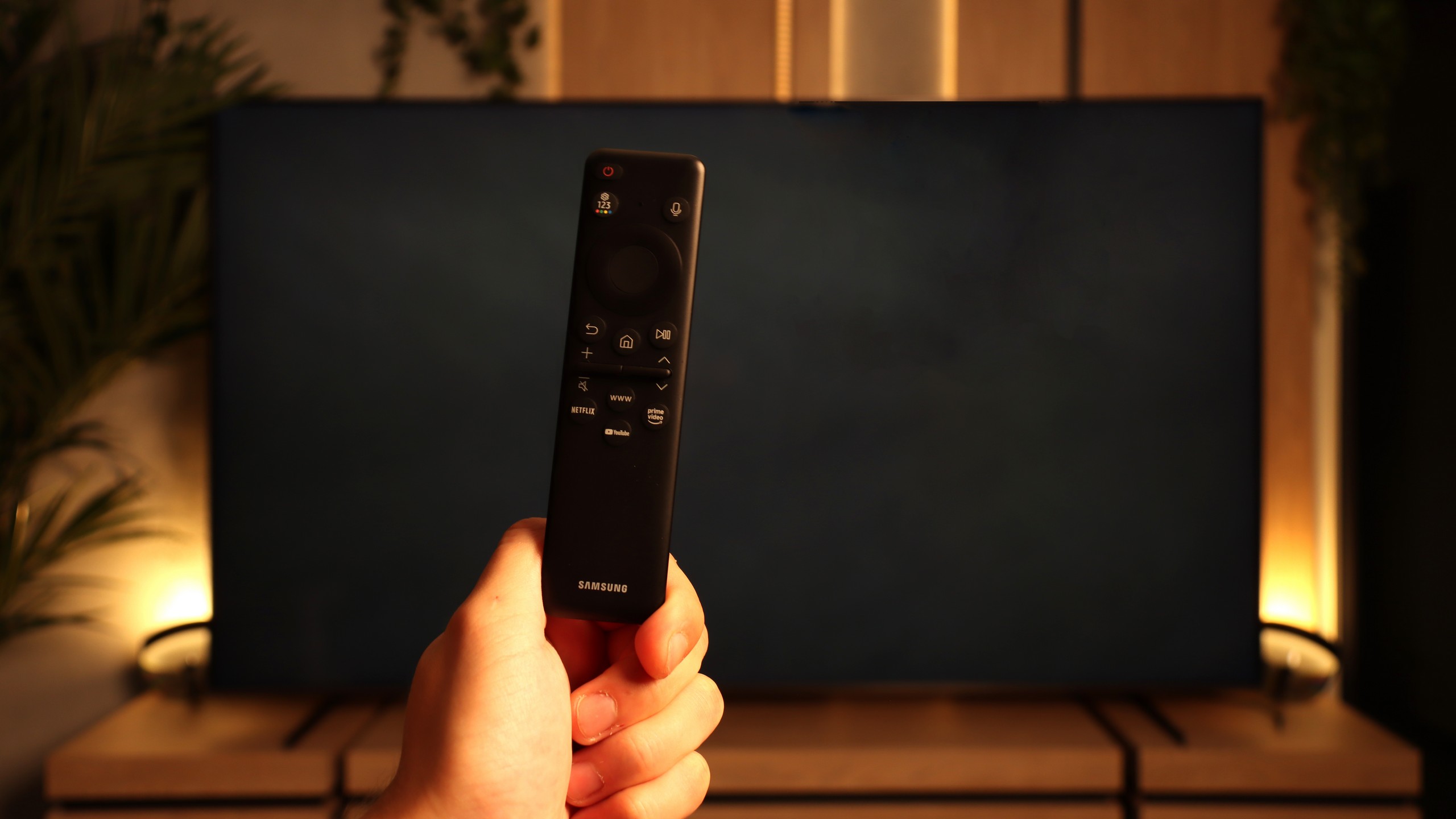
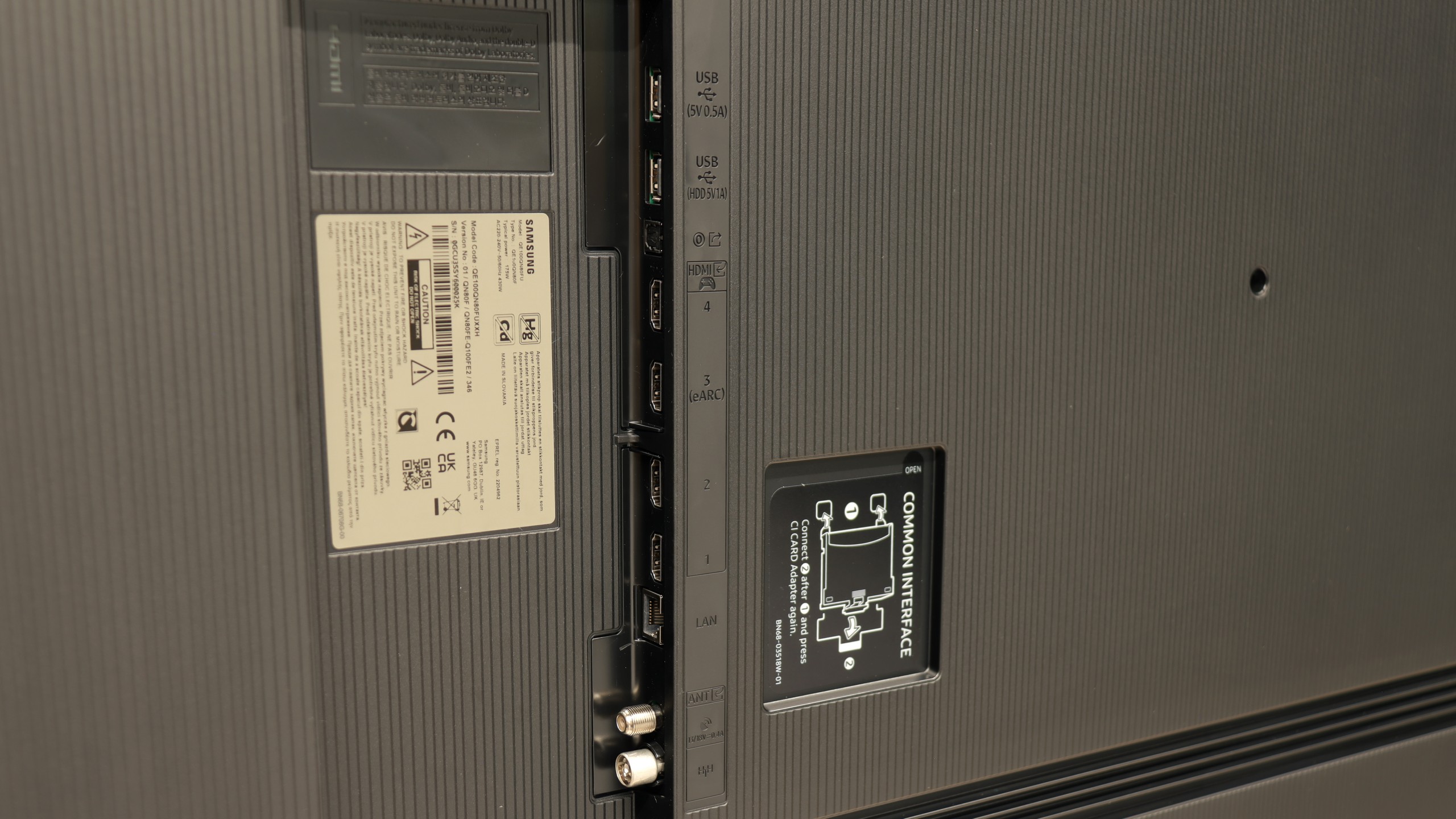
Multimedia Features: Google TV
The strongest user aspect of the TCL C6K is undoubtedly the Google TV system. It gives the television character and provides it with an edge over many competitors. We have a full suite of services here – from support for popular streaming applications, to screen mirroring, all the way to AirPlay, which also makes iPhone users feel at home. In addition, there is Google Assistant (recently in the Gemini AI version), which not only answers questions but also performs simple commands efficiently, e.g., changing channels or searching for content on VOD services. The system itself works quite responsively, although it must be noted that there is a certain drawback – the awkward translations in the Polish menu can evoke a smile, but sometimes require a moment of thought to decipher what is really meant.
Classic Features
When it comes to classic television features, the TCL C6K is rather average. There is no USB recording or PiP mode, which may be disappointing for some. However, the manufacturer did not forget the basics – teletext TV and a clear EPG are available, which still matter to some users. In everyday use, the support for external audio devices via Bluetooth also comes in handy – a simple way to connect a speaker or headphones, which can be a practical solution for seniors. Beyond that, it is difficult to find elements that would distinguish the C6K from its competitors – it is simply a solid, but standard package of basic functions.
SmartTV Features: Tizen
When it comes to smart TVs, the QN80F has a lot to brag about. Samsung relies on Tizen, and it's clear that this system has been refined over the years. All the major streaming apps are available, voice search works, and AirPlay and Miracast are supported, so there are no issues streaming content from your phone or laptop. What's most interesting is that the TV can integrate other devices in the home into its ecosystem – thanks to SmartThings and support for the Matter standard, you can connect light bulbs, robot vacuums, and even devices from other brands. In practice, the QN80F becomes not just a screen for movies, but also a convenient control center for the entire apartment. Of course, it is still a closed system, so a few less popular apps might be missing, but let's face it – for 99% of users, it has everything they need and even more.
Classic Features
The traditional features on the QN80F perform quite well, although a few things are missing. On the plus side, there's PiP, or picture-in-picture – a rarely found feature that can still be very practical. Additionally, we have EPG, working teletext, and Bluetooth support, which makes it easy to pair headphones or a soundbar. On the flip side, there's no USB recording from the built-in tuners, and it lacks a remote with a classic numerical keypad. Instead, we get Samsung's characteristic small remote, which may initially seem too minimalist. However, it must be acknowledged that this unassuming gadget hides a lot of capabilities and can control other devices, such as satellite receivers, consoles, or Blu-ray players, so in practice, one remote is enough to manage the entire setup in the living room.
Playing files from USB
8.9/10
9/10
Supported photo formats:
Maximum photo resolution:
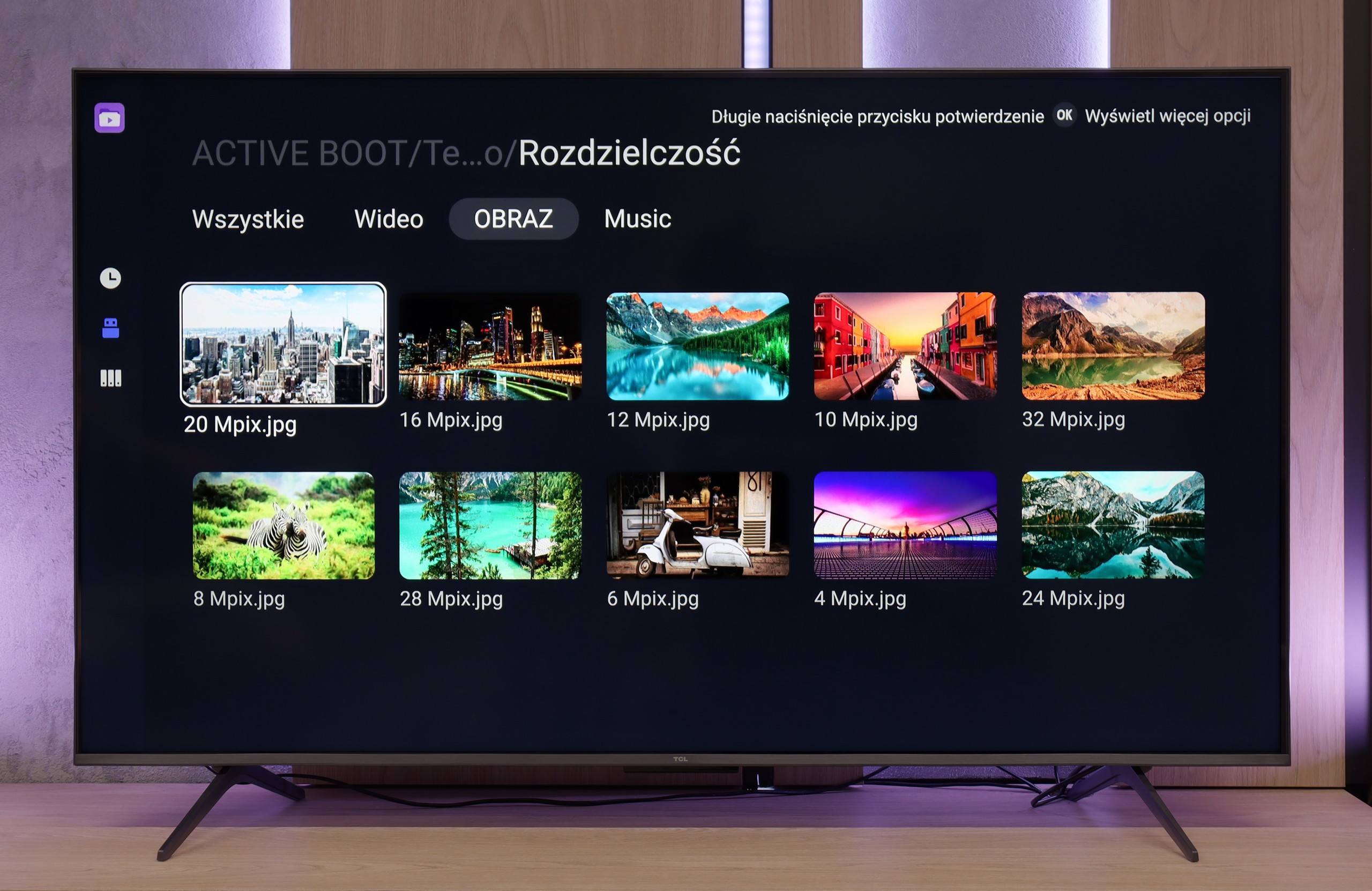
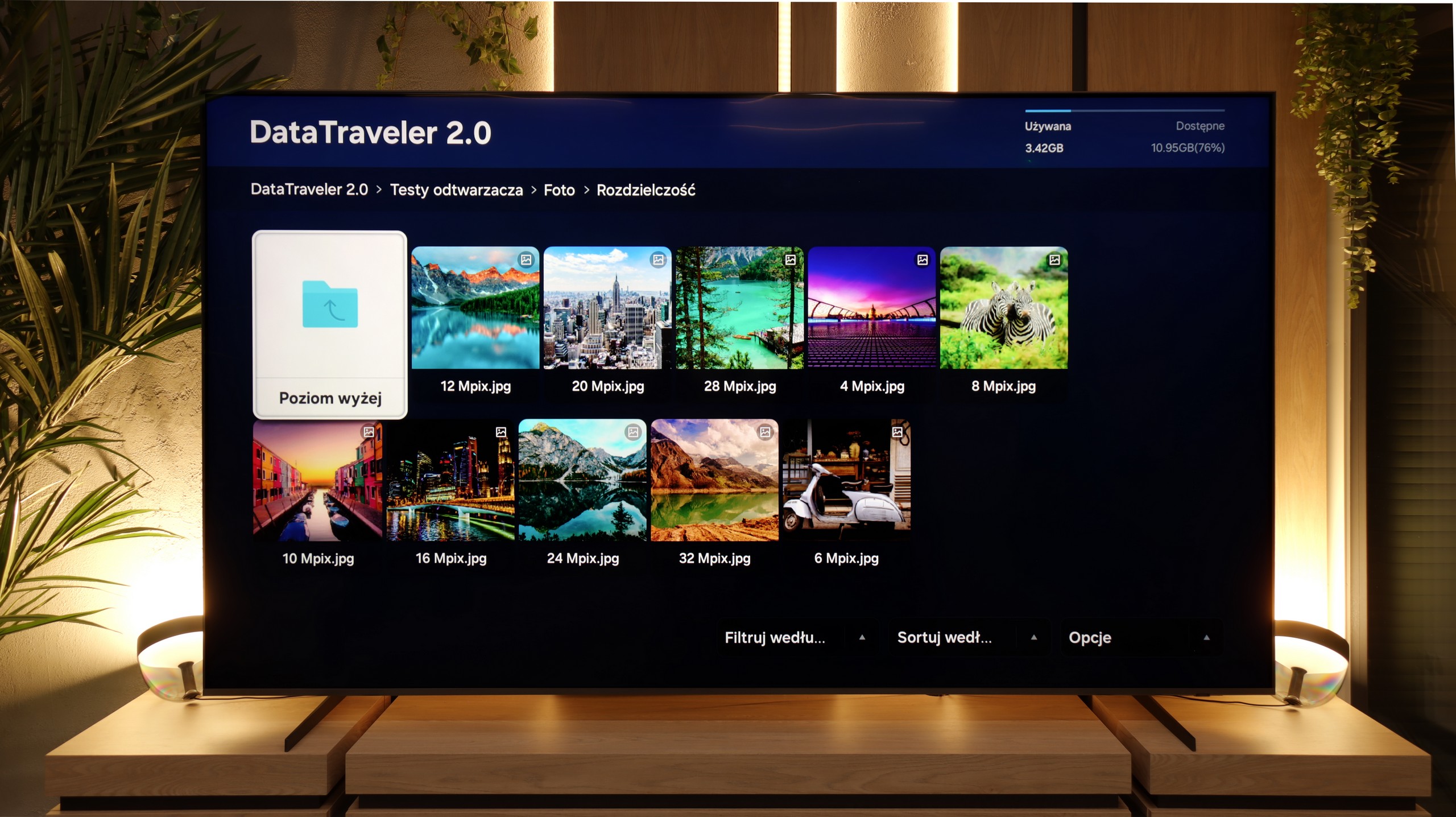
The built-in media player in the TCL C6K performs really well – practically all popular file formats work without major issues. There are, of course, minor exceptions, especially with less common codecs or atypical video file configurations, but in everyday use, this is rarely noticeable. The biggest advantage, however, is that the TV runs on Google TV, which provides full freedom in choosing additional software. If someone encounters a file that the standard player cannot handle, it is enough to install an alternative – such as VLC – and the problem disappears.
The built-in media player in the QN80F performs quite decently, but it's hard to say it's fully extravagant. It handles movies quite well – it can easily play popular video formats, from simple MP4s to heavier containers. It's not at the level of all-in-one applications like VLC, but it's sufficient for everyday viewing. Especially since the last update fixed the issue with handling various subtitle formats in movies. The situation with photos is a bit worse. Support essentially ends at JPG and BMP, so if someone keeps their photo archive in another format, they have to rely on an additional application or will be forced to convert the photos.
Apps
9.6/10
8.7/10














































Sound
6.5/10
6.7/10
- Maximum volume-87dB
- Dolby Digital Plus 7.1
- Dolby True HD 7.1
- Dolby Atmos in Dolby Digital Plus (JOC)
- Dolby Atmos in Dolby True HD
- DTS:X in DTS-HD MA
- DTS-HD Master Audio
In terms of audio, the TCL C6K performs quite well. The manufacturer has been boasting about its collaboration with the Onkyo brand for several years, and it indeed reflects in the sound quality. The audio is pleasant, with clear mids and quite a clean high end, and the whole sound gives the impression of being well balanced. Of course, this will not replace a full-fledged soundbar, especially in terms of bass depth, but for built-in speakers in a TV from this price segment – it's really very good.
The QN80F performs well on its own – with a slight bass, some space thanks to Dolby Atmos, and clear enough that daily watching of movies or series isn't exhausting. But with a 100-inch screen, it practically begs for a soundbar. Only then will the scale of the image and sound begin to match, as while the television does a decent job, it's hard to expect built-in speakers to fill such a large living room with sound.
Acoustic Measurements
No acoustic data
87dBC (Max)
75dBC


